Annual Report
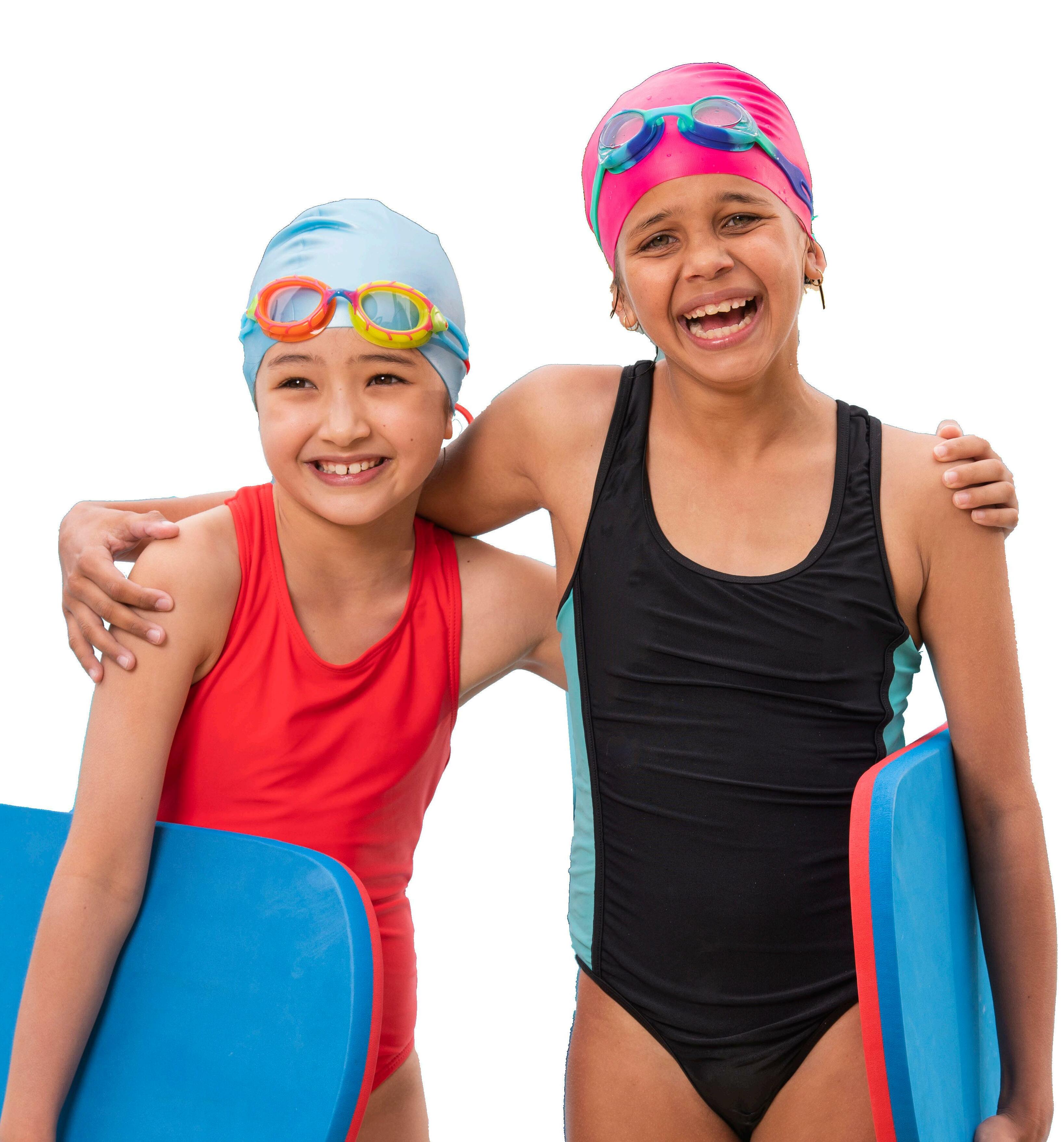




2021/22 A water-loving nation



2 04 Message from the President 05 Message from the Chief Executive Officer 06 Royal Life Saving Strategic Framework 08 Royal Life Saving Reconciliation Action Plan OUR IMPACT 10 Drowning Prevention Leadership 18 Research, Policy and Advocacy 28 Community Awareness and Action 42 Swimming, Lifesaving, Water Safety Pathway 58 Safer Aquatic Locations 68 Organisational Cohesion and Growth 76 People and Culture 79 Honours and Awards 82 Governance 85 Financial Summary 86 Our Partners OUR VISION OUR PURPOSE OUR VALUES CONTENTS A water-loving nation free from drowning. To lead efforts to reduce drowning and increase swimming, water safety and lifesaving skills. • Leadership, C ollaboration and Integrity • Humanitarianism and Social Entrepreneurship • Quality and Innovation • Diversity, Equality and Respect ACKNOWLEDGEMENT OF COUNTRY Royal Life Saving Society – Australia acknowledges the Aboriginal and Torres Strait Islander people of this nation. We pay our respects to their Elders past, present and emerging recognising their continued connection to land, waters and communities.

I have great pride in presenting this year’s Royal Life Saving Society – Australia Annual Report, my first as President. This continues my involvement with the Society, which traces back to my days as a young pool lifesaver in the Sutherland Shire, NSW. It is also gives me great pride to be elected as the organisations first Independent Chair, a significant responsibility and privilege.
I pass on my gratitude to Cameron Eglington who was an excellent President for three years during the tumultuous pandemic period, and who retired from the Board to continue his passion for Indigenous education and leadership development.
I would like to acknowledge the passing of Queen Elizabeth II, who was the Royal Life Saving Society Patron for her seventy-year reign. Professor Pearn summed up Her Majesty best in saying that her service was an inspiration and example to us all. We welcome His Majesty King Charles IV and look forward to continuing to work with members across the Commonwealth to reduce drowning.
This report celebrates the deep commitment to community service of Royal Life Saving Members, volunteers, and staff across the country, as they work toward our vision of a nation free from drowning. I am constantly impressed by the quality and enthusiasm of lifesaving people across Australia.
The highlight of my year was having the opportunity to travel around and meet with lifesavers across the country. I was fortunate enough to attend the Royal Life Saving Northern Territory Honours and Awards Night at Government House in Darwin, sharing the excitement, surprise, and pride on the faces of so many receiving Royal Life Saving honours.
The event host, Her Honour the Honourable Vicki O’Halloran AO, Administrator of the Northern Territory spoke so highly of their collective contribution. These sentiments have been shared across functions and meetings I have attended including the annual awards functions in Victoria and meetings in Western Australia. The overriding theme of passion and commitment towards community service is the backbone of our organisation and cannot be celebrated enough.
This report highlights the hard work and achievements across the society including:
Reconciliation Action Plan
I welcome the development of our Reconciliation Action Plan. Our ambition is to continue partnerships that actively engage and encourage Aboriginal and Torres Strait Islander communities to access, design, participate in, and lead water safety programs for safety, fun and employment. We are only at the beginning of our journey in partnership with communities and look forward to continued partnership as we move through the important stages of reconciliation.
Summer Water Safety campaign
Royal Life Saving has a reputation for quality water safety campaigns, that are always well designed, and targeted. The Summer Safety campaign is a prime example that provided resources that the whole organisation, industry, partners, and MPs could get behind across summer. This is so critical, especially given the spikes in drowning over recent summers, and the significant impact of flooding on communities across Australia. We continue to focus on the promotion of child drowning prevention through Keep Watch and our multicultural campaigns.
Social Impact of the Aquatic Industry
I have such fond memories of my local swimming pool where I spent a lot of my youth, so I am pleased to see that we continue to advocate the health, social and economic impacts of aquatic centres. Pools contribute so much to community life, and they need our support to ensure they bounce back from some challenging years.

Australian Pool Lifesaving Championships
After several years of cancellations, I was pleased to see the excitement on the faces of so many officials, competitors and parents who were reconnecting with both the sport and cherished friends. We look forward to seeing you all in Melbourne, January 2023.
Thank you
Our work in drowning prevention and water safety is only made possible by the passion and professionalism of our volunteers, employees, board members, casual trainers, officials and other key stakeholders across all States and Territories. I thank them for all that they do. I’d like to extend my appreciation to the Finance and Audit Committee. I also wish to thank my fellow board directors for their continued guidance and support.
Thank you to the national office team, including our Chief Executive Officer Justin Scarr, and to Belinda Lawton and Monique Sharp for compiling this report and Linda Luu for compiling the financial statements.
I look forward to continuing to support Members, volunteers, and staff as we pursue our objective of a water loving nation free from drowning.
DR MITCH HARTMAN
National President
Royal Life Saving Society – Australia
4
MESSAGE FROM THE PRESIDENT
MESSAGE
There are two ways to look at the past year. Firstly, as a year of challenges. A summer impacted by COVID-19 and floods. Significant staff shortages across industry. The highest number of drowning deaths since 1996. But let’s look past those challenges and celebrate a year of resilience, achievements, and optimism.
Campaigning for fun and safety
We celebrate campaigns like Summer Water Safety, We Swim, Keep Watch, Make the Right Call and multicultural water safety, which all balanced the need to prevent drowning with promoting our love of water, and desire to encourage everyone to enjoy it safely.
An increased emphasis on digital marketing has aimed to reach people where they recreate or within their communities. This supports our traditional approaches to media and our website.
Australian Water Safety Summit
The Australian Water Safety Summit, hosted with colleagues Surf Life Saving, was a great success. More than 200 people attended eager to re-align and re-engage in support of the Australian Water Safety Strategy 2030. The overwhelming feedback was ‘thank you’, mostly for the opportunity to reconnect without a mute button. We continue to encourage all partners to align efforts to the goal of reducing drowning rates by a further 50 per cent by 2030.
Local Water Safety Plans
We have increased our emphasis on local water safety coordination and planning. A great example is the Townsville Water Safety Plan, which bought together local stakeholders in a series of workshops. We are determined to play the facilitation role, and to design processes where the important and sometimes overlooked issues are addressed.
Research and advocacy
We again published some great research targeted at areas of the Australian Water Safety Strategy 2030, including a National Drowning Report, Summer Drowning Toll, and a report on non-fatal drowning. Another was a study investigating drowning in school-aged children. We have started to see drowning increasing in this age group. It is essential that we advocate to ensure no-one misses out on lessons.
New resources
We developed new online modules in important areas including Child Safety and Teaching People on the Autism Spectrum. We updated our resources, including planning e-books.
In Swim and Survive’s 40th year, we rolled out celebrations and new resources including online programs for children, and instructional support for teachers.
National Aquatic Industry
During this difficult time for the aquatics industry, we thank the National Aquatic Industry Committee for their ongoing efforts. The Guidelines for Safe Pool Operation continue to be a much-valued resource and the committee’s work to ensure they are consistently updated to reflect emerging needs is appreciated.
Partnerships
We acknowledge the support of the Australian Government, for which we are extremely grateful. I welcome the new Minister for Sport, the Hon Anika Wells MP, and thank her for Government’s strong commitment to keeping Australians safe around the water.
We thank Protector Aluminium and Architects Choice, a valued corporate partner, for their supports of our Keep Watch campaign to keep young children safe around water and helping to fund child drowning research.
Thank you
We’d like to thank the national team for their very substantial achievements throughout the year. Thank you to our national advisers, Prof John Pearn AO RFD (Medical/Research), Dr Shayne Baker OAM (Education and Training) and Geoff Grey (Sport).
We wish to thank our President, Dr Mitch Hartman, and all members of the Board for their leadership and support. We thank the Finance and Audit Committee, Honours Committee, and the CEOs and staff of our members for their commitment to our mission.
JUSTIN SCARR Chief Executive Officer Royal Life Saving Society - Australia
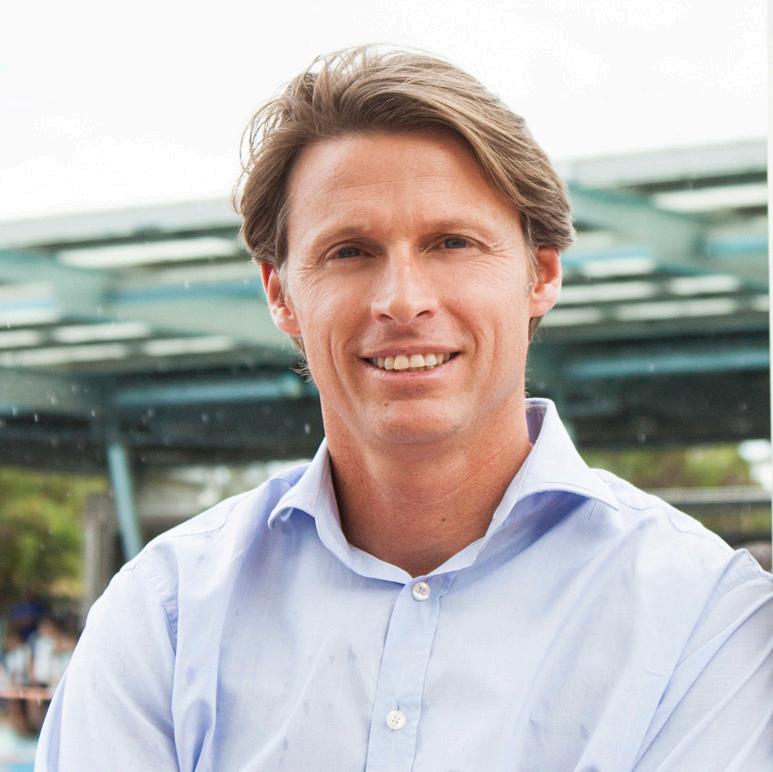
5
FROM THE CHIEF EXECUTIVE OFFICER
Strategic Framework
Over the past century our vision has remained the same. We have always sought to reduce drowning, increase physical activity, especially in and around the water, and contribute to the creation of more resilient communities, Australia wide. Achieving these long term goals requires a deliberate effort to promote change.
This change is best identified as:
Shifts in our knowledge and advances in the evidence base
Newly developed and adjusted policies that impact drowning prevention or that promote water safety
Increases in community water safety awareness and education
Increased adoption of the risk management systems that make aquatic environments safer


Shifts in individual and community behaviours, particularly among those at greatest risk
We focus on eight priority areas:
Drowning prevention leadership Research, policy and advocacy
Community awareness and action
Swimming, lifesaving, water safety pathway
Safer aquatic locations
Drowning prevention leadership abroad
Organisational cohesion and growth
People and culture
Organisational Cohesion & Growth
Research Policy & Advocacy Community Awareness & Action
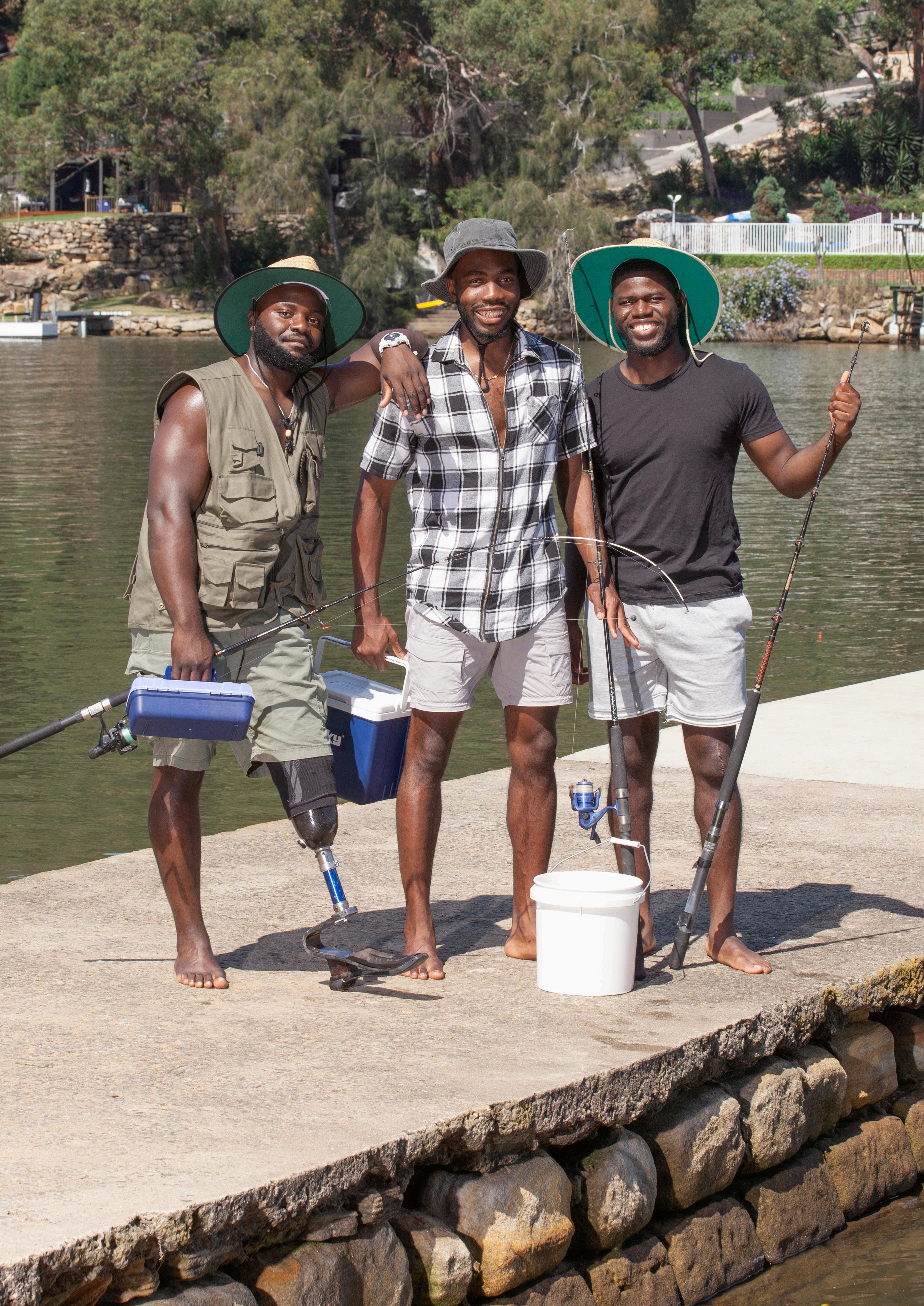


Reconciliation Action Plan
Royal Life Saving Society – Australia is proud to launch our first Reconciliation Action Plan, taking the challenge to learn, listen and commit to reconciliation with our First Nations people.
Royal Life Saving acknowledges the Traditional Owners of our national office in Ultimo, Sydney are the Gadigal people of the Eora nation. We pay our respects to Australia’s First Nations cultural and spiritual connections to water, and acknowledge the land where we work, live, and play always was and always will be Aboriginal land.
Based around the core pillars of relationships, respect and opportunities, Reconciliation Action Plans provide tangible and substantive benefits for Aboriginal and Torres Strait Islander peoples, increasing economic equity and supporting First Nations self-determination.
Our Reconciliation Action Plan marks the start of our formal journey that we hope will contribute to positive contributions across Australia. We look forward to learning from our successes and failures and seeing the outcomes that come from this journey.
The rivers, lakes, pools, billabongs and dams in Australia bring life to communities. They are places for play, social connection, and recreation. They can also be spaces of danger and tragedy. We note the long-term lifesaving skills of coastal and freshwater nations.
Those skills helped to keep communities safe in seasons of floods and cyclones. Our ambition is to continue partnerships that actively engage and encourage Aboriginal and Torres Strait Islander communities to access, design, participate in, and lead water safety programs for safety, fun and employment.
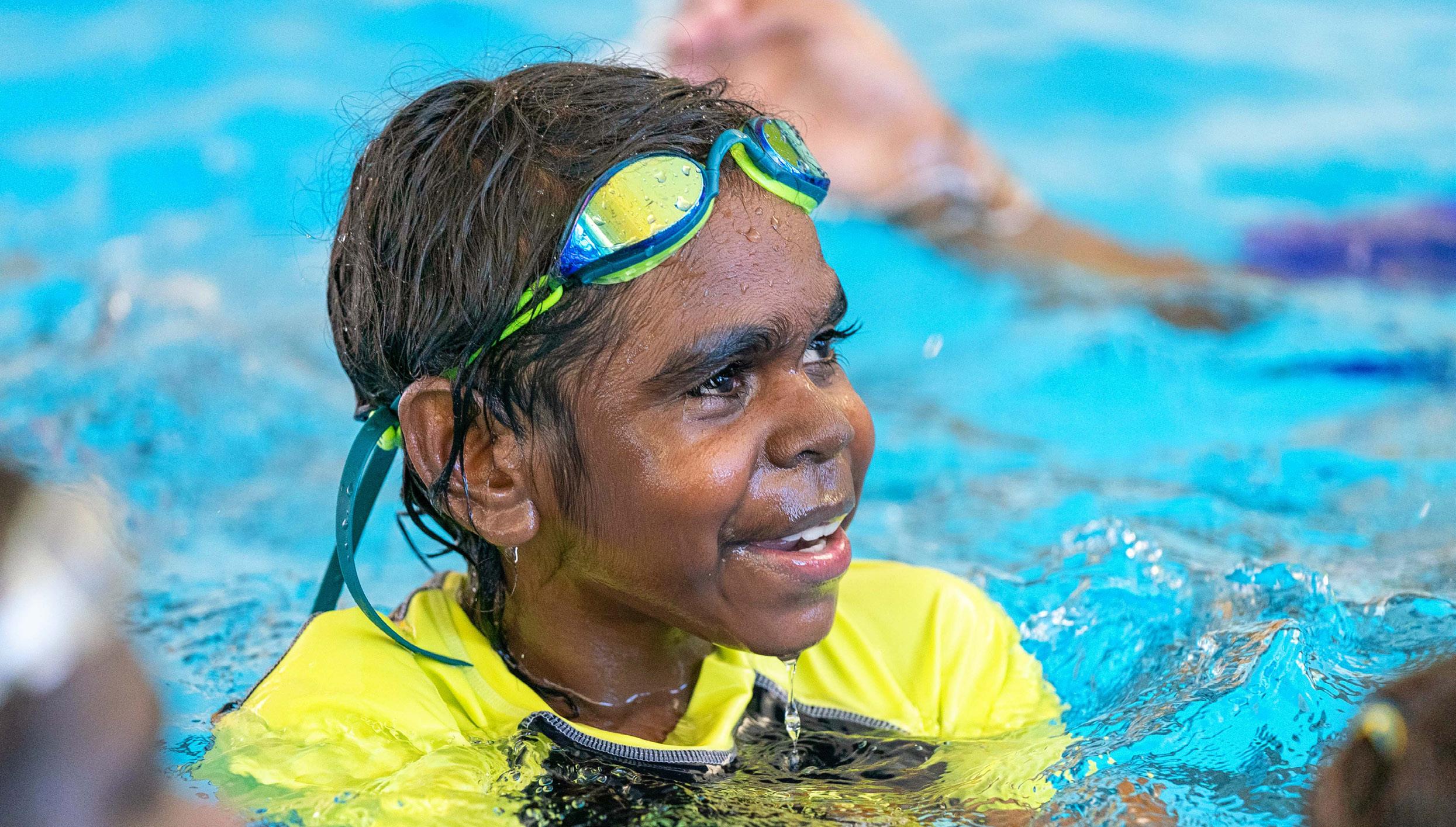
As part of our Reconciliation Action Plan, Royal Life Saving is committed to the principles of relationships, respect, and opportunities. We celebrate the resilience, survival, wisdom, deep connection to water and land that continues in Aboriginal and Torres Strait Islander cultures and communities.
Royal Life Saving thanks Reconciliation Australia, Murawin Consultants and Sahba Delshad for guiding us through this process. The national office joins our colleagues at Royal Life Saving Society - Western Australia, who are two years into their Reconciliation Action Plan.
VIEW THE RECONCILIATION ACTION PLAN
royallifesaving.com.au/reconciliationactionplan

8
Symbolising our reconciliation journey
Water Journey
Water Journey is a representation of Royal Life Saving - Australia’s connection with Aboriginal culture and the journey towards its future of reconciliation. The centre of the artwork represents the Royal Life Saving Australia’s connection and commitment to its reconciliation journey.
The symbols surrounding the centre signify the coming together of people and the water lines and fish represent the connection to water and safety. The dotted symbols along the journey pathway represent the values and priority areas of Royal Life Saving Australia’s mission.
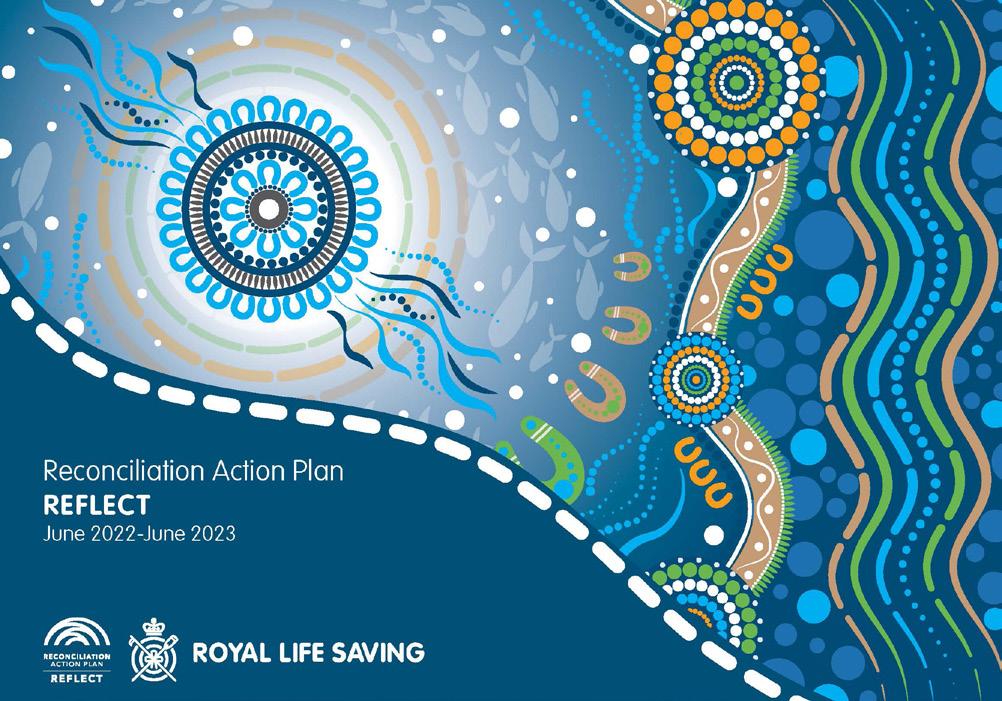
The people along the journey pathways represent members, board, staff, volunteers and partners. The dots represent connection to the land, waters and communities. The waves on the right side of the artwork represent water safety and life saving skills.
The reconciliation journey is reflected throughout the piece. The pathways signify the establishment and connection with Aboriginal and Torres Strait Islander peoples and the commitment to actively promote awareness of their peoples and cultures.

Inland Waterways

Water is Life. The human body is comprised of more than sixty per cent water. We cannot live without water and need to regularly drink it. Water washes and cleanses, both physically and spiritually. As humans, we wash and play in water, sail and surf upon it, fish in it and boat upon it in all its stillness as well as its churning waterfalls. Huge varieties of birds float upon it, breed and feed in it. Water can sustain life but also take it.
Australia’s Aboriginal peoples have lived in harmony with this country for at least 60,000 years. Whether they live near the sea or inland, they frequently describe themselves as being either ‘saltwater’ or ‘freshwater’ people. Aboriginal people have always depended upon water to survive by drinking and eating from it. They understand that the inland waterways are sacred sustainers and providers of life.
My painting ‘Inland Waterways’ endeavours to communicate the Aboriginal belief that water is sacred and should be respected. The central gold circle represents the Creator Spirit. The outward radiating and spiralling lines represent the flow of water from the Spirit, spreading, supporting and creating physical and spiritual life across Country. The various different sized circles represent lakes, billabongs, ponds and dams filled by rivers and creeks.
About the artist
Lani Balzan is a proud Aboriginal woman from the Wiradjuri people of the three-river tribe. Her family originates from Mudgee but she grew up all over Australia and lived in many different towns. She now calls the Illawarra home. One of her biggest goals and inspirations with creating her artwork is to develop a better connection to her culture and to continue to work towards reconciliation; bringing people and communities together to learn about what amazing culture we have here in Australia.
About the artist
Chris Beal is of Australian Indigenous descent, Murri on his mother’s side from Townsville and Worimi on his father’s side from Newcastle. Having lived in five Australian states, Chris’s experiences of the diversity and richness of the Australian landscape inform his painting. Chris now lives by the water in regional NSW in Forster, which is Worimi Country.
Learn about the artwork and Chris Beal: youtube.com/RoyalLifeSavingAust
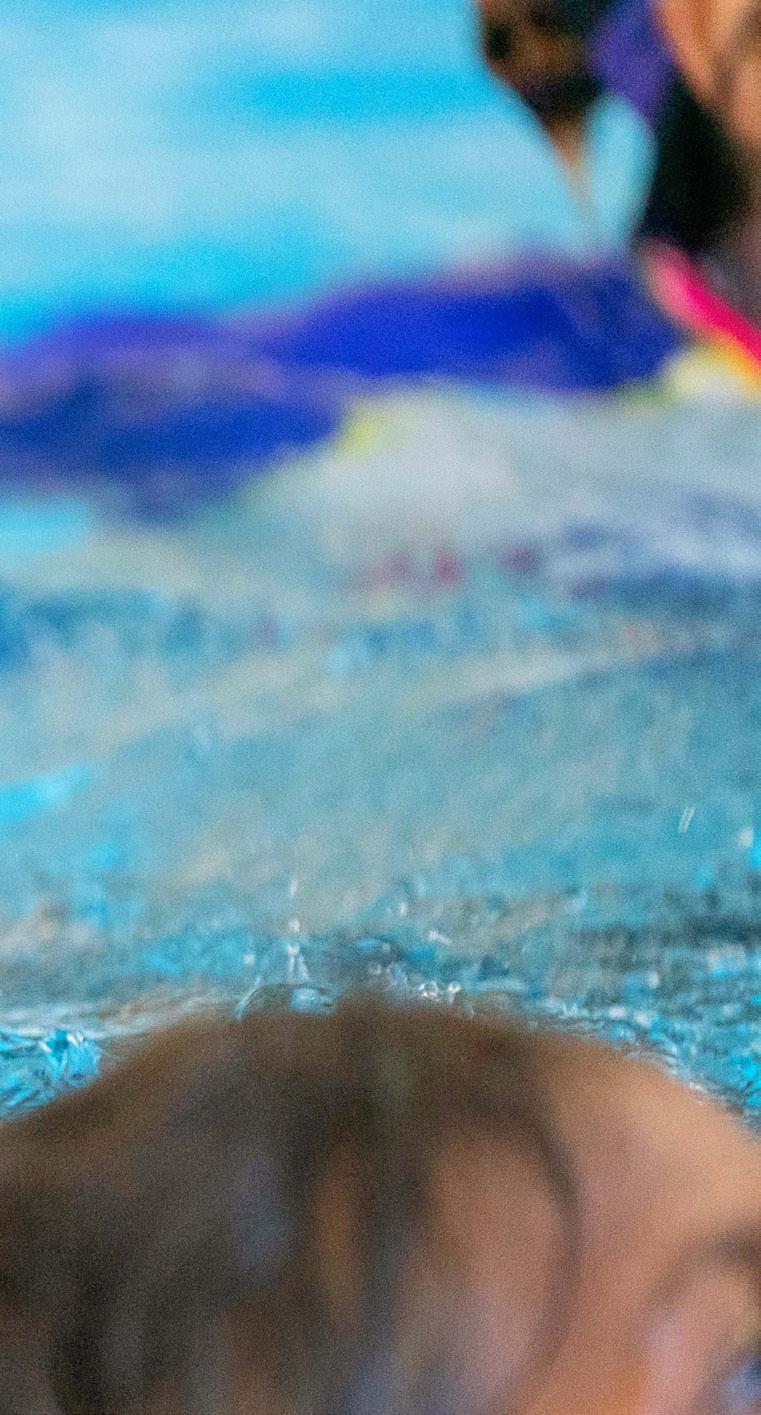
9
Drowning Prevention Leadership
Royal Life Saving has a resolute focus to do its bit - and encourage others to do theirs - to achieve the Australian Water Safety Strategy 2030 goal of reducing drowning deaths in Australia.
KEY ACHIEVEMENTS
Facilitation of the National Water Safety Summit 2022 Stewardship of the Australian Water Safety Council
Launch of our Reconciliation Action Plan
Establishing watersafety.com.au to promote Australian Water Safety Strategy 2030
Release of the 2021-22 National Drowning Report Facilitating the Townsville and Surrounds Local Water Safety Strategy
Commemorating World Drowning Prevention Day Researching the emergence of global drowning prevention

Celebrating women in global drowning prevention Contributing to the World Health Organization’s Preventing Drowning Guidelines
Royal Life Saving Staff and Advisers are actively involved in:
• Australia NZ Safe Boating Education Group
• Australian Public Health Association
• Australian Resuscitation Council
• Australian Standards
various committees
• Australian Water Safety Council
• Australasia Injury Prevention Network

• AUSTSWIM
• Diversity Council of Australia
• First Aid Industry Reference Committee
• Health Promotion Association of Australia

• International Association for Sports and Leisure Facilities

• International Life Saving Federation
• Parks and Leisure Australia
• Parks and Leisure NSW/ACT
• Royal Life Saving Society Commonwealth
• Sport and Recreation Industry Reference Committee
• Welcoming Australia
• World Health Organization
10
–

More than 200 water safety experts from across Australia and New Zealand came together for the National Water Safety Summit 2022 which was an opportunity to refocus attention on drowning prevention and the joy of swimming.
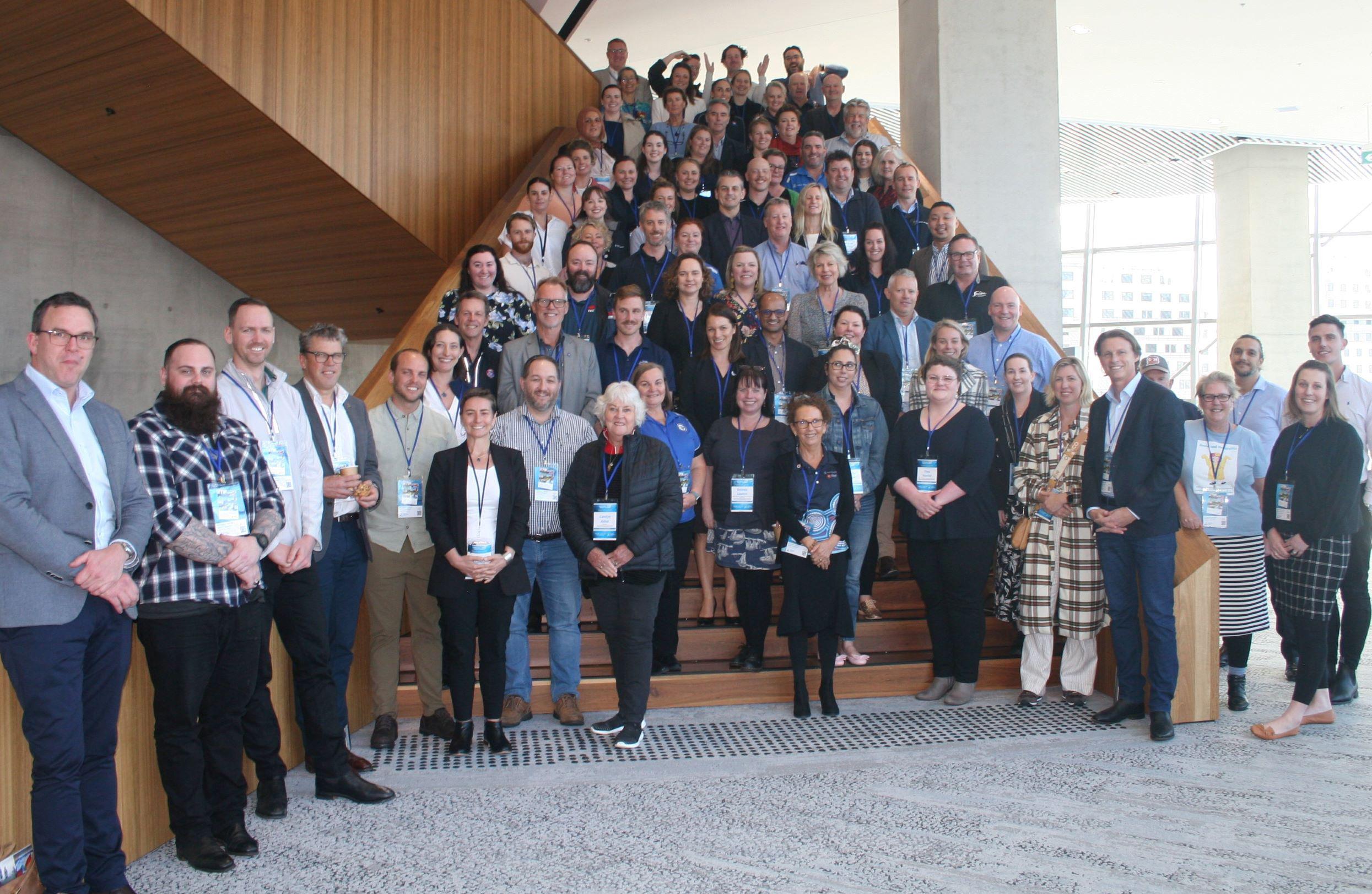
The Summit, which was led by Royal Life Saving Society – Australia and Surf Life Saving Australia, was designed around the key at-risk groups identified in the Australian Water Safety Strategy 2030.
Over two days of intense discussion, the key themes that emerged were prevention, collaboration, co-design, and the value of sharing stories. Across the conference, many smaller organisations had the opportunity to learn from each other and share their experiences.
One of the most inspiring presentations came from Gulidjan girl Piper Stewart, who at just 12 founded the Bambigi Indigenous swimming program after recognising many of her Indigenous peers hadn’t learned to swim because of financial barriers. Bambigi means “to swim” in Wiradjuri, Griffith’s traditional Aboriginal language. More than 300 children from the region around Griffith in NSW have now benefited from the program.
There were sombre moments as we heard from families and friends who had lost loved ones to drowning, both in immediately fatal incidents, and non-fatal drowning where children survived the initial incident with lifelong disability and significantly shorted lifespan. We remember and honour their loss. It was a powerful reminder of why water safety is so important.
The program also focused on accessibility and heard about some terrific initiatives to make safe places to swim accessible to everyone, with investment into harbour and river swimming locations.
The aquatic industry was well represented, with discussions about their social, economic and health benefits and their role as hubs for communities. There are more than 1300 publicly owned aquatic facilities in Australia contributing to physical activity levels and water safety education.
Photo: National Water Safety Summit 2022 participants.
12 NATIONAL WATER SAFETY SUMMIT
Core issues of concern raised included the effects of COVID-19 on children learning to swim, and the ongoing workforce pressures after many young people were forced to leave the industry over the past two years. Swim schools are reporting significant wait times for learn-to-swim classes, as they struggle to recruit swimming and water safety teachers.
It was also an opportunity for those in government with responsibility for swimming and water safety to come together and discuss how different states and territories are tackling the problem of getting children who missed out during COVID-19 back into water safety.
Researchers from leading universities and the peak water safety bodies presented on new and ongoing research projects, including looking at the factors which disrupted active supervision of children, leading to drowning deaths.
NEW AUSTRALIAN WATER SAFETY COUNCIL WEBSITE
A new interactive website which will link community water safety efforts across the country has been launched to highlight the efforts of communities large and small across the nation.
The Australian Water Safety Council designed the website watersafety.com.au to connect community groups working to prevent drowning though a variety of water safety initiatives.
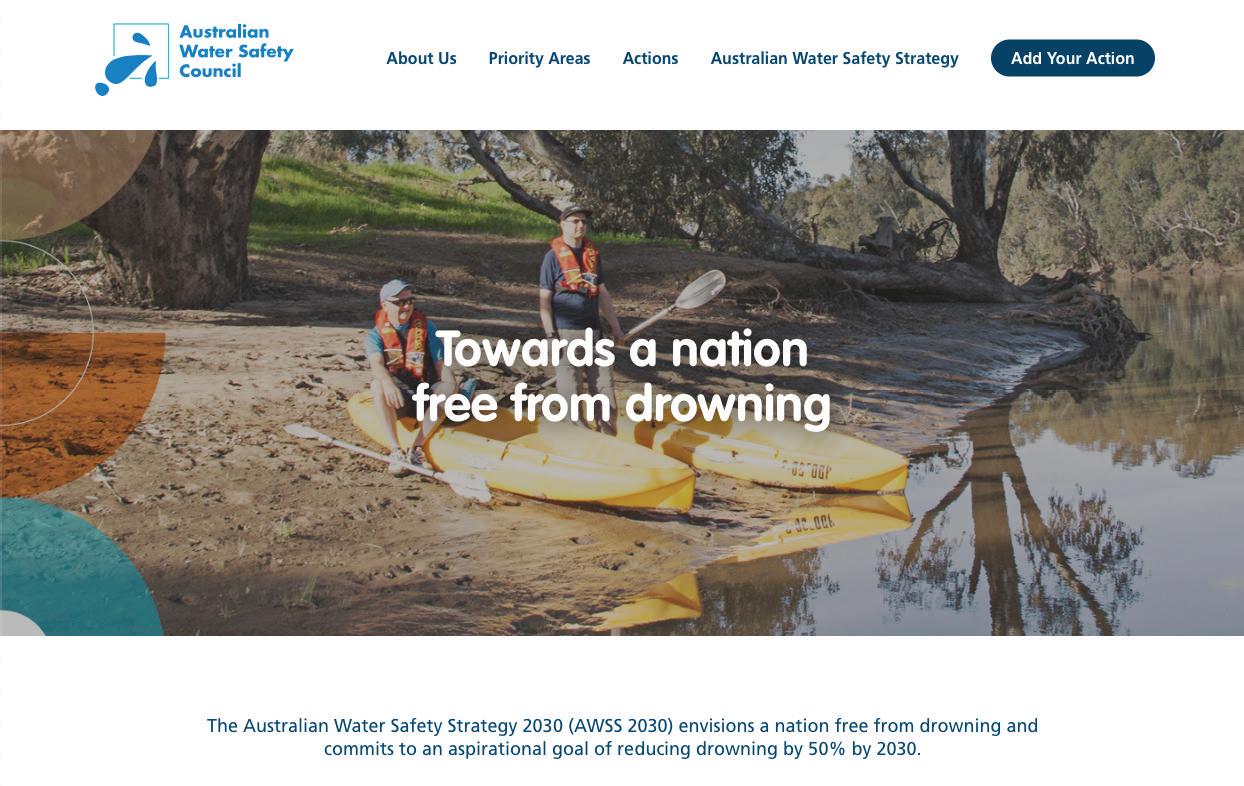
Convenor of the Australian Water Safety Council and Chief Executive Officer of Royal Life Saving SocietyAustralia, Justin Scarr said the website recognises that targeted, local community action is an important part of efforts to prevent drowning.
“The Australian Water Safety Strategy 2030 promotes local approaches to water safety and drowning prevention. This means policies, programs, services and campaigns tailored to local conditions and in partnership with community groups, councils and local businesses,” Mr Scarr said.
“All drowning is local. We recognise that the biggest impacts are borne by families, rescuers and those living where the incident happens.”
“So, we are encouraging local groups to commit to the Australian Water Safety Strategy 2030, to feature what they are doing to make a difference or to promote water safety. The website is a chance to highlight and encourage meaningful partnerships at all levels.”
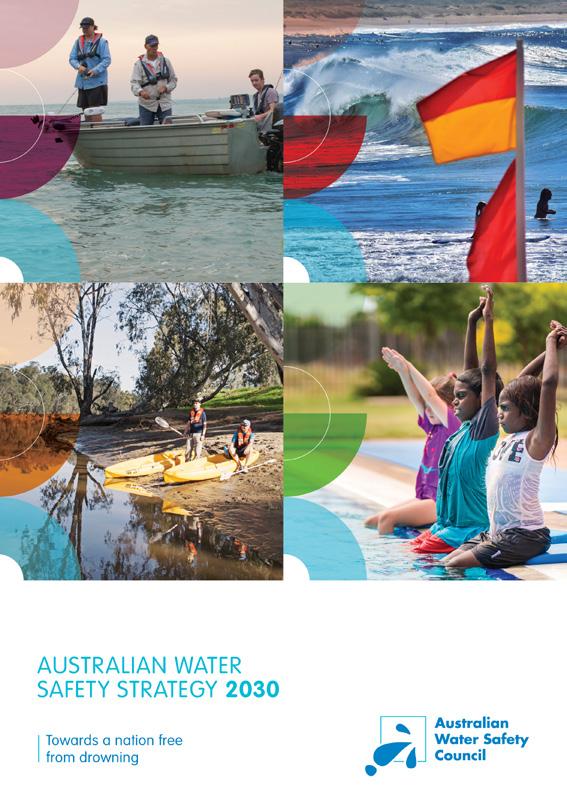
The new website will encourage organisations to share knowledge and expertise through the promotion of organisation actions, including project overviews, goals, key steps and impacts to date.
VIEW WEBSITE watersafety.com.au

13
READ THE STRATEGY watersafety.com.au/ australian-water-safety-strategy
Royal Life Saving Society – Australia together with Surf Life Saving Australia released their annual drowning reports together. In the last 12 months 339 drowning deaths occurred across Australia, the highest in 25 years.

The Royal Life Saving National Drowning Report 2022 found that there were 339 drowning deaths over the past 12 months, which is 15 per cent higher than last year (295), and the highest reported figure since 1996. Sadly, 39 deaths were flood related.

Both organisations are concerned about the impact of flooding, people swimming at unpatrolled locations, and reported increases in drowning among older adults and in school aged children.
While further research is needed, the findings highlight ongoing impacts of COVID-19 on drowning risk, including Australians being more likely to visit unfamiliar, unpatrolled water locations and children lacking swimming skills necessary to enjoy the water safely due to pandemic-induced lesson cancellations.
With the support of the Australian Government, Royal Life Saving is looking at strategies ahead of the warmer months, including bringing forward water safety campaigns, delivering lifesaving services and working with governments, councils and groups across the country.
Federal Minister for Aged Care and Sport, the Hon Anika Wells MP, said the Australian Government was determined to support organisations like Royal Life Saving Society - Australia and Surf Life Saving Australia to raise water safety awareness.
“The increased drowning of older people is particularly distressing. Enjoying a swim has so many benefits for people of all ages. Some simple precautions, like a medical check-up to ensure you are swim fit, or going to the local swimming pool to refresh your skills is a great idea ahead of summer.
“As we prepare for summer, water safety should be top of mind. I urge all Australians to supervise children at all times around water, learn swimming, water safety and lifesaving skills, wear a lifejacket when boating, rock fishing and on watercraft and to swim at a patrolled beach between the red and yellow flags.”
Hon Anika Wells MP, Minister for Sport
14
READ THE REPORT AND WATCH VIDEO royallifesaving.com.au/NDR202 2 REPORTS RELEASED INTO DROWNING PREVENTION, LIFESAVING AND WATER SAFETY
In May we started the collaborative work of developing one of Australia’s first local water safety plans to be centred on Townsville, Queensland which is home to the Wulgurukaba and Bindal First Nations peoples.

Townsville was selected because of its high rate of drowning; in the ten years to 2020/21, 33 people drowned in Townsville and its surrounds. As well as the ocean, Townsville has several significant rivers and their tributaries, the Ross River Dam and countless private swimming pools. The Ross River has been identified in the top 10 river blackspot drowning locations in Australia.
The result was a new water safety strategy specific to the region, which is currently open for review. The strategy, which was developed in a series of workshops with community groups, emergency services, water safety experts and government representatives is designed to reduce drowning in Townsville and work towards initiatives which develop stronger swimming and water safety skills across the community.
The strategy recognises that the area has specific water safety needs given the importance of water to the community, with the sea, rivers, dams and swimming pools all providing opportunities for recreation.
Royal Life Saving Society Australia National Manager – Aquatics, RJ Houston said the water safety strategy was designed to balance enjoyment of the waterways with measures to prevent people from drowning. “We don’t want to get in the way of people enjoying the water. What was clear from the roundtables was that people love the water and want to get out and enjoy it as much as possible,” Mr Houston said.
“What we want is to ensure people have a great day in, on, or around the water and go home safely to their families at the end of the day.
“There are some simple measures we can take – improving sign posting as an example – which can give people the information they need to manage the risk. This strategy is designed to be practical and to take into account the different waterways that people can enjoy in the Townsville area.”
Councillor Maurie Soars said the water safety strategy would be a game changer for the Townsville community. “No one knows this area better than the people who live here,” Mr Soars said. “Local knowledge is critical for keeping everyone in our community safe.”

James Cook University Professor Richard Franklin said it was exciting to see many groups involved in water safety come together to work on solutions that were area specific.
“Having groups including marine rescue and police, researchers, drowning prevention specialists, Department of Environment and Science and key state and community organisations come together to design a solution that addresses the specific needs of this area is important for the community,” Professor Franklin said.
“The research shows that this region is a drowning hotspot. Having gathered the expert voices, we now need to hear from Townsville and surrounds residents to make sure this addresses their needs.
“I hope we’ll see a really strong response from the local community to support the water safety strategy, and to keep people safe.”
15
READ THE DRAFT STRATEGY royallifesaving.com.au/ drafttownsvillewatersafetystrategy TOWNSVILLE AND SURROUNDS WATER SAFETY ROUND TABLE
World Drowning Prevention Day
Royal Life Saving Society –Australia joined the World Health Organization and urged everyone in our community to do one thing to prevent drowning on Monday July 25 for the United Nations World Drowning Prevention Day.


Royal Life Saving State and Territory Member Organisations organised for buildings to turn blue to mark the day. High profile locations including Council House and Matagarup Bridge in Perth, Adelaide Oval and Convention Centre in Adelaide, Flinders Street Station in Melbourne, and Cleveland Lighthouse in Queensland were lit up in blue.


With a 30 per cent rise in drowning experienced last summer and successive floods across the country, Royal Life Saving asked the community to take precautions to avoid further tragedy.


Royal Life Saving Chief Executive Officer, Justin Scarr said if everyone across Australia could do one simple thing to reduce their risk of drowning, we could make significant progress towards reducing drowning deaths.
“Wherever you live, whatever life stage you’re at, everyone can do one thing to prevent drowning,” Mr Scarr said.
Aquatic Facilities across Australia got behind the day utilising a range of online marketing resources across their facility and social channels.
This is the second annual World Drowning Prevention Day, proclaimed by the United Nations. Each year more than 236,000 people drown. We can prevent this silent killer through awareness, education, supervision, training, and emergency preparedness.
16
DROWNING PREVENTION LEADERSHIP ABROAD
LEARN MORE royallifesaving.com.au/ worlddrowningpreventionday
Tracing The Emergence Of Global Drowning Prevention
Although Royal Life Saving has been focused on efforts to reduce drowning for more than 125 years, in global development terms drowning has been a neglected issue, largely absent from United Nations efforts.
That all changed with the United Nations General Assembly’s first resolution on global drowning prevention in 2021. As part of a PhD program, our CEO Justin Scarr traced the emergence of drowning prevention and interviewed global experts.
He found that changes in research methods that first identified what was then described as child drowning epidemic in Asia, linking drowning to health and sustainable development, a small advocacy coalition including the World Health Organization, Royal National Lifeboat Institution and events like the World Conference on Drowning Prevention 2011 in Vietnam all helped elevate awareness of drowning.
VIEW THE STUDY, PUBLISHED IN LANCET GLOBAL HEALTH AT https://www.thelancet.com/journals/langlo/article/ PIIS2214-109X(22)00074-2/fulltext
Royal Life Saving Leads Women In Drowning Prevention Event
Royal Life Saving led a webinar on International Women’s Day, 10 March, bringing together leaders from across the world to celebrate the amazing contribution of women in global drowning prevention.

The session was chaired by Stacey Pidgeon, National Manager Research and Policy at Royal Life Saving. Speakers from Australia, the United Kingdom, Norway, New Zealand and South Africa joined the call which all canvassed ways to #breakthebias, which was the key theme of the day this year.
THE WEBINAR IS AVAILABLE TO VIEW AT https://www.royallifesaving.com.au/research-and-policy/ webinar-series/2022-International-Womens-DayCelebration-Women-in-Drowning-Prevention
Preventing Drowning Report
The World Health Organization has released a new report providing practical guidance on three ways to reduce drowning that can be used in low-, middleand high-income countries across the world.
The Preventing Drowning Report is designed for the provision of day-care, basic swimming and water safety skills, and safe rescue and resuscitation training. Today, drowning claims the lives of over 230,000 people every year – the vast majority in low- and middleincome countries.
Royal Life Saving Society – Australia Chief Executive Officer, Justin Scarr was one of the 17 advisers from around the world who contributed to the report.
“This is an important guide to each of these interventions: teaching basic swimming and water safety skills to school-age children; providing day-care for pre-school children; and training bystanders in safe rescue and resuscitation,” Mr Scarr said.
The World Health Organization recommends programme managers fully implement all practical guidance provided for each intervention, and that those tasked with approving or monitoring such programmes also ensure full adherence to the practical guidance in this resource. Bloomberg Philanthropies provided financial support for the development of Preventing Drowning.
“In Australia we take for granted the existence of many elements of the swimming ecosystem, like guidelines and teacher training, but these are rarely present in parts of the world that most need drowning prevention.”
Justin Scarr
17
Research, Policy and Advocacy
We are bringing science and advocacy to lifesaving. Striving to know exactly who was at risk of drowning – where, when and why. Seeking and testing answers about how to eliminate it. Advocating for change, and collaborative effort to reduce the impact of drowning on the community.
KEY ACHIEVEMENTS
Research and release of the 2021-22 Royal Life Saving National Drowning Report
Compiling the Summer Drowning Toll Report on drowning rates in school-aged children
Analysis of ten years of data on drowning deaths in older people Report on equal access to public aquatic facilities


Analysis of adult learn to swim classes Report on the impact of non-fatal drowning


18


ROYAL
The Royal Life Saving National Drowning Report presents our analysis of fatal and non-fatal drowning across Australia between 1st July 2021 and 30th June 2022. During this time, 339 people lost their lives to drowning and we estimate a further 686 people experienced a non-fatal drowning incident. This is terribly sad and confronting, especially given this reported figure reverses years of progress.

The COVID-19 pandemic has left a mark on families, workplaces and communities. The temporary closure of aquatic facilities and swim schools during the worst of the pandemic is likely to impact Australians for years to come, with children missing long periods of swimming and water safety education, and the aquatic industry now struggling to recruit instructors and lifeguards.
New behaviours emerged, with Australians increasingly seeking out secluded and often unpatrolled waterways to visit or finding a new enthusiasm for domestic tourism taking them further away from the safety of their local pool or patrolled beach.
This year’s findings show that:
Drowning deaths increased by 15% compared to the previous year, but 24% compared to the 10-year average
82% of drowning deaths were males
There were 17 drowning deaths among children aged 0-4 years; this is a 29% decrease on last year and a 23% decrease on the 10-year average, an improvement after rising tragically during COVID-19 lockdowns
15 drowning deaths occurred in children aged 5-14 years, a 7% increase on last year and a 36% increase on the 10-year average, perhaps a reflection of children missing out on swimming lessons
94 drowning deaths occurred in people aged over 65 years, a 34% increase on last year and a 57% increase on the 10-year average. 28% of drowning occurred in people over 65 years
114 drowning deaths occurred in rivers and creeks; 39 were flood-related
Rivers and creeks were the leading location for drowning (34%), followed by beaches (21%) and ocean/harbour locations (13%)
Rivers and Creeks
Rivers and creeks were the leading location for drowning in 2021/22. In part, this was due to significant flooding in New South Wales and Queensland as a result of intense rainfall. Climate change will continue to impact drowning in Australia. Predictions of increased extreme heat events and more intense heavy rainfall events are likely to result in increased drowning risk. Royal Life Saving Australia is committed to supporting emergency management agencies and those organisations responsible for flood response and recovery.
20
LIFE SAVING NATIONAL DROWNING REPORT 2022
READ THE REPORT AND WATCH VIDEO royallifesaving.com.au/NDR202 2

21 339 PEOPLE DROWNED IN AUSTRALIAN WATERWAYS IN 2021/22 This is a 15% increase on 2020/21 and an 24% increase on the 10-year average 13% of all drowning deaths were flood-related 82% of all drowning deaths were males WA 39 NT 8 ACT 1 SA 13 TAS 16 QLD 84 NSW 125 VIC 53 Top 3 locations Top 3 activities Top 3 age groups 34% River/creek 22% Swimming & recreating 21% Beach 14% Boating 13% Ocean/harbour 13% Fall 17% 14% 13%65-74 years 35-44 years 25-34 years
Royal Life Saving compiles the Summer Drowning Toll daily over the summer period (1 December –28 February) based on publicly available information to the end of February, with additional analysis being undertaken for the National Drowning Report later in the year.



Extreme weather pushed the Australian Summer Drowning Toll up this year, with 112 people known to have lost their lives to drowning at the conclusion of the summer period.
That figure rose further when detail from the National Coroners Information System was made available for analysis for the National Drowning Report – rising to 145 deaths.
The wild weather, with heavy rain and flooding which marked the start and end of summer 2021/22, and heat waves over the country during the Christmas period, pushed the death toll up from last summer.
In the analysis of the initial 112 deaths, tragically, 20 per cent deaths over the summer were due to floodingrelated incidents, half of those occurring in the last few days of February. Flooding-related drowning occurred in the Northern Territory, NSW, and Queensland. More than half of all summer drowning deaths in Queensland were flooding-related.
Royal Life Saving Society – Australia CEO Justin Scarr said that every life lost was a tragedy, with the impacts felt far and wide across families and communities.
“Our thoughts are with all the communities who have recently experienced flooding and lost someone during these devastating events. With more rain predicted, we urge people not to drive through or swim in flood waters,” Mr Scarr said.
The Christmas and New Year holiday break was the deadliest time for drowning. The highest number of drowning deaths in a single day occurred on Sunday 2nd January (7) and Christmas Day (6), coinciding with public holidays, state borders re-opening and hot and dry weather across the country during this period.


Royal Life Saving research showed that nationwide, visitor numbers to aquatic locations bounced back to precovid levels (summer 2019/20), with the highest number of visitors recorded on 2nd January, the same day that recorded the highest number of drowning deaths.
“After two years of missed family gatherings and opportunities to catch up with friends, we knew Australians were looking forward to getting out and about this summer. It is devastating to see some of those trips end in heartbreak,” Mr Scarr said.

When compared to last year, more drowning occurred inland waterways (51% vs. 29% in 2020/21). Most people got into difficulty while swimming and recreating (28%), highlighting the importance of swimming and survival skills in all environments. Royal Life Saving research released in December 2021 showed that one in four adults are weak swimmers or can’t swim at all.
The number of children aged 0-17 years that drowned over the summer decreased from the previous summer. In contrast, the number of adults aged 35 years and over drowning increased compared to the previous summer.
“We are deeply concerned about the long-term impacts of children missing out on swimming lessons throughout the pandemic. A coordinated response is needed to ensure we get the most vulnerable back into lessons as soon as possible,” Mr Scarr said.
“It is vital all Australians are given the opportunity to learn to swim and survive in the water. It’s never too late to learn.”
22
TRAGIC OUTCOME: SUMMER DROWNING TOLL RISES READ THE REPORT royallifesaving.com.au/ summerdrowningtollreport2021-22 Royal Life Saving Summer Drowning Report 2021/22 An investigation into drowning across Australia between 1 December 2021 and 28 February 2022
New research by the Royal Life Saving Society – Australia found drowning deaths in school children aged five to 14 have remained stubbornly high over the past decade.
The research, which covers the decade to the end of June 2021, examined all 105 drowning deaths in children aged five to 14 years old. Male children in the five to nine years age group continued to be at most risk of drowning.
There was a short-lived decrease in drowning deaths in this age group in 2016/17 and 2017/18, but those gains have been eliminated in the years since.
It has promoted a call for parents to re-enrol children in swimming lessons, especially older children who have not yet reached the national swimming and water safety benchmarks for their age groups.

Royal Life Saving Senior Project Officer – Research and Policy, Dr Katrien Pickles said it was disappointing to see a reversal in the progress towards reducing drowning.
“We had seen a decrease in drowning deaths in 2016/17 and 2017/18 but unfortunately those gains have been lost,” Dr Pickles said.
“With all children missing out on swimming lessons during COVID-19 swimming pool closures, there is a need for children of all ages to reenrol in swimming lessons.


“As children grow and gain independence, they and their caregivers may over-estimate their swimming abilities. Regardless of how good a swimmer you think your child is, all children need constant supervision in, on and around water.”
The report also found severe weather events were a growing risk factor for drowning deaths in this age group, with seven per cent of the children who died drowning in flood-related incidents. Adult caregivers are reminded to prevent children from playing in or near flood waters, especially storm water drains.
23
DROWNING OF SCHOOL-AGED CHILDREN STUBBORNLY HIGH READ THE REPORT royallifesaving.com.au/ childdrowningreport estimated non-fatal incidents in 5-9 years 1 fatal: 7 non-fatal Children aged 5 – 14 years drowned in Australia between 2011/12 and 2020/21 estimated non-fatal incidents in 10-14 years 1 fatal: 6 non-fatal 455105 240
A new study has shed light on drowning risks for older people in Australia, with onefifth of deaths attributable to an unexpected fall into water.

The Royal Life Saving Society – Australia research looked at 10 years of data, analysing the contributing factors in almost 600 drowning deaths in those aged 65 years and over. In most cases, fallrelated drowning in older people occurred at, or close to, home.
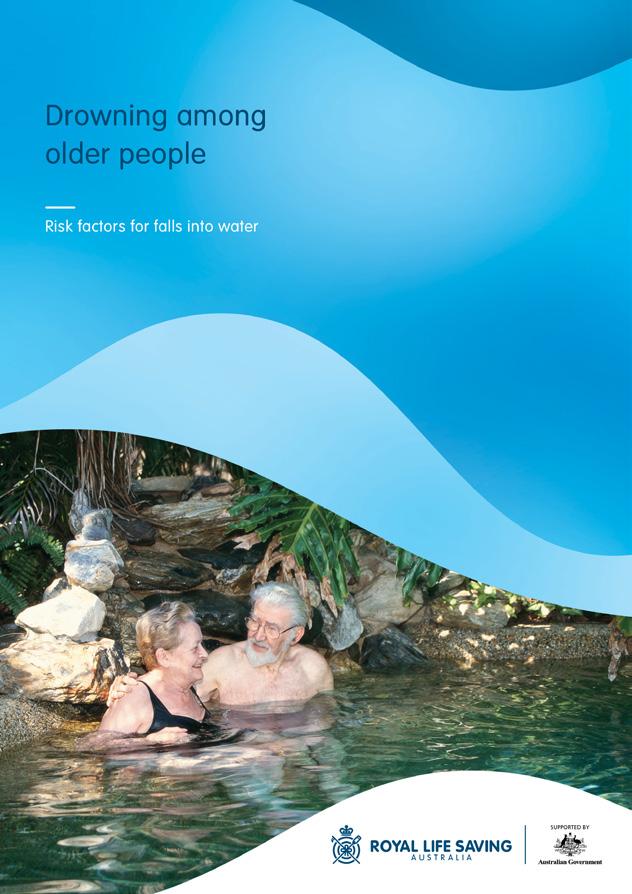
Royal Life Saving Principal Research and Policy Officer Alison Mahony said the data highlighted the need for older Australians to be aware of water bodies around them at all times, rather than just when they planned to go swimming or boating.
“Pre-existing medical conditions, medication use, impaired mobility and use of mobility aids, history of falls and environmental hazards all contributed to falls into water,” Ms Mahoney said.
“A pre-existing medical condition was known to be present in 89 per cent of drowning deaths, most commonly cardiovascular disease (72%) and dementia (22%).”
In 19 per cent of cases an environmental hazard was noted as being present. These included steep or slippery surfaces near water, poor lighting resulting in low visibility, and obstacles which would have posed a trip hazard.
Medication was known to be present in 60 per cent of deaths and blood alcohol concentration (BAC) was greater than or equal to (≥) 0.05% in 19 per cent of deaths.
Royal Life Saving recommends older people attend regular medical check-ups with their doctor and take any prescribed medication as directed. Specific advice relevant to an individual’s lifestyle can be obtained from a doctor or pharmacist.
Physical activity has been shown to reduce the risk of falls and fall-related injuries in older people. For this reason, Royal Life Saving promotes aquatic facilities as safe venues for physical activity and rehabilitation in a controlled environment.
24
The risk of falls into water among older people can be reduced by: Attending regular medical check-ups with a doctor Taking any prescribed medicine as directed Asking a doctor or pharmacist any specific questions related to health and lifestyle Participating in regular exercise to reduce the risk of falls Visiting the local aquatic centre for low impact activity in a controlled environment READ THE REPORT royallifesaving.com.au/ drowningamongolderpeoplereport DROWNING IN OLDER PEOPLE Age Location 65-74 years River/creek 75 years and over Swimming pool 37% 32% 63% 32% People aged 65 years and over drowned in Australia as a result of a fall into water. 2009/10 to 2018/19 116
RESEARCH SHINES LIGHT ON EQUAL ACCESS TO AQUATIC FACILITIES
A new report commissioned by the Royal Life Saving Society – Australia has found a new non-discrimination guideline for pool operators is needed to help ensure equal access to public aquatic facilities.
The report, Equal Access to Public Aquatic Facilities: Guidance for Local Councils, Facility Managers and the Aquatic Sector, was authored by Dr Beth Goldblatt from the Faculty of Law at the University of Technology Sydney. It reviews the legal and human rights frameworks governing aquatic facilities in Australia, including discrimination law.
Public aquatic facilities are important community resources providing opportunities for learning, exercise and recreation with health, safety and other social benefits. Access to aquatic facilities has long-term implications for health and safety beyond drowning prevention including social inclusion and employment and career opportunities.
The research highlighted positive initiatives being implemented across the aquatic sector to increase access and equity within their communities. These included offering specifically designed swim programs and events, and the provision of training so staff can support different groups of users.
Royal Life Saving National Manager, Research and Policy, Stacey Pidgeon said that while research into the barriers of accessing facilities and programs has been undertaken previously, this report goes deeper to increase our understanding of some of the less obvious barriers.
“We know there are families and communities that are not accessing aquatic facilities and this report highlights some reasons why not everyone may feel comfortable in accessing their local aquatic facilities,” Ms Pidgeon said.
“For example, people with different disabilities may need a range of supports to enjoy an aquatic centre in the same way as other users. Similarly, women from some cultural or religious groups who do not feel comfortable to share intimate spaces with men may need certain accommodations at the facility.”
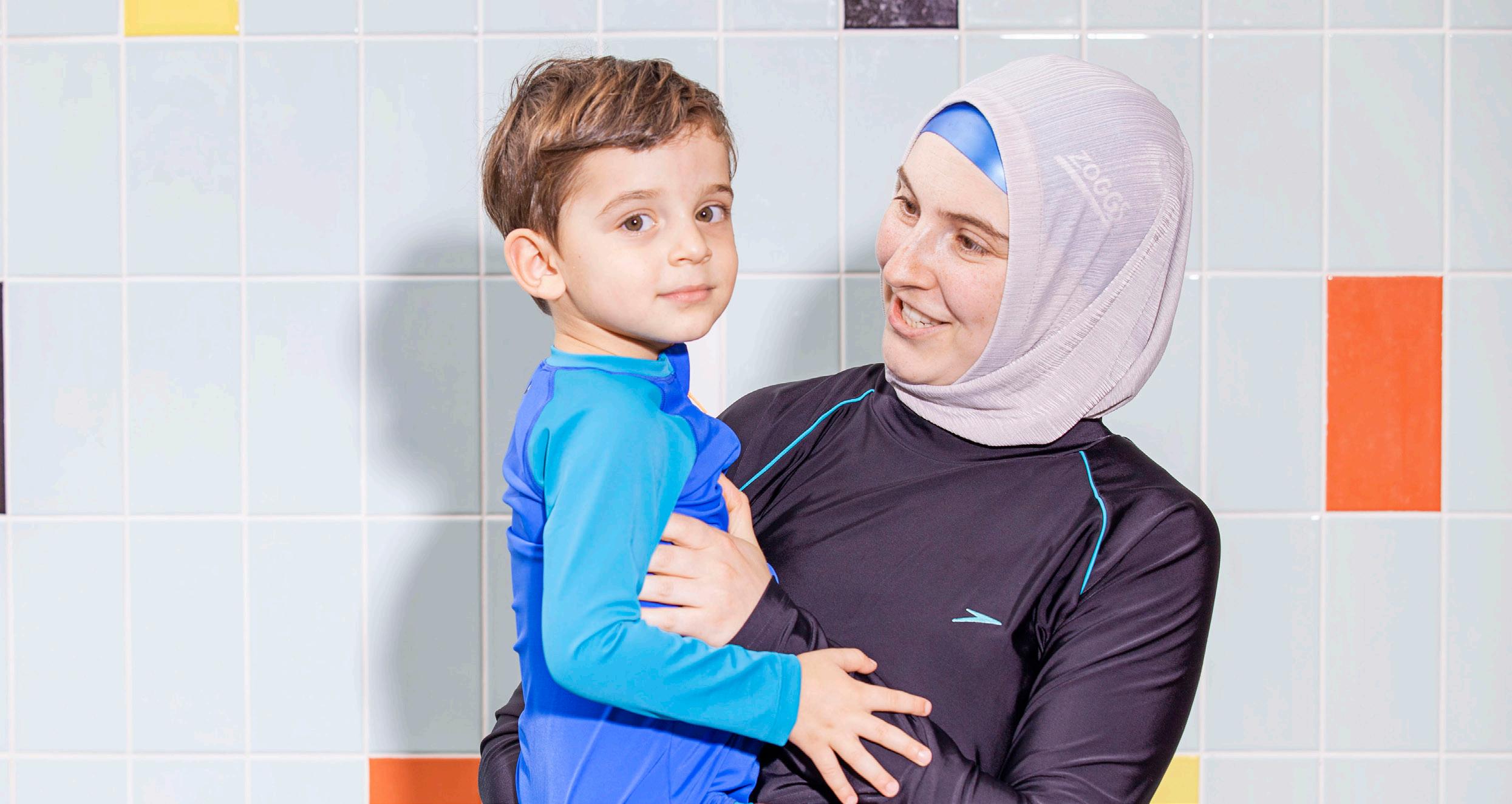
“We need to work with communities and local aquatic facilities to develop and implement solutions to address those barriers. We want everyone to feel welcome and be able to access all the benefits of swimming. The report highlights the opportunity for aquatic facilities to lead change in their communities,” RJ Houston, Royal Life Saving National Manager – Aquatics said.
“By proactively tackling issues of access and inclusion, they can create shared value both for facility owners and operators and their communities.”
Royal Life Saving is committed to working together with the aquatic sector and communities to ensure equal access to swimming pools and programs for everyone.
READ THE REPORT royallifesaving.com.au/ equalaccesstopublicaquaticfacilities
Adult learn to swim classes are an important means of reducing the drowning rates in Australia, but little is known about who attends them and how much they learn.
Research by Royal Life Saving Society – Australia aimed to shed light on who attends adult swimming programs, how long they are in lessons and how much they are spending on classes. It also highlights the types of adult swimming and water safety programs offered and charts the improvement in swimming and water safety skills.
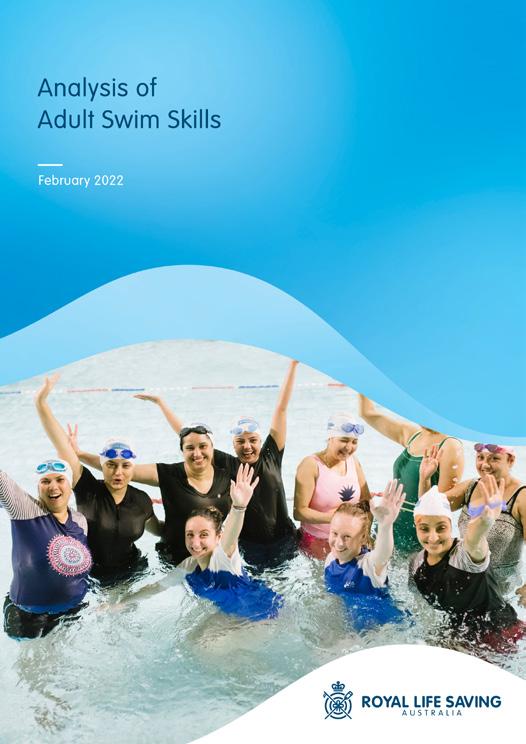
This study identified that a variety of swimming programs are available around Australia for adults, including public swimming lessons, subsidised lessons, and fully funded programs, with most adults in swimming classes attending just nine lessons on average – approximately five hours in the water.
The Australian Water Safety Strategy 2030 identifies swimming and water safety skills as a key factor for reducing drowning among all age groups, however this study found that most adults taking swim lessons are only acquiring basic skills in the water.
Regardless of the type of program they were attending, and how long they had been attending lessons for, the study found that most adults were unable to swim more than 25 metres upon completion of their program. Just eight per cent could reach the National Benchmarks set for 12-year-olds at the end of their program.
Royal Life Saving Research Manager
Stacey Pidgeon said that while many swim schools offer swimming programs for adults, this study highlights more could be done to align adult swimming and water safety programs with the National Swimming and Water Safety Framework. This would ensure that adults develop a range of swimming and water safety skills, just as children do in their lessons.
“It’s fantastic to see that adults are taking the plunge and learning to swim. However, we need to better understand the needs of men, who are more at risk of drowning yet are less likely to take up adult swimming classes,” Ms Pidgeon said.
“There is an opportunity to enhance existing programs or develop new programs that better meet the needs of adult swimmers, especially men.
“Our research found that adult swimmers were more likely to come from higher socioeconomic backgrounds, so we need to look at ways to reduce the cost barriers and consider other factors that may influence adults to enrol and attend swimming lessons.”
Previous research conducted by Royal Life Saving has reported that adults may face multiple barriers in attending swimming programs beyond just the cost of lessons, including a fear of water, access to childcare, available times of programs and cultural appropriateness of programs.
Subsidised programs may encourage ongoing participation, such as the Royal Life Saving Western Australia model, where 29 per cent of participants continued after their initial eight-week program.
This research has been used to inform the development of Royal Life Saving’s new adult Swim and Survive curriculum.
26
READ THE REPORT royallifesaving.com.au/ analysisofadultswimskills ADULT SWIM SKILLS 77% of adult swimming lessons were attending one 30-minute group lesson per week Profile of adults attending swimming programs 3861% 40% Average ageFemale Are aged 35-44 years
Between 1 July 2002 and 30 June 2017 there were 7,374 cases of non-fatal drowning in Australia. This is an average of 492 cases of non-fatal drowning each year requiring hospitalisation.
For every fatal drowning, another three cases of non-fatal drowning are recorded. People who survive a drowning incident may experience longterm health complications or life-changing injuries. Tragically, non-fatal drowning affects more individuals, families and communities every year. Between 2002/03 and 2016/17 (15 years), cases of non-fatal drowning increased by 50 per cent.
Non-fatal drowning occurs among people of all ages and in all aquatic locations. Children aged 0-14 years account for 54% of non-fatal drowning incidents, followed by adults aged 2554 years (22%). Over a third of incidents occur in swimming pools (35%) and 26% in natural water, including inland and coastal waterways. Almost two thirds of non-fatal drowning incidents occur in major cities (65%).
The average length of stay in hospital following a non-fatal drowning incident is 2.3 days, ranging from 1.5 days for children 0-4 years to 5.9 days for older adults aged 75 years and over. Pre-existing medical conditions are more common among older people, likely requiring more complex medical care and therefore longer hospital stays.
On average, 65 cases of non-fatal drowning require time in an Intensive Care Unit (ICU) each year, with an average duration of stay of 69 hours (2.9 days).
Some patients require Continuous Ventilatory Support (CVS). This refers to the use of a machine to assist breathing. On average, 50 cases of non-fatal drowning require time on CVS each year, with an average duration of 61 hours (2.5 days).
The Australian Water Safety Strategy 2030 encourages a continued focus on the full burden of drowning, with research and policy activities designed to further our understanding of nonfatal drowning and its impacts. Correct use of terminology among policymakers, researchers, journalists and the general public ensures the full burden of drowning is recognised. It should be noted that phrases such as ‘near-drowning’, ‘secondary drowning’ and ‘dry drowning’ are inappropriate and should not be used.
To prevent non-fatal drowning: Always supervise children around water Correctly install and regularly maintain a compliant pool fence and gate Be aware of limitations in skills and fitness
Check conditions and hazards before entering the water Never swim alone
Learn swimming and lifesaving skills, including CPR
Royal Life Saving is planning further research into the social impacts of non-fatal drowning to better understand how these incidents affect families and communities.
27
READ THE REPORT royallifesaving.com.au/ non-fataldrowningreport IMPACT OF NON-FATAL DROWNING 7,374 cases of non-fatal
drowning
between 1 July 2002 and 30 June 2017 (hospitalisations) Non-fatal
drowning incidents increased by
50% between 2002/03 and 2016/17 Average
of
492 cases
of non-fatal drowning each year
Community Awareness and Action
While we talk about its perils, we actually love the water, and we want you and your family to love it too. With just a little advice, and a few key skills it can bring a lifetime of good health, fitness and family fun.
KEY ACHIEVEMENTS
Campaign to increase community awareness and action
We delivered community awareness campaigns across Australia to prevent drowning: We Swim Keep Watch Make the Right Call Summer Safety Campaign Make Safe Decisions Around Water Respect the River Portable Pools – Don’t Duck Out Summer Drowning Toll

Promote the benefits of safe aquatic pursuits


We have actively promoted safe aquatic recreation to prevent drowning deaths in inland waterways, aquatic centres, and home swimming pools with programs including: Respect the River Swim Ready Keep Watch @ Public Pools Swim and Survive
Engaged the community and our followers with ongoing news and events via Royal Life Saving website Royal Life Saving social media channels

28
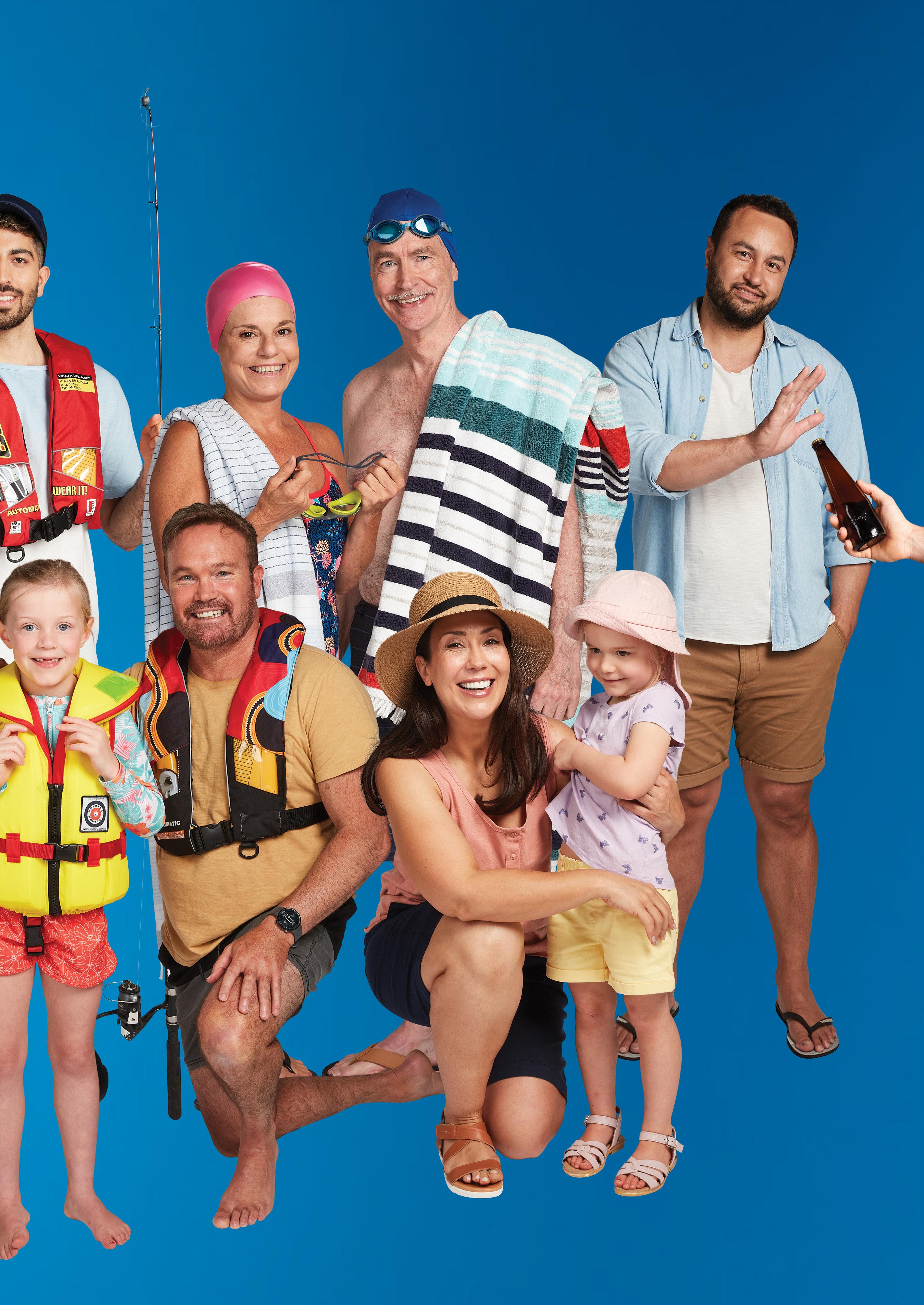
We Swim is inspiring parents across Australia to take action to ensure their children enjoy all the benefits of swimming, from the fun stuff like splashes, dives and races to the many health and safety benefits of being in, on and around the water.


Whether children are new to swimming or have dropped out too early – the aim is to ensure all children stay in lessons long enough to achieve and exceed the national benchmark for swimming and water safety, to swim continuously for 50 metres and float in deep water for two minutes by 12 years of age.
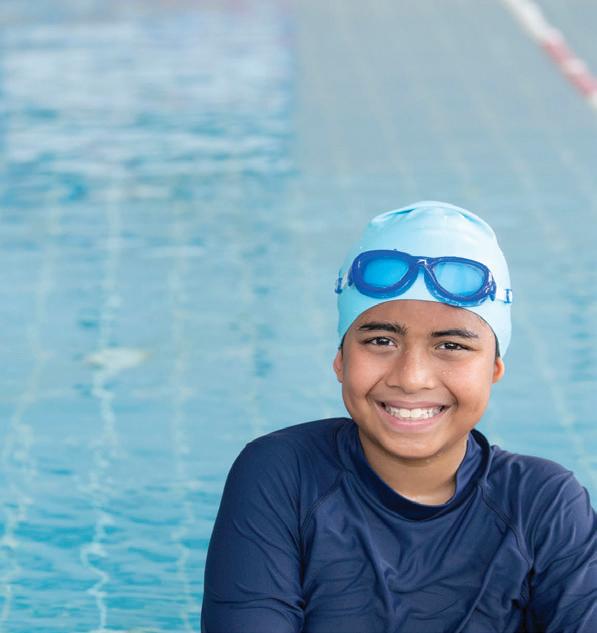


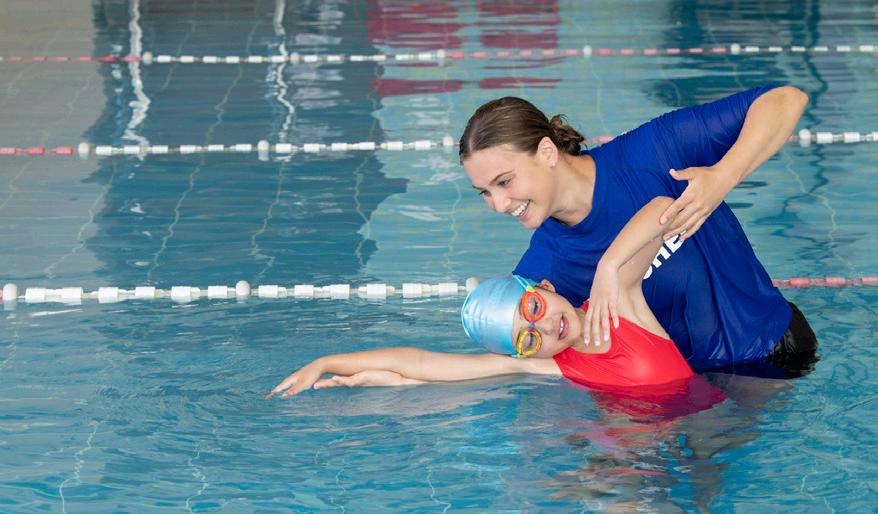
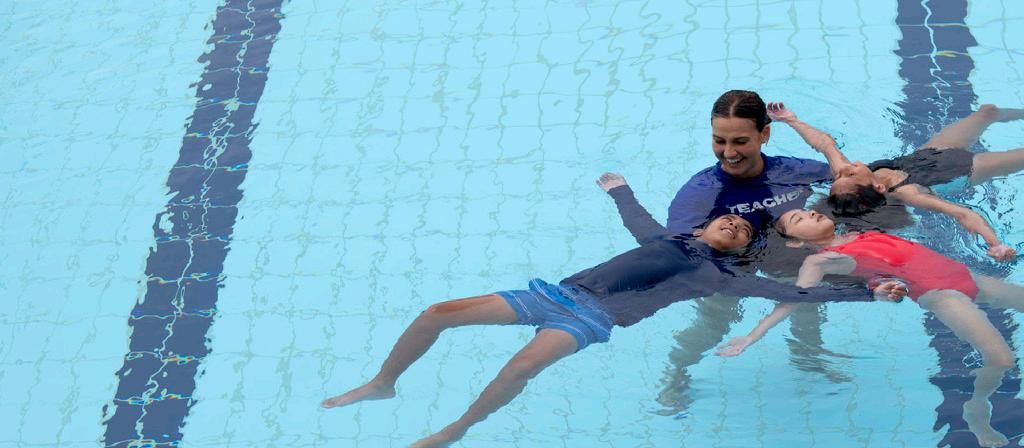
Campaign Activity


The We Swim campaign was launched in December 2021 to industry with a small PR push on our owned social and digital channels from 16 December 2021 until March 2022.

Campaign Results
Campaign Resources included Toolkit, Videos, Digital Displays, Posters and Social Media Assets.
Media
30
Digital Displays Social
Videos Posters We Swim for our health and safety but also for fun! Life is better when we swim. Can your child swim 50m without stopping? And float for 2 minutes? Enrol in lessons today WeSwim.com.au Learn more We Swim 1 January Can your child swim 50 metres without stopping? Or float for 2 minutes? Achieving these minimum standards helps them enjoy water safely. Enrol in lessons today WeSwim.com.au Learn more We Swim 1 January We Swim for our health and safety but also for fun! Life is better when we swim. LOGO WE Swim We Swim for our health and safety but also for fun! Life is better when we swim. Swim LOGO WE Swim We Swim for our health and safety but also for fun! Life is better when we swim. WE Swim Life is better when we swim. WE SWIM CAMPAIGN.
Supporters have joined the We Swim movement
From large aquatic facilities to local swim schools - the aquatic industry were encouraged to sign up to receive the Campaign Supporters Toolkit with all the resources and key messages to share with their local community.
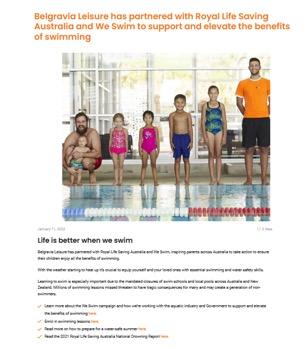

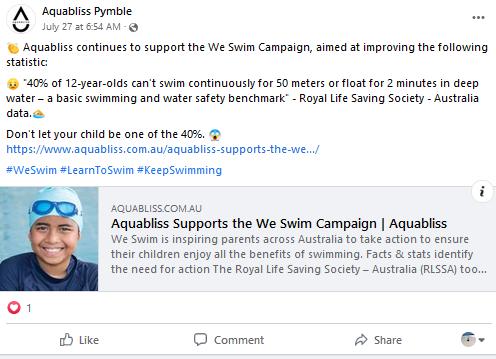
The campaign was well received by industry with following key partners committing to the campaign and sharing campaign resources and social assets amongst their networks:
• Aligned Leisure
• Australian Swimming Coaches and Teachers Association
• Australian Swim Schools Association
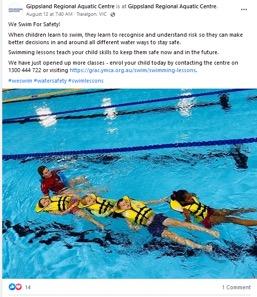

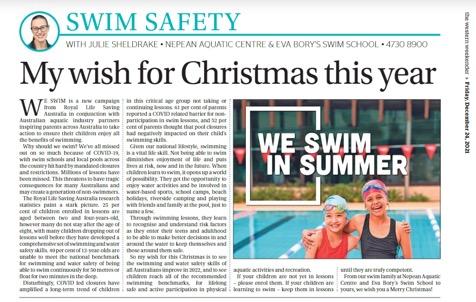
• Belgravia Leisure
• BlueFit
• Jump Swim Schools
• Kids Alive Do the Five
• SPASA Australia
• Swimming Australia
• YMCA
With the industry hit hard by COVID-19 and further lockdowns across January 2022, combined with an industry still in recovery (with staff shortages) there was a delay in making a bigger PR push until mid-end 2022.
31
900+
Visit: royallifesaving.com.au/weswim
Royal Life Saving’s Keep Watch campaign has made significant inroads in helping to reduce drowning in children aged 0-4 since it was launched nearly 30 years ago. Drowning deaths however remain the leading cause of preventable death in this age group.

Always Keep Watch: Supervise. Actively supervise children around water.
Restrict. Restrict children’s access to water.
Teach. Teach children water safety skills.
Respond. Learn how to respond in the case of an emergency.
Royal Life Saving launched the Keep Watch campaign on Tuesday 9th November in time for summer to remind parents and carers about the risks of child drowning.
Research figures showed that, over the past 19 years, 532 children aged zero to four years drowned. Of these, 40% were children aged one year who drowned.
For every fatal drowning in this age group, a further eight children are admitted to hospital following a non-fatal drowning. Some children sustain lifelong brain injuries.

The majority of deaths in children aged zero to four occurred in backyard swimming pools (52%), with 38% occurring during the summer months. Accidental falls into water was the leading activity prior to drowning in this age group, accounting for 77% of all deaths. Almost all of these deaths were due to a lack of active adult supervision.
Keep Watch is proudly supported by

Campaign Activity
1. Broad Media Outreach: TV, Radio, Print and Online News
2. Community Service Announcement Placement
3. Online Digital and Social Media
Campaign Resources
Campaign resources were developed and deployed across multiple media channels (inc. TV and social) to support the campaign including:
30 Second CSA – Keep Watch to keep your child safe.
Kids will be kids. And we love them all. Cute, funny, quiet, wild, angelic, studious, all of them with their own unique personalities, all of them curious and unpredictable. One day avid explorers and princesses the next, with everything in between. Which is why we love them even more!

But they have one thing in common: Kids can’t help themselves around water, you need to. Keep Watch.
15 Second CSA - Supervise. Restrict. Teach. Respond. Distractions are dangerous. Remain ever vigilant and always watching. Royal Life Saving urges all parents to Supervise, Restrict, Teach and Respond.
Supervision is the single most important thing you can do to keep your children safe around water. Any distraction is dangerous and puts young children at risk around water. Whether it is a phone or social media use, or carrying out everyday tasks, such as leaving a child unsupervised momentarily to cook, take the rubbish out or collect the washing, no task is worth your child’s life
Social Media Tiles

Royal Life Saving reminds parents to prepare for the unexpected. ALWAYS KEEP WATCH.
32
TV,
Community
Social
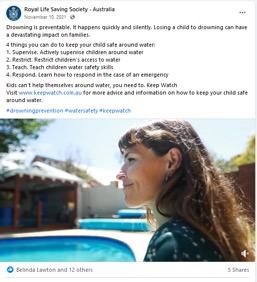
Own
Key Media Highlights Television
Two national features Sunrise (Channel 7) and News Breakfast (ABC TV). News package out of Channel 10 Brisbane that ran in the metropolitan cities on the evening news – Brisbane, Sydney, Melbourne, Adelaide and Perth. Channel 9 evening news in Sydney
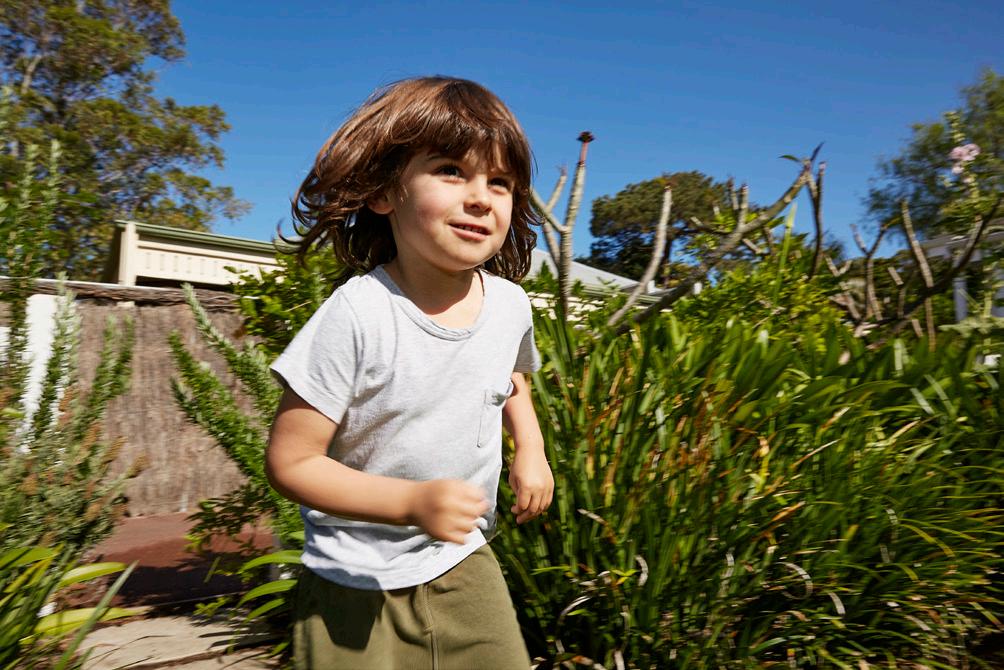
Radio
Over eighty five radio interviews nationwide with feature radio interviews with: ABC’s Radio Sydney afternoon program 3AW’s afternoon program. ABC’s national Radio News Breakfast program

Print
Australian Associated Press distributed widely with coverage in The Guardian, The New Daily, The Herald Sun, Melbourne and Courier Mail, Brisbane.
Online coverage Including Channel 7 and the ABC.


Campaign Results
Radio, Print and Online Audience Reach = 5,048,328 Media Articles = 145
Service Announcement Placement Channel 7, WIN, Foxtel and Channel 31 in Melbourne
Media
Channels Facebook, Instagram, YouTube, Twitter Social Media Posts Community Service Announcement
33 Visit: royallifesaving.com.au/keepwatch
Make the Right Call, now in its third year, highlights the dangers of risk-taking behaviour around aquatic environments.

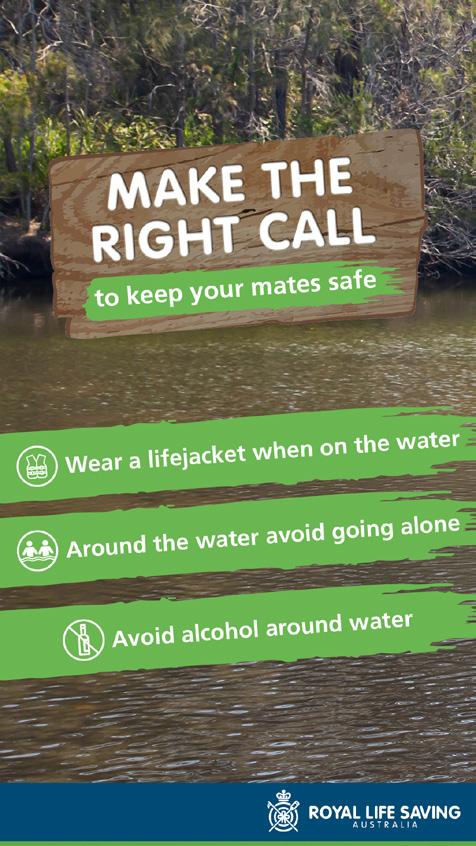
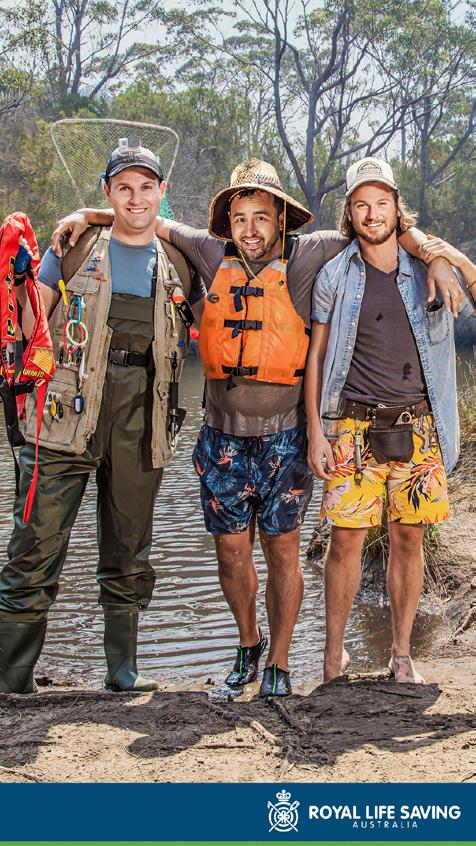
Men taking risks and overestimating their abilities continues to be our greatest challenge in drowning prevention, with males continuing to account for more than 80% of drowning deaths in Australia. Recent data showed that men aged 25 to 44 years are especially prone to drowning; in the 2020/2021, over 88% of those who drowned in this age group were males.
Campaign Activity
1. Media Partnership with Southern Cross Austereo and Triple M
2. Online Digital Media with Facebook and YouTube
3. Broad Media Outreach: TV, Radio, Print, Online News
Campaign Resources
As part of the Make the Right Call Campaign a variety of resources were deployed to support the campaign including:
TV and Radio Community Service Announcements promoting:
• Combined Campaign Message Make the Right Call - to keep your mates safe.
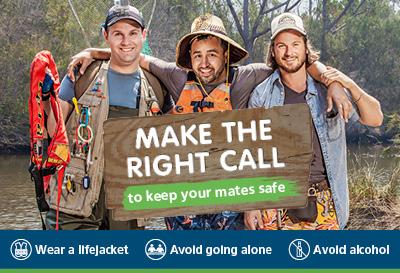
• Make the Right Call –Avoid alcohol around water

• Make the Right Call –Wear a lifejacket when on the water
• Make the Right Call –Around the water avoid going alone
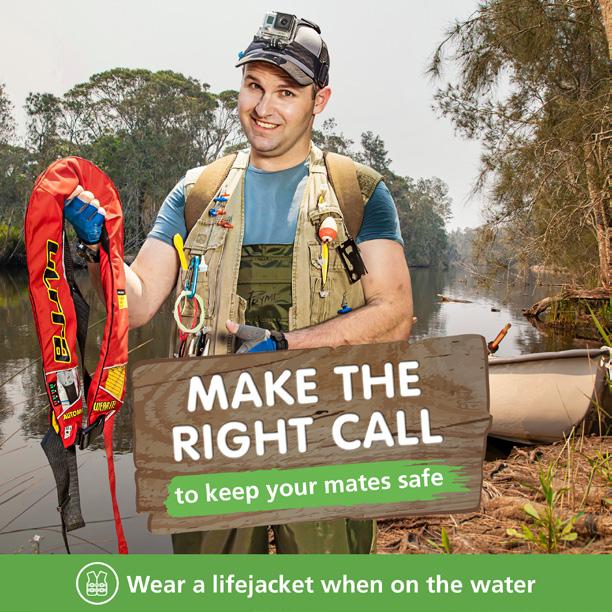
Social Media Tiles
34
Digital AdCommunity Service Announcement Men
Alerted to the Dangers of Risk Taking Around Aquatic Enviroments.
MAKE
THE RIGHT CALL
CAMPAIGN.
Campaign Results
1. Media Partnership with Southern Cross Austereo and Triple M Royal Life Saving partnered with Southern Cross Austereo – Triple M Regional Networks to deliver a multi-media solution.
3. Broad Media Outreach TV, Radio, Print, Online
Australia Day Push: 21 to 26 January 2022. Royal Life Saving warned men not to take risks around water. Royal Life Saving’s Summer Drowning Toll showed three-quarters of those who drowned since December 1 were men.
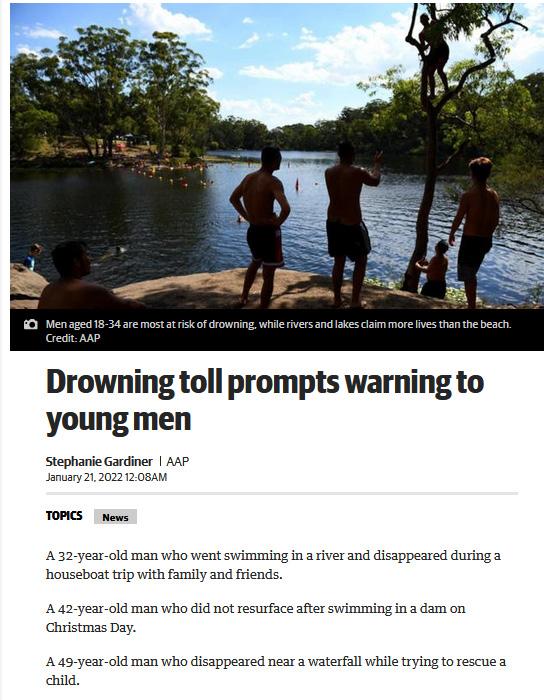
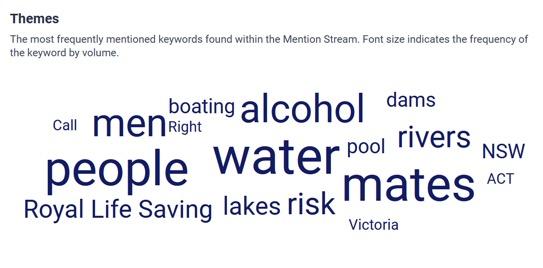
Delivery Report
Summary 2021-22 Key Numbers Nationally Instream – Digital Audio General = 417,980 Impressions 44,714 Reach (Unique Users)
Hotspots = 218,284 Impressions 27,201 Reach (Unique Users)
Online Display and Retargeting General = 2,998,153 Impressions
Hotspots = 1,606,866 Impressions
TV CSAs Value $164,459
Radio CSAs Value $276,606
Added Value/Station Support/Native Editorial 97,716 Impressions 52,712 Reach
The Make the Right Call media release was circulated nationally on 21 January 2022 with key numbers summarised below:
TV, Radio, Print and Online Audience Reach = 2,563,562
Media Articles = 173
Social Media Own Channels
Facebook, Instagram, YouTube, Twitter
Online News Article
2. Online Digital Partnership - Facebook and YouTube Delivery Report Summary 2020-21 Key Numbers Nationally Facebook and YouTube 2,200,973 Impressions 28,487 Clicks 1,927,543 Reach (Unique Users)
Media Themes
35
Visit: royallifesaving.com.au/maketherightcall
The Summer Water Safety campaign was a brand led macro initiative, designed to support existing campaigns across a pivotal summer period with the call to action for everyone to enjoy the water safely. As a water loving nation, it was anticipated over the summer period that more than half of the population were set to travel to an aquatic location.
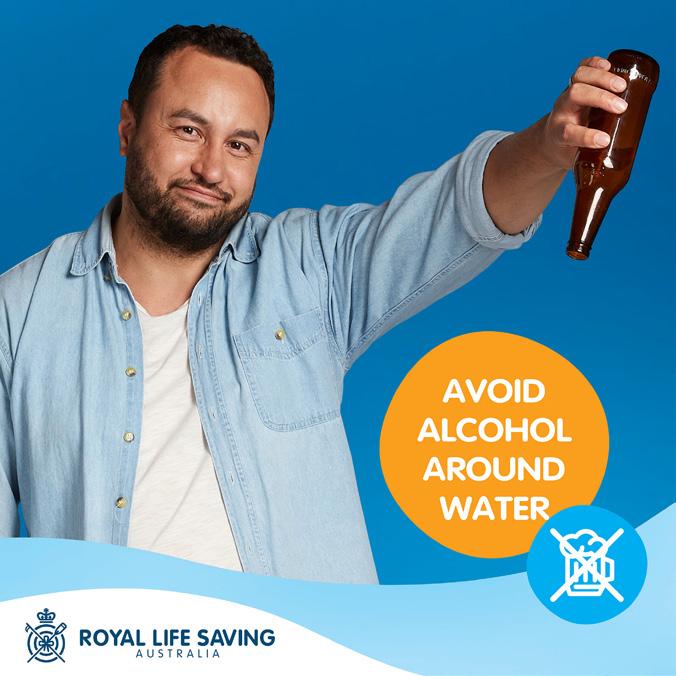

Royal Life Saving research found that more than onethird of all those who drowned died more than 50km from home, prompting an urgent warning as people planned post-pandemic reunions away from home with family and friends.
The campaign targeted families and communities (25-65 years old) who were out and about, enjoying swimming and recreational activities across Summer.
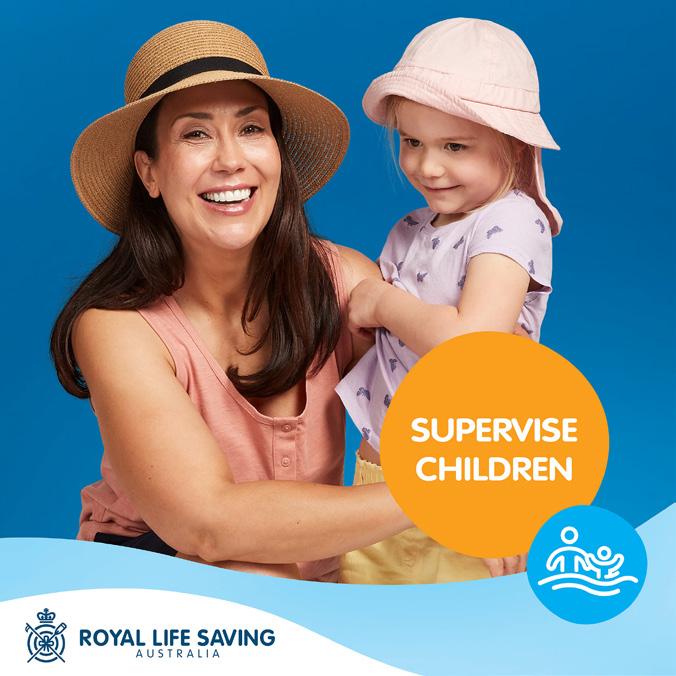
Top media consumption take outs:
• Surfing the internet
• Free to Air TV
• Radio
• Social networks with Facebook and Youtube.
Behaviours:
• News, sports, current affairs
• Visiting friends & relatives
• Camping, fishing, boating, recreational
• Travel & holiday
• Listening to music
There was a strong regional focus with specific targeting of the top local government areas identified as high-risk locations and communities.
The Summer Safety Campaign was launched on Wednesday 15 December 2022.
The campaign was sensitive to the ongoing impact of COVID-19 messaging over the past two years, highlighting a common-sense approach to drowning prevention and advocating simple safety tips to prevent drowning:
• Know the conditions
• Wear a lifejacket
• Avoid going alone
• Supervise children
• Avoid alcohol around the water
Campaign Activity
1. Media Partnership with Southern Cross Austereo and Hit FM
2. Online Digital - Facebook and YouTube
3. Multicultural Media SBS Radio
4. Parliamentary Engagement
5. Broad Media Outreach (TV, Radio, Print, Online News)
Campaign Resources
1x Feature 60seccombination containing 5 messages
1x TVC CSA 30seccombination containing 4 messages
5 x TVC CSA 15sec –single messages
1x Radio 30seccombination containing 4 messages
5 x Radio CSA 15sec – single messages
Audio and Film bites Static images –combo and single messages
Custom digital display media including social media tiles
Social Media Tiles
36
Everyone enjoy the water safely. SUMMER WATER SAFETY CAMPAIGN.
Campaign Results
1. Media Partnership with Southern Cross Austereo and Hit FM
Royal Life Saving partnered with Southern Cross Austereo and Hit FM Networks to deliver a multi-media solution being in market with messaging from 15 December 2021 until 11 February 2022.

Summary 2021-22 Key Numbers Nationally Instream – Digital Audio General = 225,732 Impressions
Hotspots = 161,637 Impressions
TV CSAs Value $46,792
Radio CSAs Value $209,912
Added Value/Station Support/Native Editorial 48,760 Impressions
2. Online Digital Partnership - Facebook and YouTube
Summary 2020-21 Key Numbers Nationally
Facebook General = 971,362 Impressions
Hotspots = 586,790 Impressions
YouTube General = 574,540 Impressions Hotspots = 296,910 Impressions
3. Multicultural Media SBS Radio
The Summer Water Safety Messages were translated into Arabic, Mandarin and Hindi and were played on SBS Radio from 12 December 2021 to 12 February 2022.
REACH (LISTENERS)
Arabic 77,000 (National)
Mandarin 117,000 (NSW, QLD, VIC, SA, WA) Hindi 36,000 (National)
4. Parliamentary Engagement
Several Federal MPs/Senators shared our important safety tips across summer.
5. Broad Media Outreach TV, Radio, Print and Online
17 television news services ran pieces – some on more than one news bulletin.
68 radio interviews – some interviews ran on more than one news bulletin.
24 metropolitan radio news interviews ran – some news desks ran the story on a number of bulletins.
Australian Associated Press prepared a news piece and was run by a range of papers across Australia.
37 Website Banner
Visit: royallifesaving.com.au/summerwatersafety
Royal Life Saving is committed to supporting diverse communities with water safety and swimming education that is culturally appropriate and accessible.
The ‘Keeping our community safe when swimming, fishing, and boating’ campaign now in its second year was launched on 12 April 2022, with the aim of increasing water safety among multicultural communities, promoting simple safety tips to prevent drowning when swimming, boating, and fishing.

This campaign includes the following important messages:
Don’t go alone
Always wear a lifejacket
Don’t drink alcohol
Always watch your children
Learn swimming and water safety skills
Royal Life Saving Australia is a member of many water safety multicultural committees and has been developing strong connections with both multicultural stakeholders and communities. These individuals and groups were consulted around the key messages, method of delivery and images as an important part of campaign planning.
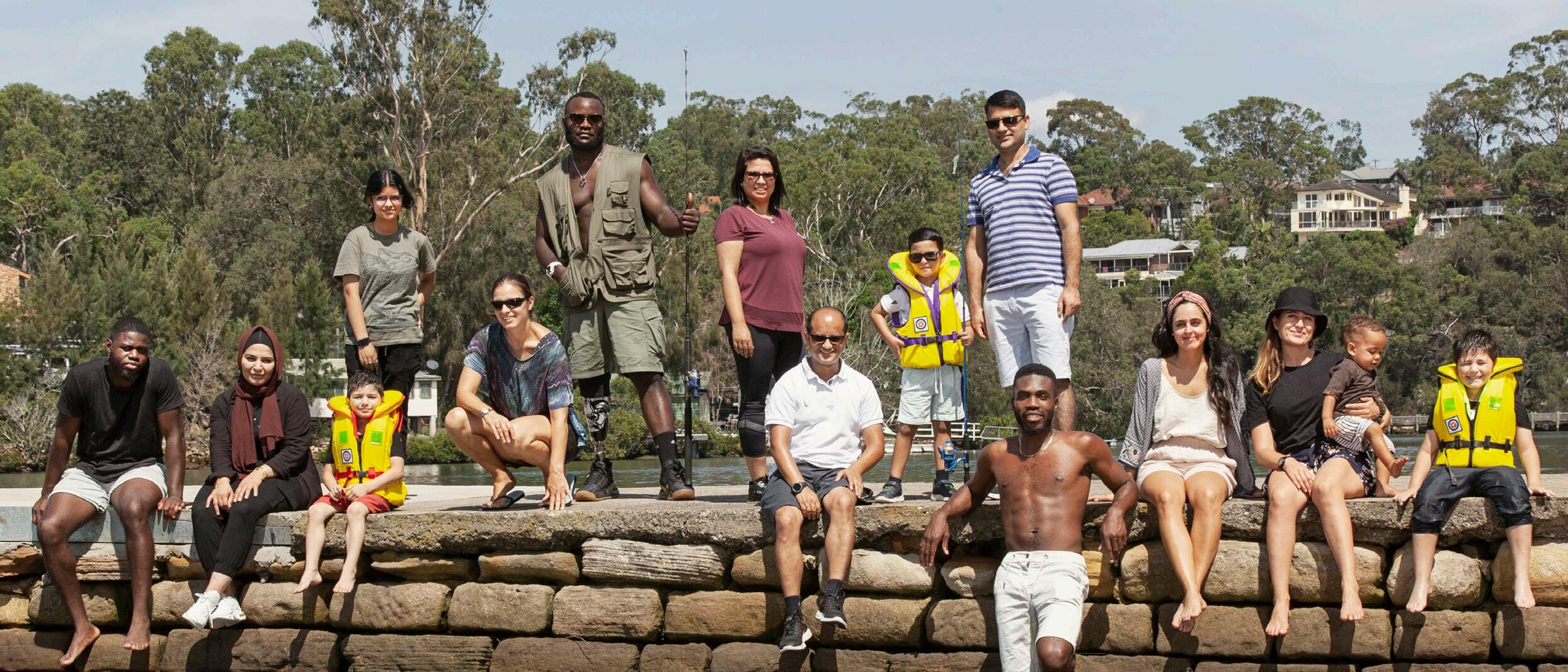
Campaign Resources
As part of the campaign a range of resources were available and deployed across multiple media channels including social media tiles, DLs, posters, photos and educational videos.
The campaign targeted the following language groups:
• Arabic
• Bengali
• Burmese
• Chinese
• Farsi
• Korean
• Kurmanji
• Nepali
• Swahili
• Vietnamese
Campaign Activity
Royal Life Saving Australia engaged The LOTE Agency to distribute campaign information through a grassroots digital PR campaign.
The outreach consisted of:
• translation of further material assets
• creation and distribution of a stakeholder pack with EDM distribution to CALD peak stakeholders
• social media activation via CALD private and public groups.
Campaign Results
Throughout the campaign outreach, LOTE found communities and local ethnic businesses to be receptive to the campaign intent and goals. Organisations and CALD communities who received the stakeholder pack regularly stated that the materials were dynamic and communicated the message in a simple and direct manner.
1.4
million people reached
Keeping our community safe when swimming, fishing and boating. MULTICULTURAL CAMPAIGN


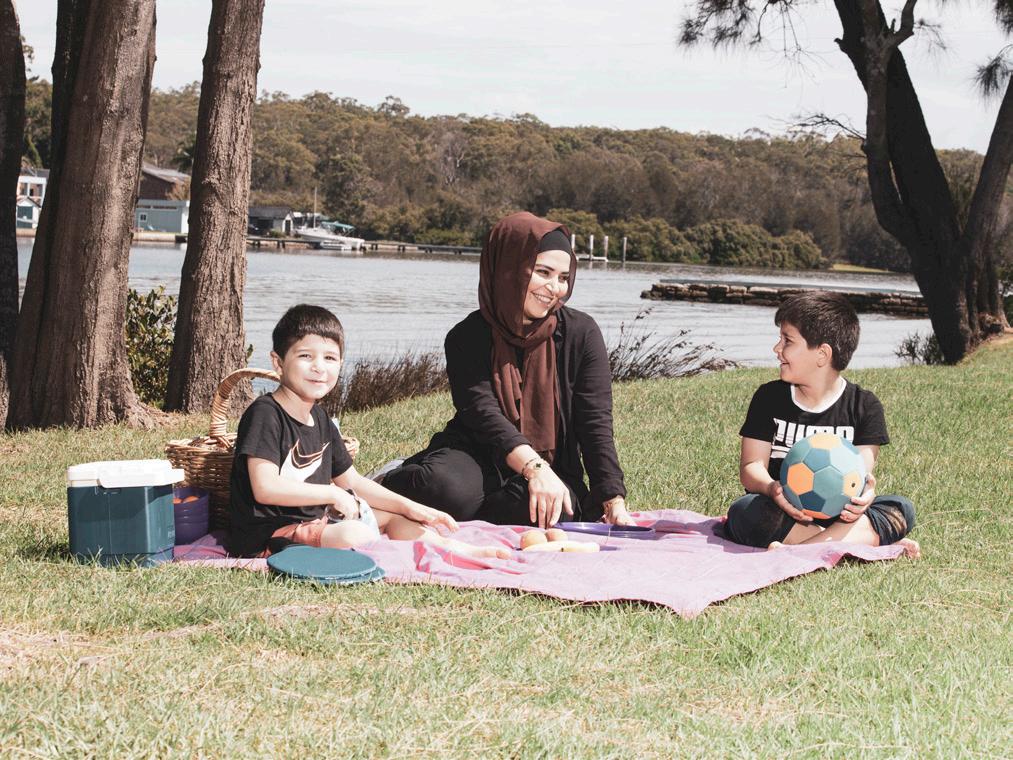
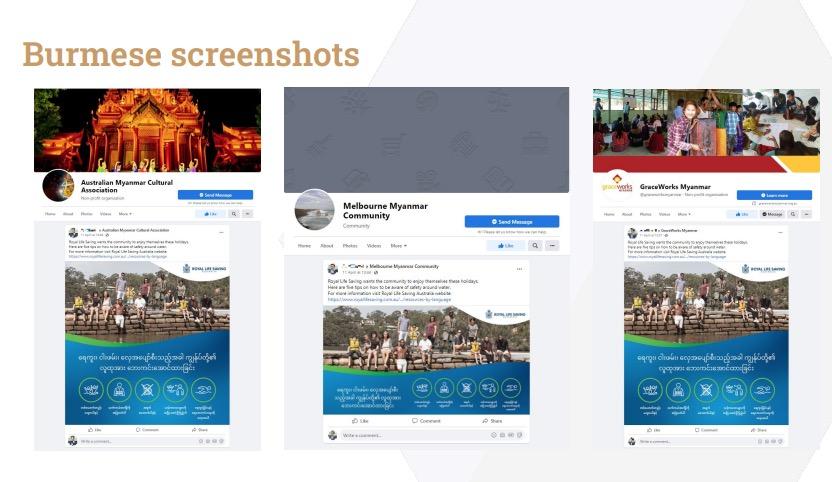
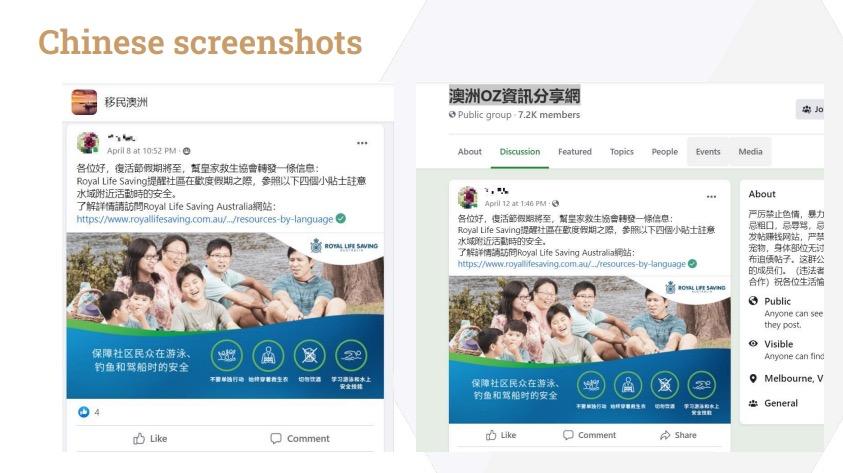


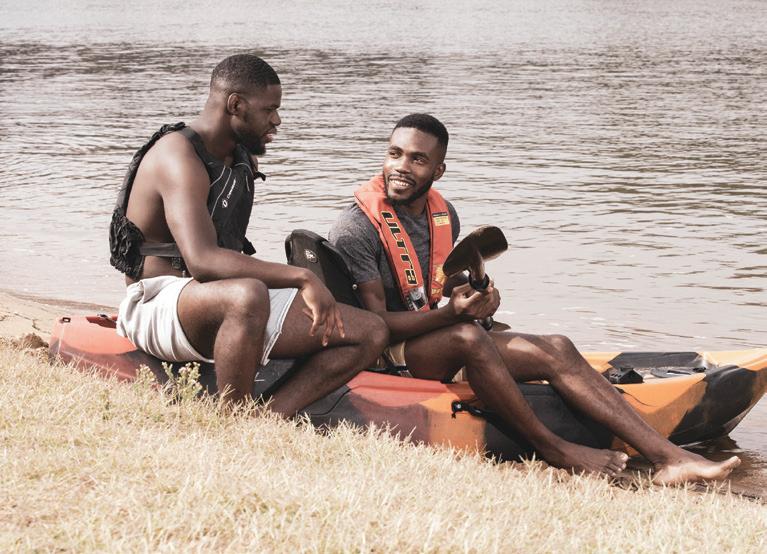



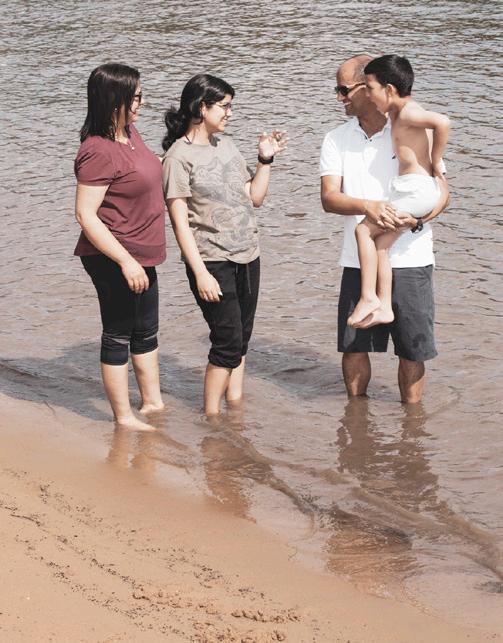



39 Sample Social Media Campaign Resources Visit: royallifesaving.com.au/multicultural
STRONG
SAVING WEBSITE
SEARCH
Search functionality getting users to the information they need quickly and easily.
BOOKING
A simple booking function for Training Courses with the ability to filter based upon region, category and accredited training type.
ENGAGEMENT
Engaging pages with data insights, interactive media, and user
relevant resources.
MULTICULTURAL
Multicultural resources, with main menu language navigation.

INDEX
Indexed information –e.g Guidelines for Safe Pool Operation are fully indexed and searchable making it easier to reference particular guidelines.
RESPONSIVE
Responsive design across all devices.
The website builds upon the Royal Life Saving Brand and is driven by clear outcomes:

Connecting Royal Life Saving’s programs, drowning prevention safety information and research with those that need them
Increasing community awareness
Promoting safe aquatic recreation to prevent drowning deaths
Relationship building with aquatic centres, swim and survive partners, schools and supporters
Promoting training courses and lifesaving skills
Engaging followers with ongoing news and events.
generated
40 310,235 1,130,926 WEBSITE PAGE VIEWS WEBSITE USERS Check out the website at: RoyalLifeSaving.com.au
COMMUNITY FOCUS FOR ROYAL LIFE
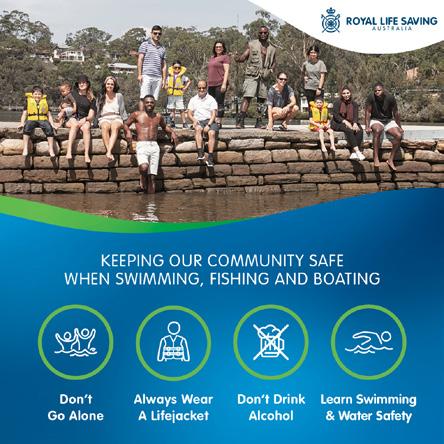

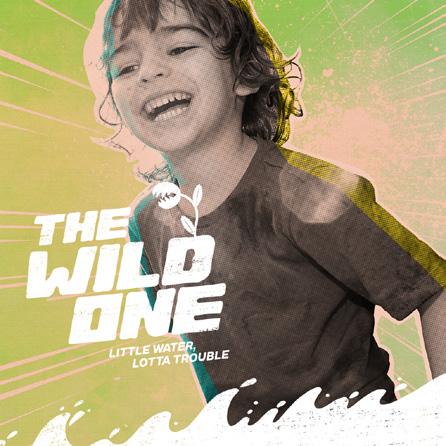

41 With a dedicated social media strategy, Royal Life Saving regularly communicates to and engages with audiences on a range of issues. Key campaigns driven through social media for 2021-2022 include: Keep Watch Make the Right Call Making Safe Decisions Around Water Summer Safety Campaign 145,121 Engagement 424 Number of posts 5,016 Engagement 447 Number of posts 3,795 Engagement 164 Number of posts 5,497 Engagement 201 Number of posts 353,310 Summer Water Safety Campaign Views 5,117,139 208,676 Facebook Impressions Instagram Impressions 152,665 Twitter Impressions 98,439 471,004 Linkedin Impressions Total viewers CONNECT WITH US RoyalLifeSavingAust RoyalLifeSaving RoyalLifeSaving RoyalLifeSaving.com.au RoyalLifeSaving SOCIAL MEDIA CHANNELS INCREASING AWARENESS AND EDUCATING THE COMMUNITY ABOUT DROWNING PREVENTION AND WATER SAFETY
Swimming, Lifesaving, Water Safety Pathway
Building a nation of lifesavers, a community free from drowning. Remember the huddle position, search patterns, lifesaving sidestroke, and swimming in pyjamas. Learning lifesaving in school is as Australian as hot summer days, and gives many the skills and confidence to save a life.
KEY ACHIEVEMENTS
Swim and Survive turned 40
Release of new Swim and Survive Knowledge Modules
Launch of Swim and Survive resources hub for partner organisations
New resources ‘Connecting Abilities’ and ‘Adult Curriculum for Swim and Survive’ to enhance accessibility and inclusion



Development four new online training modules, including communication and CPR
Collaboration with Autism Spectrum Australia for a new online module

New child safety module for frontline staff and managers
Republished Royal Life Saving Lifeguarding and First Aid Manuals
Hosted Australian Pool Lifesaving Championships for the first time since 2020
Australian Life Saving Team win both Open and Youth Overall Point Scores at the Lifesaving World Championships
42

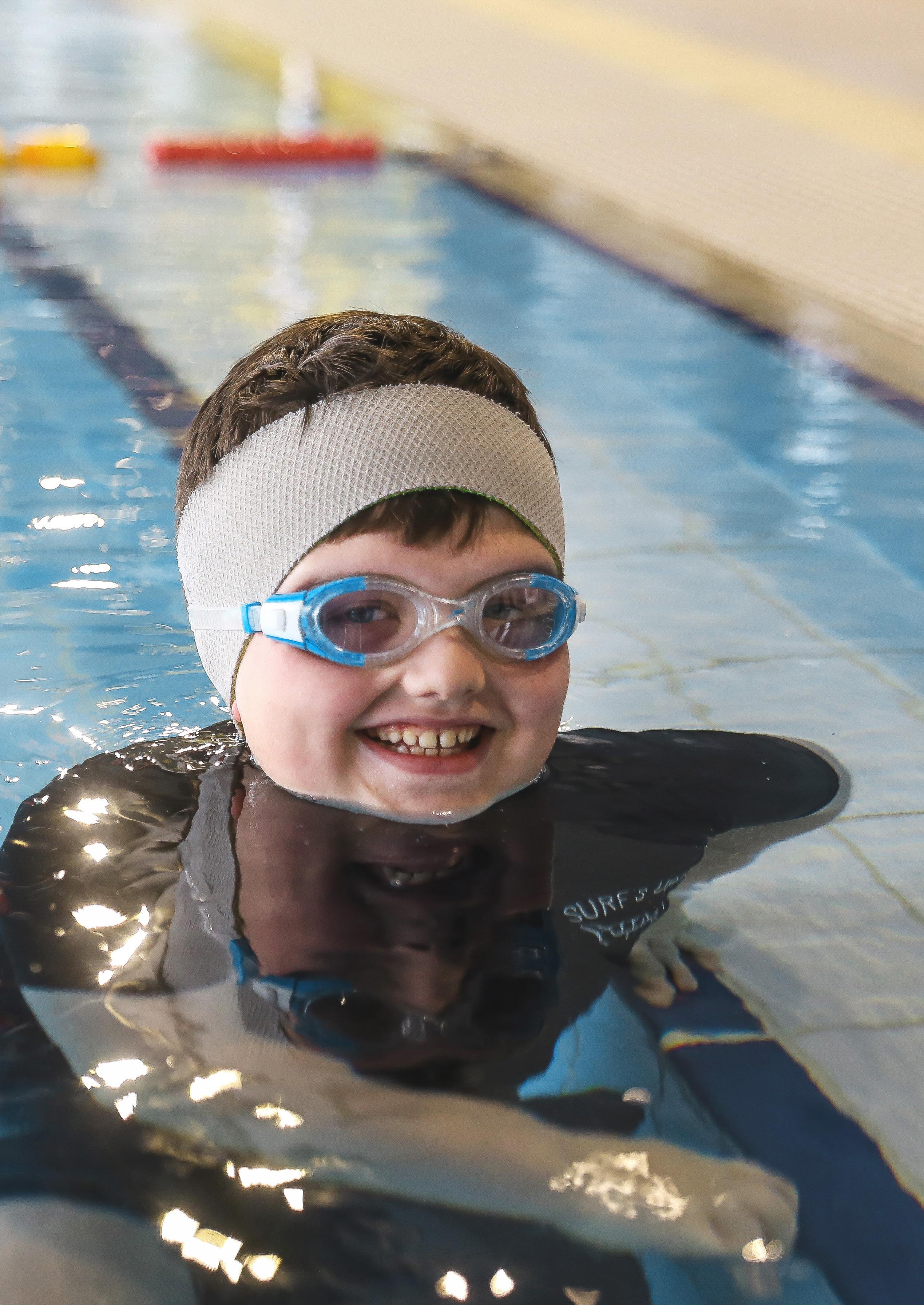
Whether you went through weekly swimming lessons, holiday intensives or school classes, Swim and Survive is at the core of learning to swim.
The stage-by-stage approach, regularly recognising achievements and encouraging children to strive for the next level has proven popular with generations of swimmers.
Royal Life Saving National Manager Education, Penny Larsen said it had been heartening to see so many people hold celebrations at pools across the country.
“It’s wonderful to see how much people have taken the Swim and Survive program into their hearts,” Ms Larsen said.
“Multiple generations of families have been through Swim and Survive and while it has adapted to take on new evidence over the years, at its core it is still about the love of swimming.

“When Swim and Survive started, the team behind developing the program never imagined the effect the Swim and Survive the program would have on the development of swimming and water safety skills of Australians and reducing the drowning rate in children aged five to 14 years. They would have been delighted at the influence of Swim and Survive on the structured swimming curriculum that underpins programs available today.”
In addition to birthday parties, children from across the nation entered a colouring competition and persuasive writing competition.

“We had great trouble judging the competitions because the standard was so high,” Ms Larsen said.

“The time and effort put in by all of the children was impressive. It is so encouraging to read the convincing points made in the persuasive writing competition on why it is important to Swim and Survive.
“It shows that children participating in swimming and water safety education have an awareness of the risks and understand and value of learning to Swim and Survive.”

Royal Life Saving is grateful to Speedo who supplied prize packs for the winning entries.
For further information visit:
SwimAndSurvive.com.au SWIM AND SURVIVE TURNS 40
Hitting the big 4-0 is a brilliant reason to celebrate, especially when you have 15 million people to celebrate with you.
That is how many people across Australia who at some point in their lives learned to swim in the Royal Life Saving Society –Australia Swim and Survive program.
44
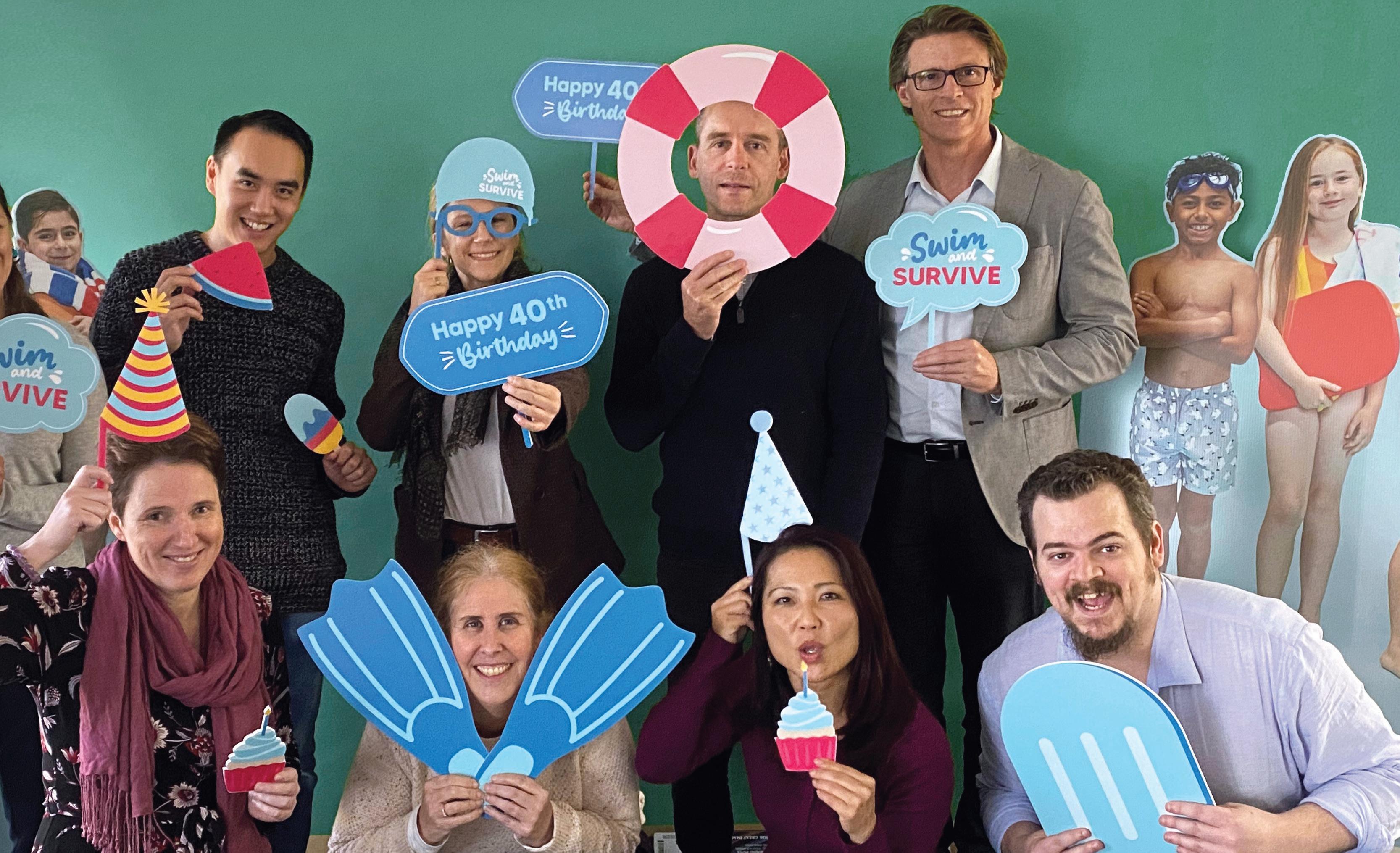


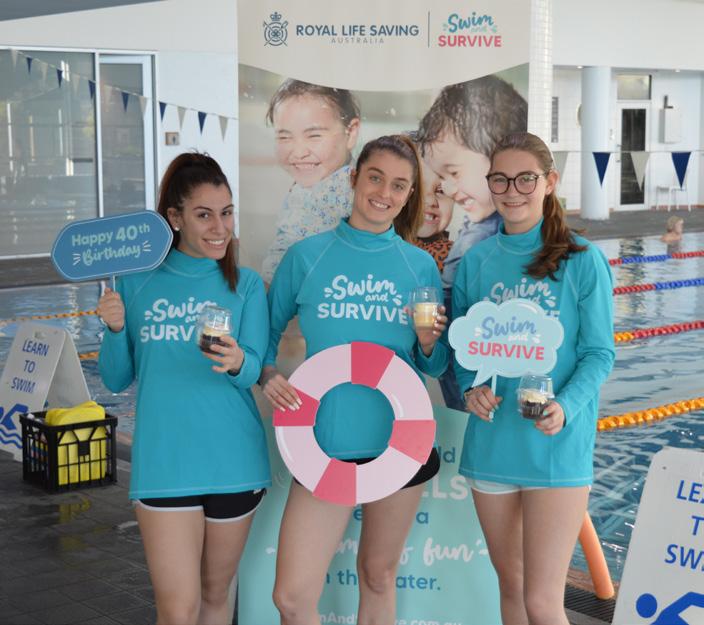

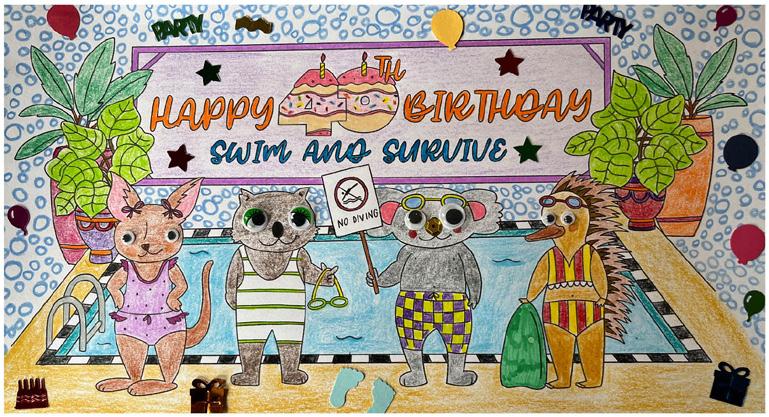
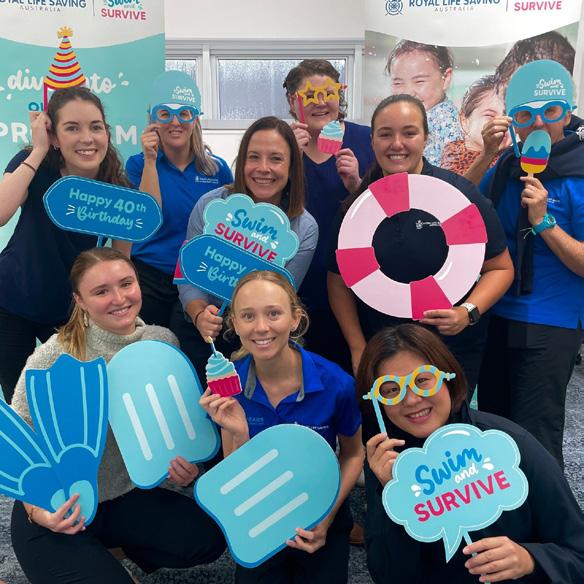

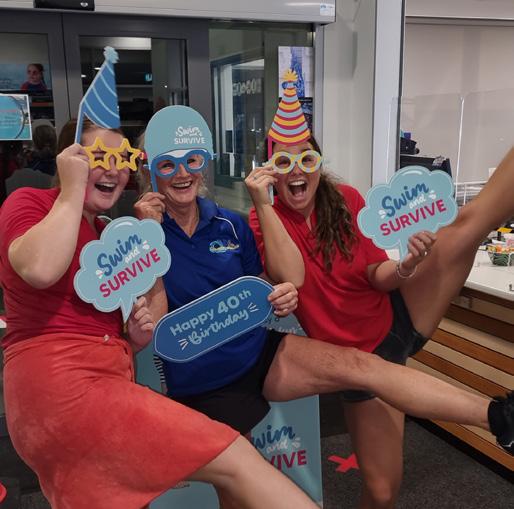
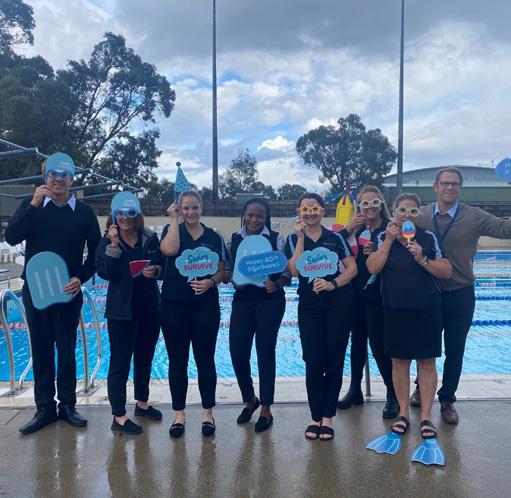
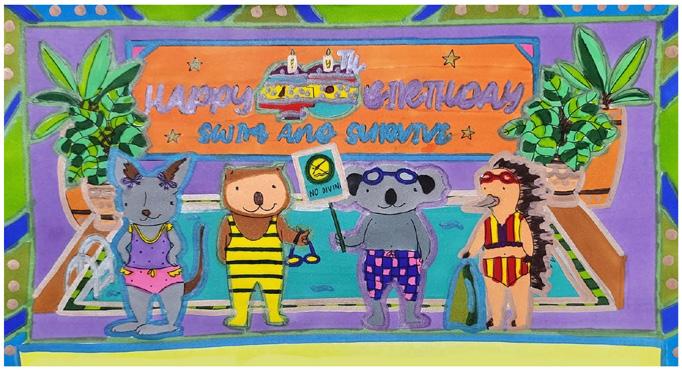

45
Celebrating around the country
Celebrations at Royal Life Saving National Office
Colouring Competition Finalists


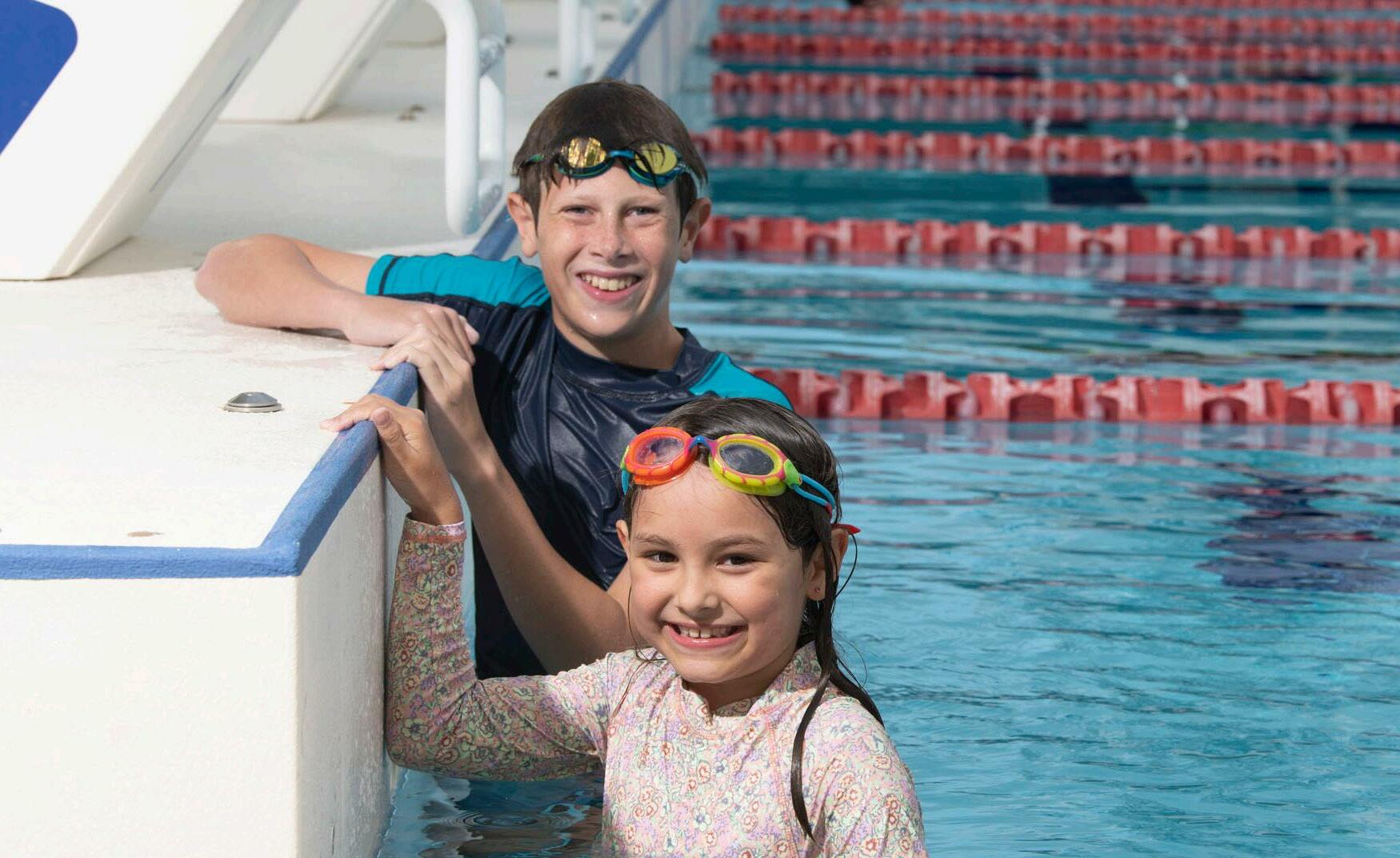
363,698 Swim And Survive 22,548 Bronze Community 9,267 Rescue Strand EDUCATION AWARDS ISSUED
MODULES
A new online water safety program has been launched by Royal Life Saving filled with fun activities for children from kindergarten to year six.
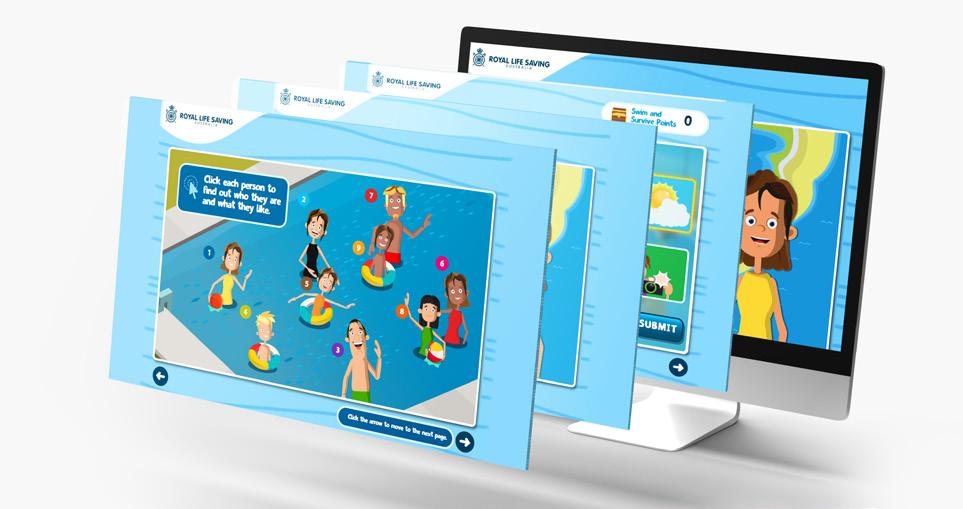
The free Swim and Survive Knowledge Modules are designed to give children the knowledge they need to stay safe around water, supplementing lessons in the pool. Royal Life Saving’s National Manager – Education, Penny Larsen said the modules aim to teach children about the dangers water poses in and around the home or on the farm, as well as aquatic environments that may be in their local communities.
“Children will learn about actions to keep themselves and others safer in and around water, what to do and how to get help in an aquatic emergency, safer methods of rescue and providing care after a rescue,”
Ms Larsen said.
“Each of the nine modules has engaging and interactive activities and by completing these, points are awarded. Depending on how many points they get as they go through the activities, children will achieve trainee, expert or master status.”
At the end of each module they can print off a certificate which indicates their achievement status and how many points they earned.
The Knowledge Modules have clear learning outcomes that are not only linked to the Swim and Survive program, but also to the National Swimming and Water Safety Framework and Australian Health and Physical Education Curriculum. The content in the modules is complementary to the practical swimming and water skills learnt in learn to swim programs.

Ms Larsen said it was easy for parents to register their children to be involved.
“For children already doing the in-water Swim and Survive program at their local swim school, there is a QR code on the achievement certificates which when scanned will take them directly to the website,” Ms Larsen said.
Those not currently participating in Swim and Survive can also access the Knowledge Modules by completing the registration form on the website. Parents can register onto the platform and link their children to their account, so they keep track of their progress through the modules.
Royal Life Saving acknowledges the significant support and funding the Australian Government provides for our water safety education programs.
Learn about the online water safety program: learn.swimandsurvive.com.au


47
SWIM AND SURVIVE KNOWLEDGE
Children learn about actions to keep themselves and others safer in and around water, what to do and how to get help in an aquatic emergency, safer methods of rescue and providing care after a rescue.
SWIM AND
RESOURCES HUB FOR PARTNERS

Royal Life Saving launched a new Swim and Survive Resources Hub to help support our partners across Australia. They don’t just deliver Swim and Survive, they also work together with Royal Life Saving to prevent drowning, provide water safety education and promote safe active participation in aquatic activities.
Swim and Survive is a long-standing and respected swimming and water safety program and brand, and parents can rest easy knowing their child is getting the best water safety education aligned to national benchmarks. In the hub, partners can access resources to support implementation, program management, customer service, marketing and teacher training. Available resources include: Assessment Checklists, Activity Cards, Certificates, Conversion Chart, Curriculum Tables, Enrolment Enquiry Form, Lesson Plans, Must See Guides and Pathway Progression.
CONNECTING ABILITIES AND ADULT CURRICULUM
Two new resources were developed over the past year including ‘Connecting Abilities’ and ‘Adult Curriculum for Swim and Survive’ as a strategy to increase inclusiveness and access.
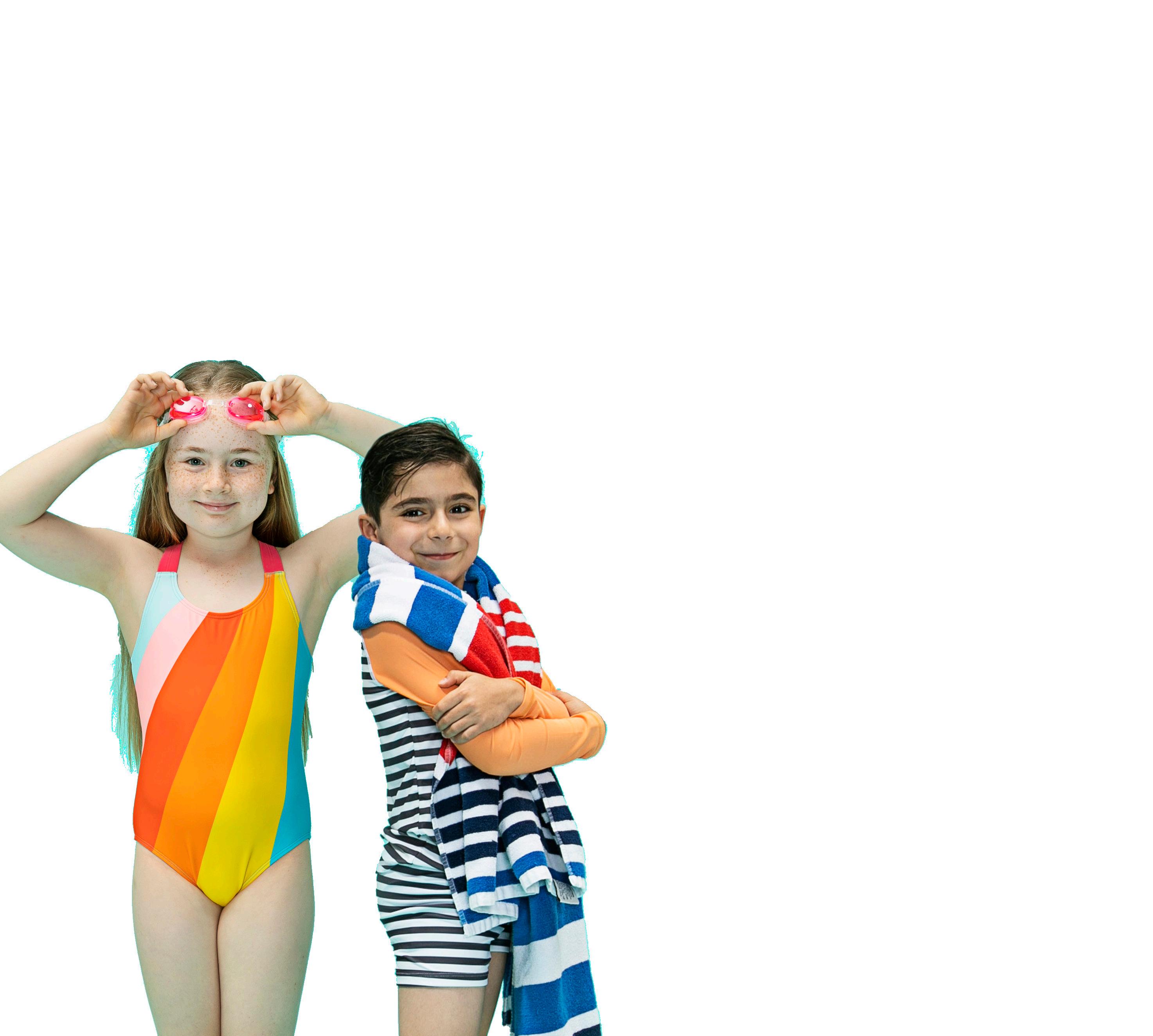
Swimming is for everyone, and to help teachers engage with students who need adjustments to engage with mainstream swimming lessons, new resources were developed and launched as Connecting Abilities.

Connecting Abilities aims to provide reasonable adjustment for students who have (or may eventually have) the physical ability, cognitive function, and the comprehension of safety skills to take part in a swimming lesson with other students. A reasonable adjustment is a measure or action taken by a provider or education deliverer to assist a person with disability to participate on the same basis as a person without a disability.
Support resources include:
• Group Classification including suggestions for adaption for each group
• Reasonable Adjustment Matrix
• Teaching Strategies
• Tips for Reasonable Adjustment

We encourage all Swim and Survive teachers to utilise the Connecting Abilities resources, available in the Swim and Survive Resource Hub.
A specific curriculum for adults and teens has been developed as part of the Swim and Survive suite of resources to provide a pathway of participation particularly for those that may be late starters or not had the opportunity to learn swimming and water safety at a younger age. The curriculum is broken up into four levels starting with foundation skills for beginners and progressing to more advanced skills to enable people to have the capability of completing lifesaving and career training programs.
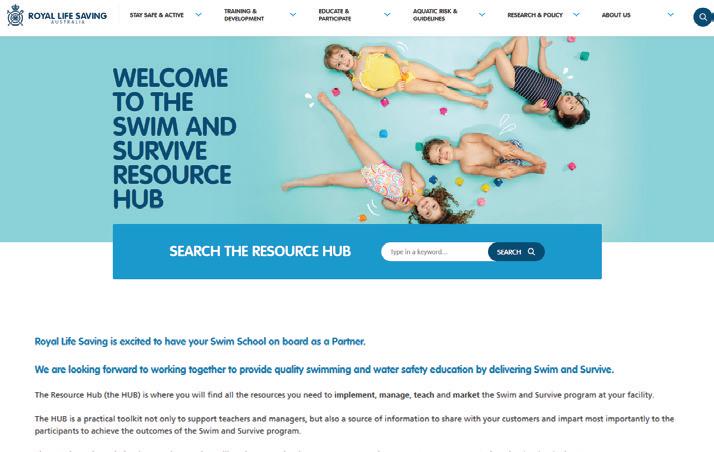
48
SURVIVE

49 TRAINING AWARDS ISSUED 16,613 Pool Lifeguard 55,263 Resuscitation Bronze Medallion 3,812 4,147 Swim Teacher Aquatic Technical Operator 799 First Aid 26,417
The Training and Workforce Development Committee has continued to build on a growing culture of collaboration and coordination in vocational training and workforce development activities and operations.
This has contributed to helping the Royal Life Saving Registered Training Organisations manage the transition to a post-pandemic operating environment and to seize resulting opportunities, in particular with regard to funded training programs that form an integral component in helping the aquatic industry to renew and rebuild its workforce.
The sport, fitness, aquatics and recreation products within the Sport and Recreation Training Package have been subject to an extensive review process over the past 12 months and Royal Life Saving has played an important role in shaping the outcomes of key training products: Pool Lifeguard, Swim Teacher, and Aquatic Technical Operator.
This was achieved through Royal Life Saving national office’s membership on the Sport and Recreation Industry Reference Committee and by having a representative from Royal Life Saving Western Australia and Royal Life Saving New South Wales on the Technical Advisory Committee, specifically formed to gather industry expertise in the design of the new training products.
While the products have not yet been published, we expect that there will be a new Inland Open Water Lifeguard Skill Set. We expect this skill set, along with the updated pool lifeguard skill set will contain a new, purpose designed unit of competency, Provide oxygen resuscitation and therapy in an aquatic environment.
Royal Life Saving played a critical role in bringing about these changes, which we believe are significant and positive developments for the aquatic industry.
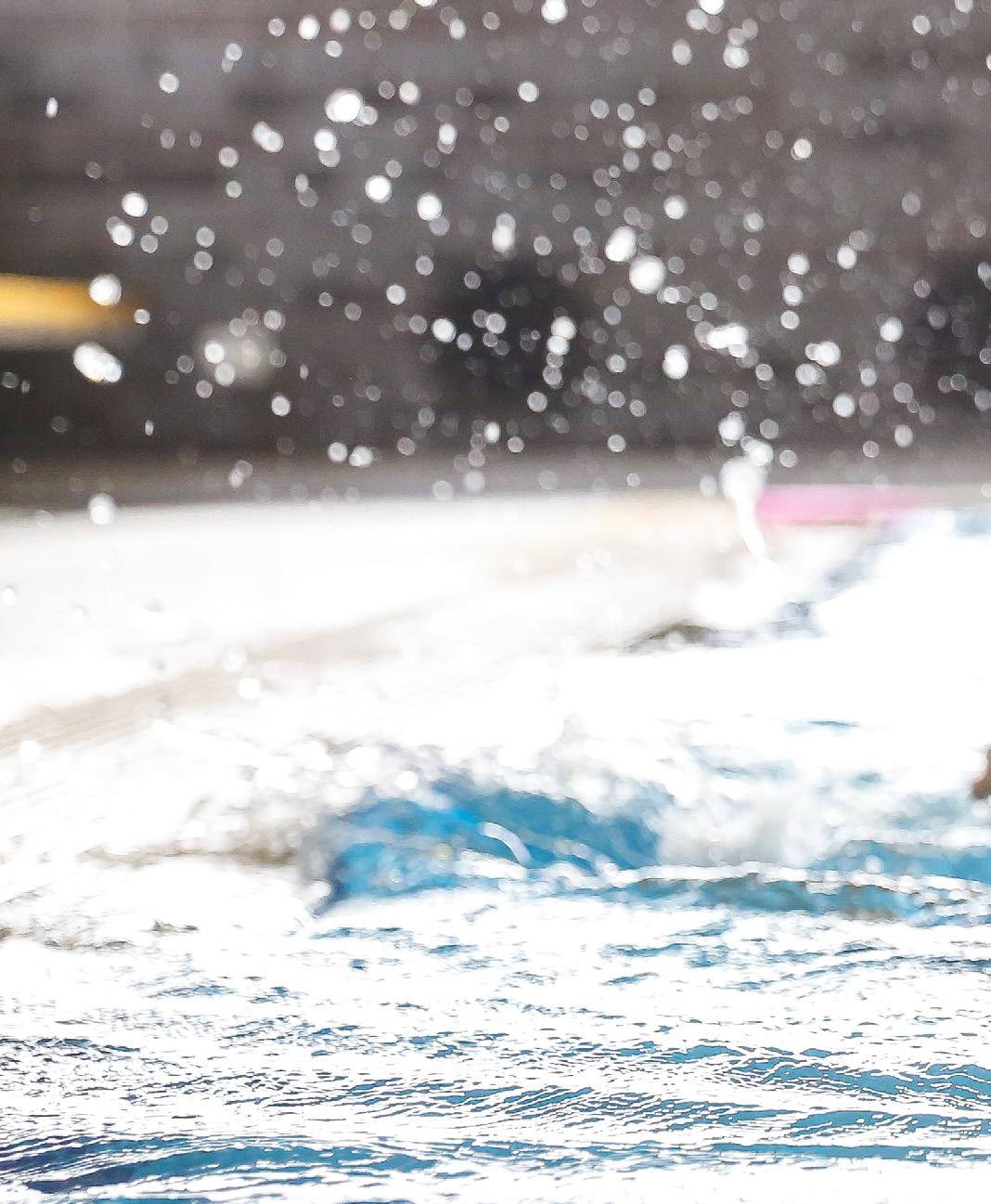
The Committee completed several online learning projects over the course of 2021-22. These include:
Communication Skills: This module centres on scenario-based learning contextualised to the aquatic industry. It uses typical interactions experienced by lifeguards, swim teachers, and customer service staff to demonstrate how and why communication can go wrong and how to manage these critical interactions.
CPR / First Aid: A redesign and significant technical content update to the suite of first aid training products. The modules have a new look and feel, aligned with our updated branding, and a range of new screen designs and interactions designed to enhance learning and the overall learning experience.
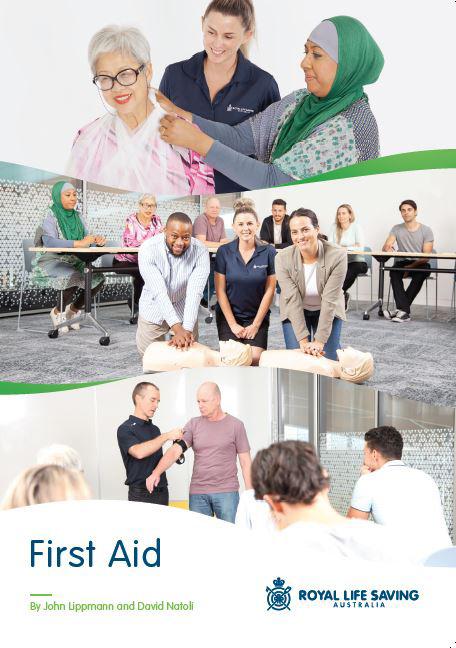
Child Safety Modules: Two professional development modules aimed at improving individual and organisational know-how on child safety in the aquatic industry.



Swim Teaching For Participants On The Autism Spectrum
The Committee worked collaboratively to update the First Aid Manual and Lifeguarding Manual, incorporating new content and updates to technical practices as well as new imagery and updated front covers.
50
COMMITMENT TO TRAINING AND WORKFORCE DEVELOPMENT ACROSS AUSTRALIA
Below: Swim Teaching for Participants on the Autism Spectrum
Children on the autism spectrum are three times more likely to drown than those that are not –but this can be addressed through specialised swim teaching and learn to swim programs.
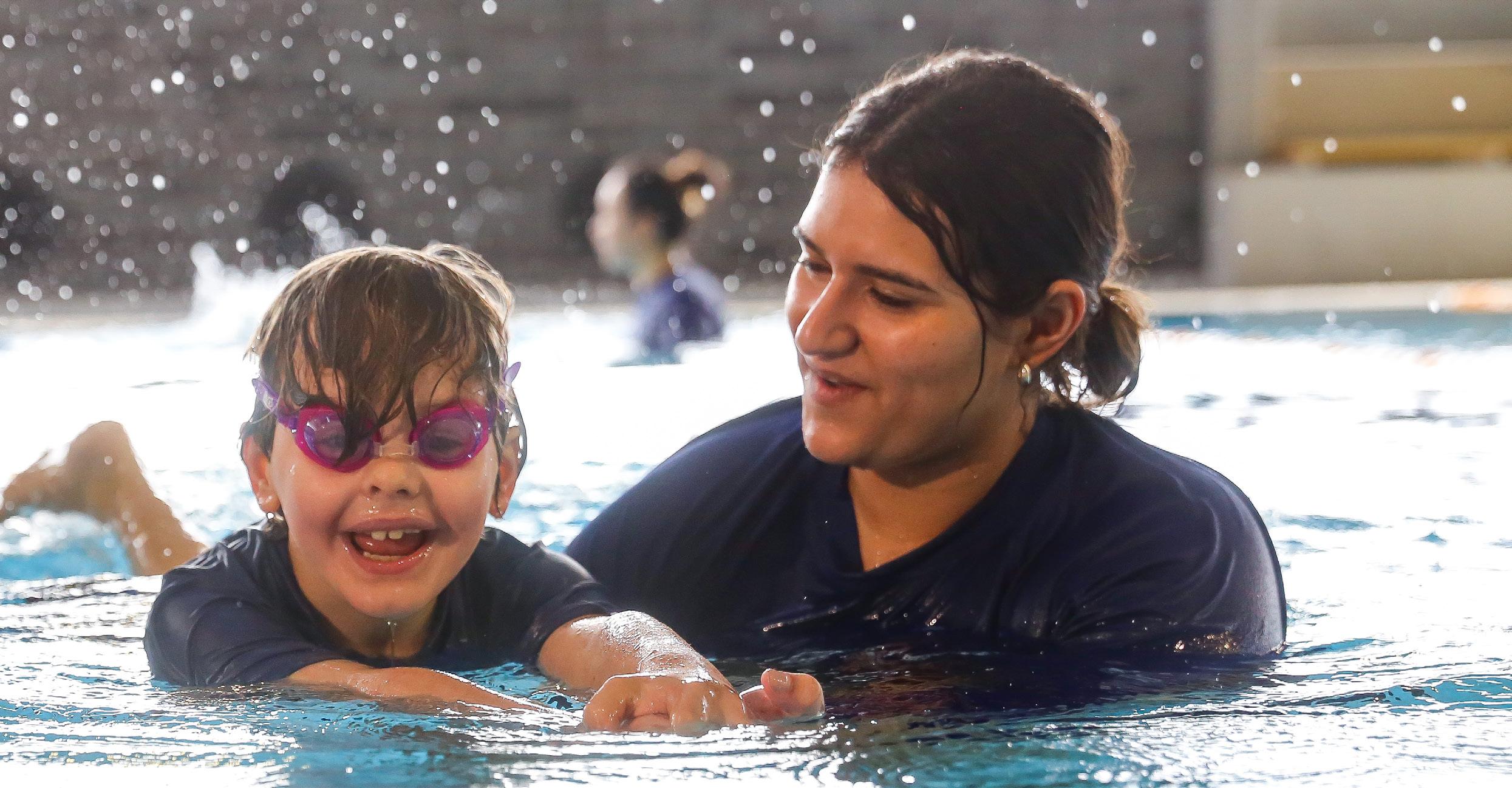
Royal Life Saving, in partnership with Autism Spectrum Australia (Aspect), has just released a new online module aimed at improving swim teachers’ knowledge and skills when it comes to swimming lessons for people on the autism spectrum.
Shaun Jackson, National Manager - Training and Workforce Development at Royal Life Saving said the research showed that lack of swimming skills contributes to the higher-than-average drowning rates.
“We know that many children on the autism spectrum, and their parents or carers, have had a bad experience as they start out on their learn to swim journey – and that this means many have stopped before they really got started,” Mr Jackson said.
“With this online module we wanted to develop an easily accessible learning resource that will give swim teachers a good understanding of autism, considerations in a learn to swim context, and some simple but specialised strategies and techniques to ensure participants enjoy their lessons and develop those critical swimming and water safety skills.”

Throughout the module there are interviews with children on the spectrum that are learning to swim, their parents or carers and their swim teachers.
Along with regular video interviews learners will discover that the module has a very visual focus using footage of swim lessons in action and a range of screen designs, interactions, animations, reflection tools and knowledge checks to maximise engagement and learning. It is designed to give swim teachers that are starting out in this area of specialised teaching, or those with experience looking to test and update their knowledge and skills, the ability to move forward with confidence and clarity and deliver highly effective and enjoyable lessons.
Royal Life Saving national office is grateful for the support of Royal Life Saving Western Australia, and all the members of the Training and Workforce Committee who diligently reviewed and commented on the module throughout its development.
“Our team is passionate about creating partnerships with organisations that directly and meaningfully improve outcomes for people on Autism Spectrum. Making small changes to the ways we work and think can have a huge impact on the safety and enjoyment of Autistic people when swimming. Royal Life Saving went above and beyond in working together with our Autistic consultants when developing this module, to ensure the content was both respectful and helpful.’
Rebecca Street Autistic Consultant Aspect
To view training details: royallifesaving.com.au/ training-development/ professional-development/swimteaching-for-participants-on-theautism-spectrum
TEACHING PEOPLE ON THE AUTISM SPECTRUM
NEW ONLINE TRAINING ON CHILD SAFETY FOR THE AQUATIC INDUSTRY


Royal Life Saving Society – Australia has released two new online modules aimed at improving individual and organisational know-how on child safety in the aquatic industry.
The aim is to educate all aquatic industry staff, whether paid or volunteer, to ensure children are safe from abuse.
Royal Life Saving’s National Manager - Training and Workforce Development, Shaun Jackson said the new modules were designed to meet the needs of all aquatic industry staff, with one module designed for frontline staff and the other for management.
“The modules provide information and practical advice on how to prevent abuse and recognise and respond to instances where children may be in danger of abuse,” Mr Jackson said.
The version for frontline staff is designed for swim teachers, program instructors, pool lifeguards, and any other staff or volunteers that come into regular contact with children through their role at an aquatic facility, swim school or similar organisation.
The management version looks more closely at what can be done at an organisational level in terms of instilling and promoting a child safe culture. The module uses the 10 Child Safe Standards as a guiding framework and includes information on effectively managing risks to children’s safety at all levels.
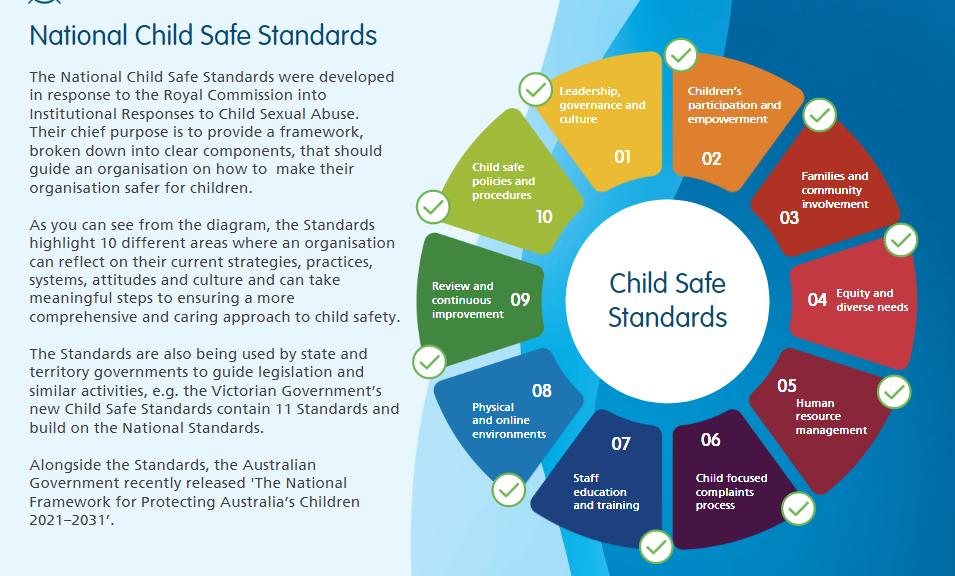
To view training details: royallifesaving.com.au/training-development/ professional-development/Child-Safety
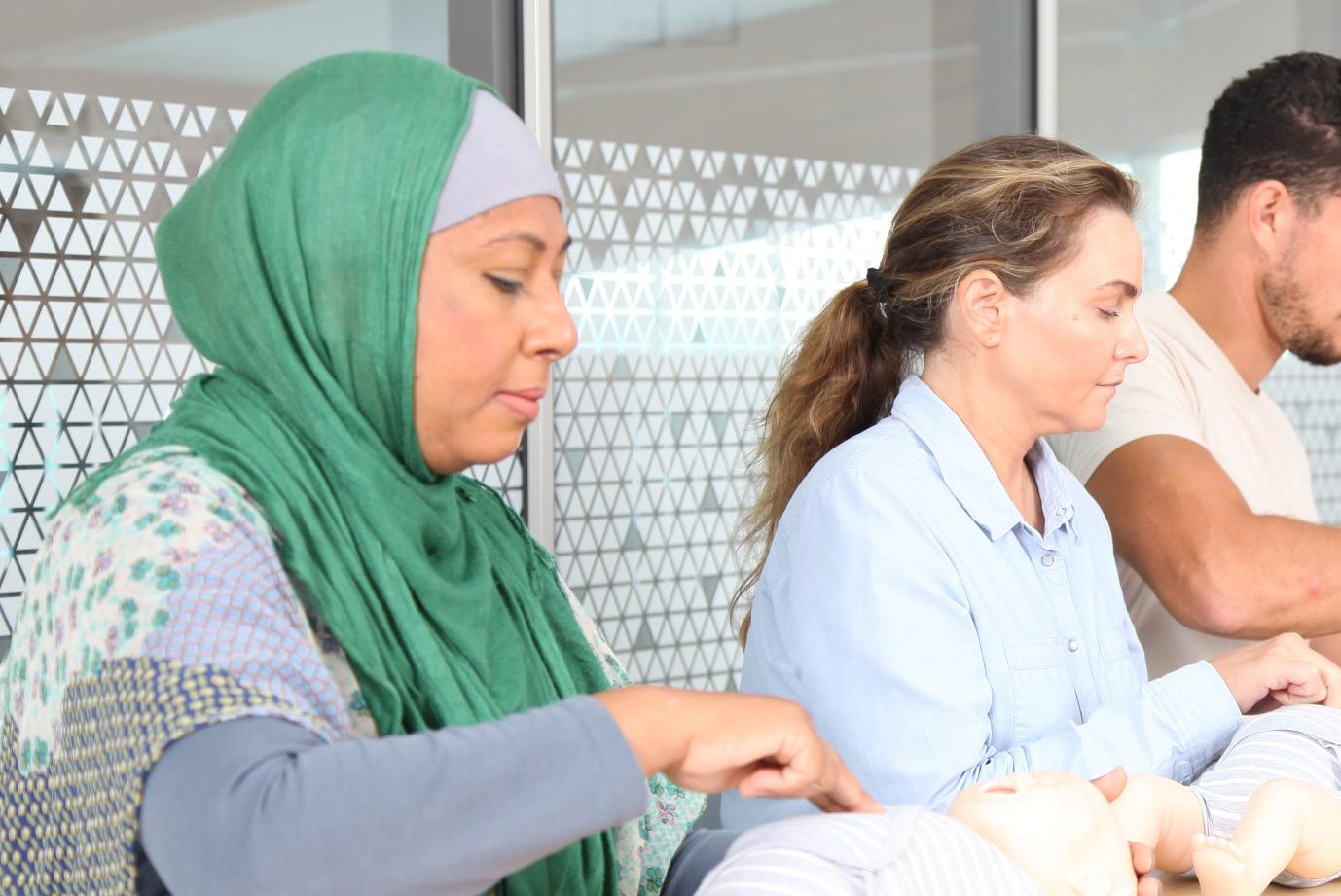
52
MANUALS UPDATED WITH FRESH IMAGES TO REFLECT CHANGING PRACTICES

Royal Life Saving’s national office in partnership with Royal Life Saving NSW carried out a photo and video shoot over two days at the Royal Life Saving NSW Aquatic Academy in Denistone East and Auburn Ruth Everuss Aquatic Centre.
Images and video covering a broad spectrum of pool lifeguarding and first aid scenes and scenarios were taken. The services of Studio One Another and Buzz Films were used.
The images and video have been used for promotional materials and campaigns as well as part of the annual updating of Royal Life Saving key training publications and course materials, such as the Lifeguarding Manual and eLearning resources, and First Aid Manual and eLearning resources.
The Royal Life Saving Lifeguarding Manual and First Aid Manual continue to be seen as industry benchmarks and are used as a key resource in training courses and on-the-job practice.
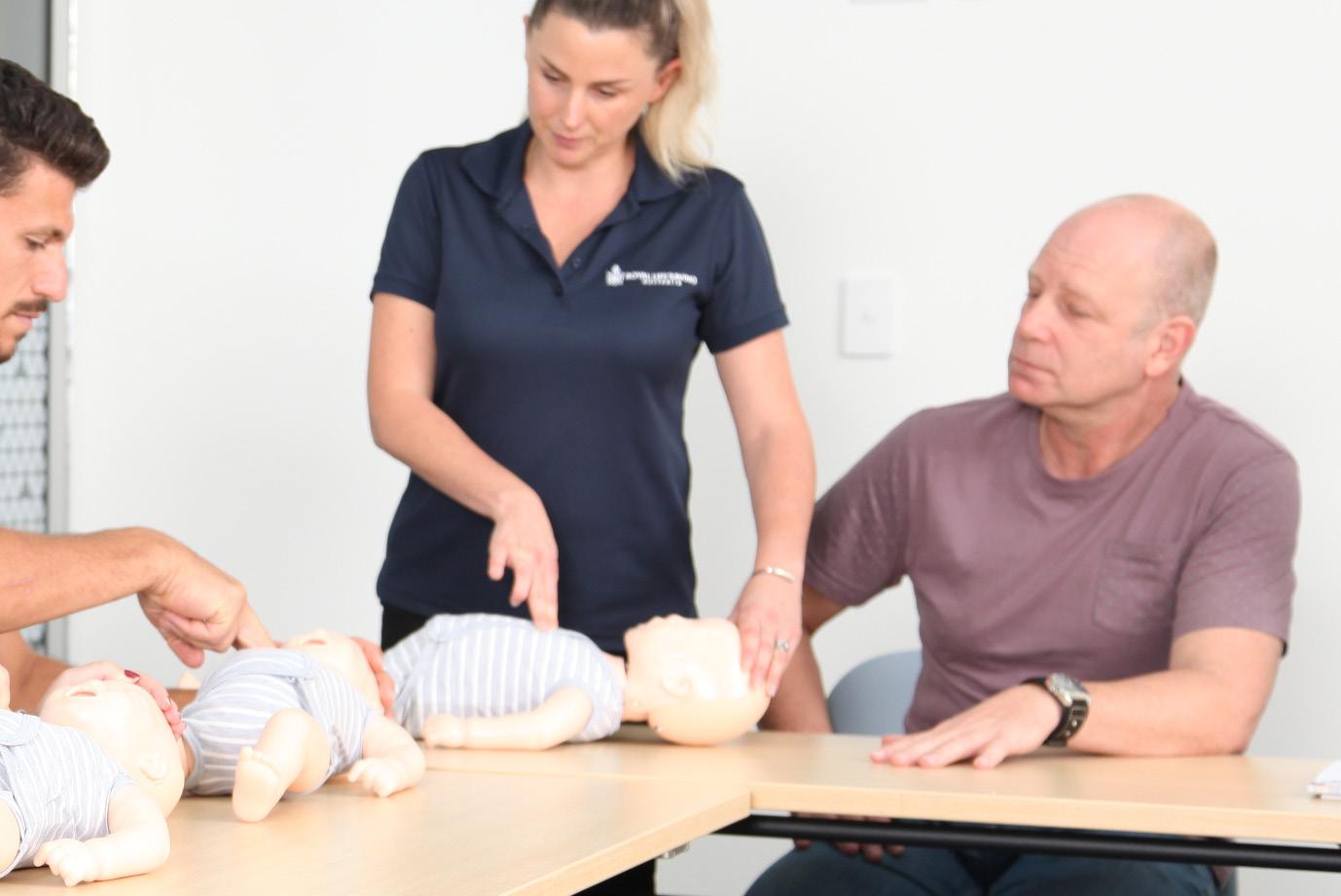

Both manuals were updated and republished in 2022 to reflect changes in best practice and technical guidelines and these updates accompany similar updates to the eLearning modules that form an integral part of the pre-course, knowledge-based training for participants that enrol in Royal Life Saving CPR, Basic Emergency Life Support, First Aid and Pool Lifeguarding training courses.
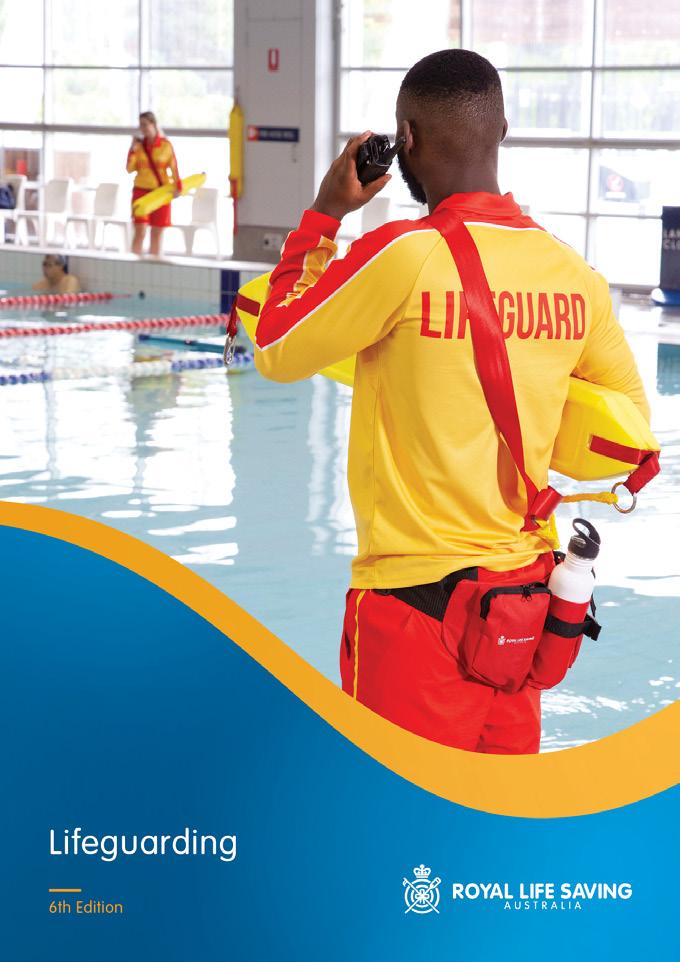
53
After the cancellation of Pool Lifesaving events across Australia and internationally during the COVID-19 pandemic, sport roared back to life in 2022, with both the Australian Pool Lifesaving Championships being held for the first time since 2020, and Lifesaving World Championships in Riccione, Italy.
National Sport Adviser, Geoff Grey said that after the widespread disruption to sport caused by the COVID-19 pandemic, it was exciting to welcome old and new faces back to the pool.

“Not only do the Championships provide an opportunity to showcase the sport of pool lifesaving – it’s a time to celebrate the skills, expertise and dedication of our members, and their contribution to lifesaving in Australia and abroad,” Mr Grey said

Australian Pool Lifesaving Championships
The Australian Pool Lifesaving Championships wrapped up in Sydney in June 2022 after an intensive three days of competition hosted at Pymble Ladies College Aquatic and Fitness Centre. This event was last held in January 2020 in Western Australia, with the COVID-19 pandemic halting the national competition in 2021 and delaying 2022.
The Championships test each competitor’s abilities in lifesaving through a series of challenge events that simulate real lifesaving situations and emergencies. These events include the Manikin Carry, Manikin Tow, Line Throw, Obstacle Swim and the Simulated Emergency Response Competition (SERC) – a timed event where lifesavers are tested on their initiative, judgement, knowledge and skills. All the events are based on rescuing a person who is in immediate danger.
The Interstate Overall Championship and the Sir Percy Joske Trophy was awarded to the New South Wales Team who dominated the competition for the sixth time.

Officials
The Pool Lifesaving Championships wouldn’t be possible without the volunteers who ensure the event runs smoothly. Whether it’s timekeeping, judging, or providing assistance to the teams, every volunteer gives their all during the Championships. We recognise the early starts, late nights and intense days and thank all the officials for their support.
Key Officials
Chief Referee Joanne Teagle
CPR Coordinator Mary Collins
SERC Coordinator Brione Rundle Equipment Coordinator Brendan Watts
David Laws from Victoria was awarded Official of the Meet by Chief Referee Joanne Teagle.
54
SPORT
Female Lifesaver of the Meet - Jess Oates
The competition saw the three top-placed women for the meet divided by only one point. Jess Oates, 19, from Dakabin in Queensland came away with the Female Lifesaver of the Meet which was based on her performance across all the open age events, with athleticism and technical accuracy both taken into account.
Ms Oates trains with the Sunshine Coast Grammar Pool Lifesaving Club. “After two years of not being able to have a national competition due to the pandemic, it was really exciting to see everyone again and compete on the national stage,” Ms Oates said.
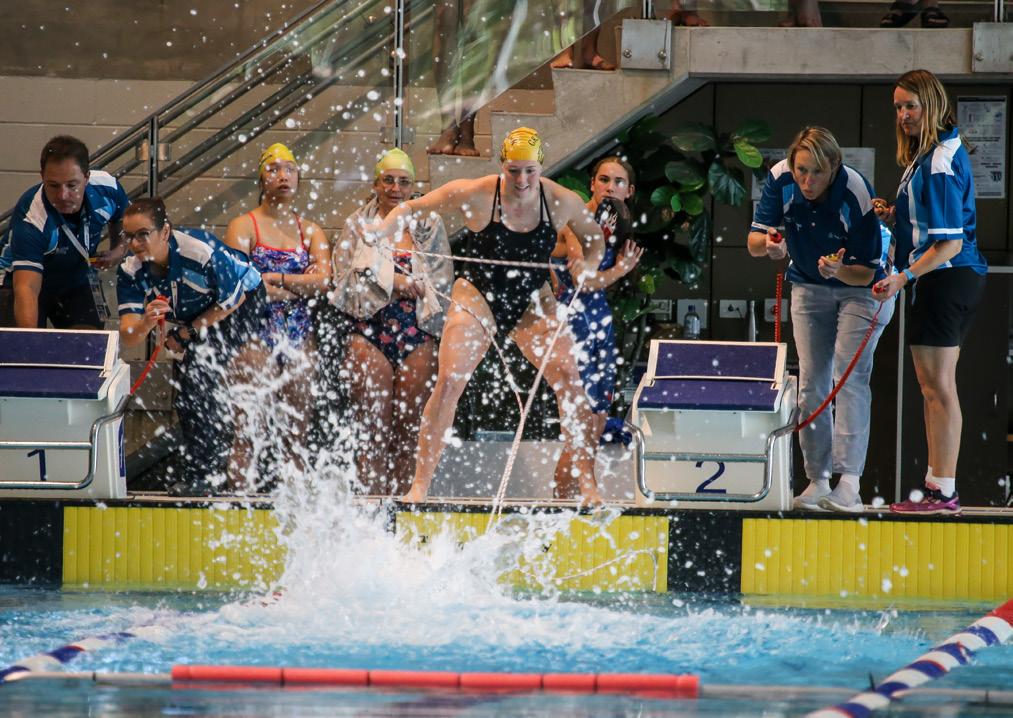
Male Lifesaver of the Meet - Jake Smith
Mr Smith, 24, from Hillarys in Western Australia put in a strong performance across all three days. Male Lifesaver of the Meet award was based on his performance across all the open age events, with athleticism and technical accuracy both taken into account. Mr Smith trains with the West Lifesaving Club and the Scarborough Beach Swimming Club.
Ms Oates trains in the pool six days a week, in addition to gym sessions. She first became involved in pool lifesaving at just 12 years old.
Mr Smith does at least seven training sessions in the pool a week, in addition to gym sessions. He was first introduced to pool lifesaving competition at just 14 years old when a coach recognised his swimming ability.
He acknowledged his coaches Andrew Ridley, Bec Hartman and Cam Hawthorn who work with Mr Smith throughout the year.

CPR Competition
The CPR competition is an integral part of the Championships and highlights the outstanding ability of our competitors to perform efficient and effective CPR in an aquatic environment. This event is a test of resuscitation on an assumed drowning patient, using CPR training manikins. Judges are provided with live data on the competitors performance throughout the test, using Laerdal’s Little Anne QCPR manikins and Skill Reporter technology. At the 2022 Championships, of the 93 competitors in the CPR competition, 55 achieved a score of more than 85 per cent. This knowledge and application of CPR provides potential patients with the best possible chance of survival.
The support of Laerdal as the CPR competition sponsor is greatly appreciated.
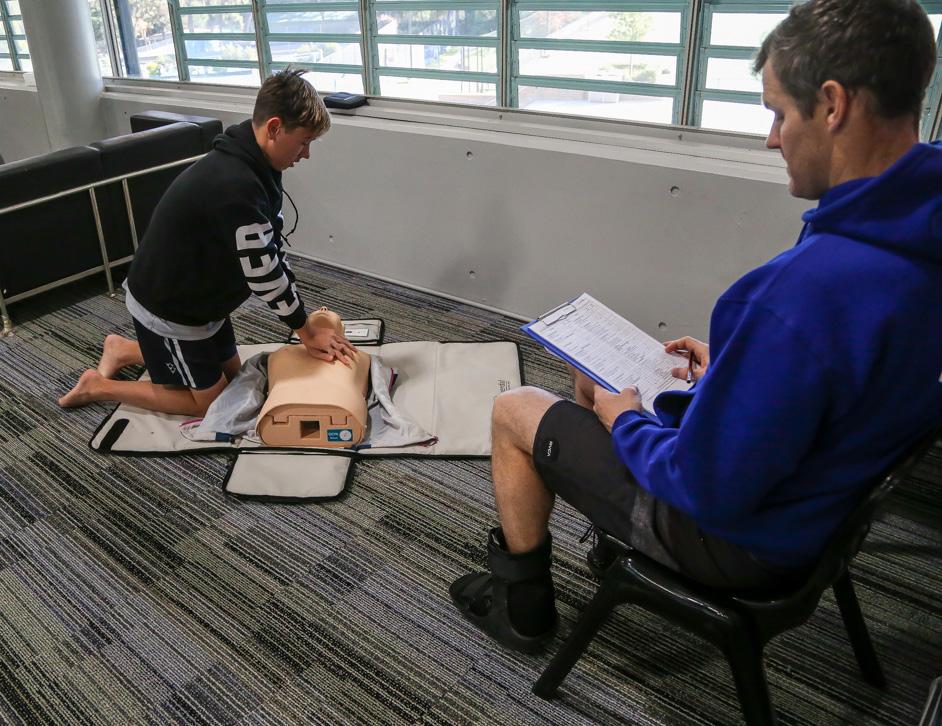
55
“It is the people that make this sport, the sense of community as part of the team. That’s something I have not experienced in any other sport.”
“It’s been a while since had a good outing at a national competition due to COVID-19, so it was good to see everyone,” Mr Smith said.
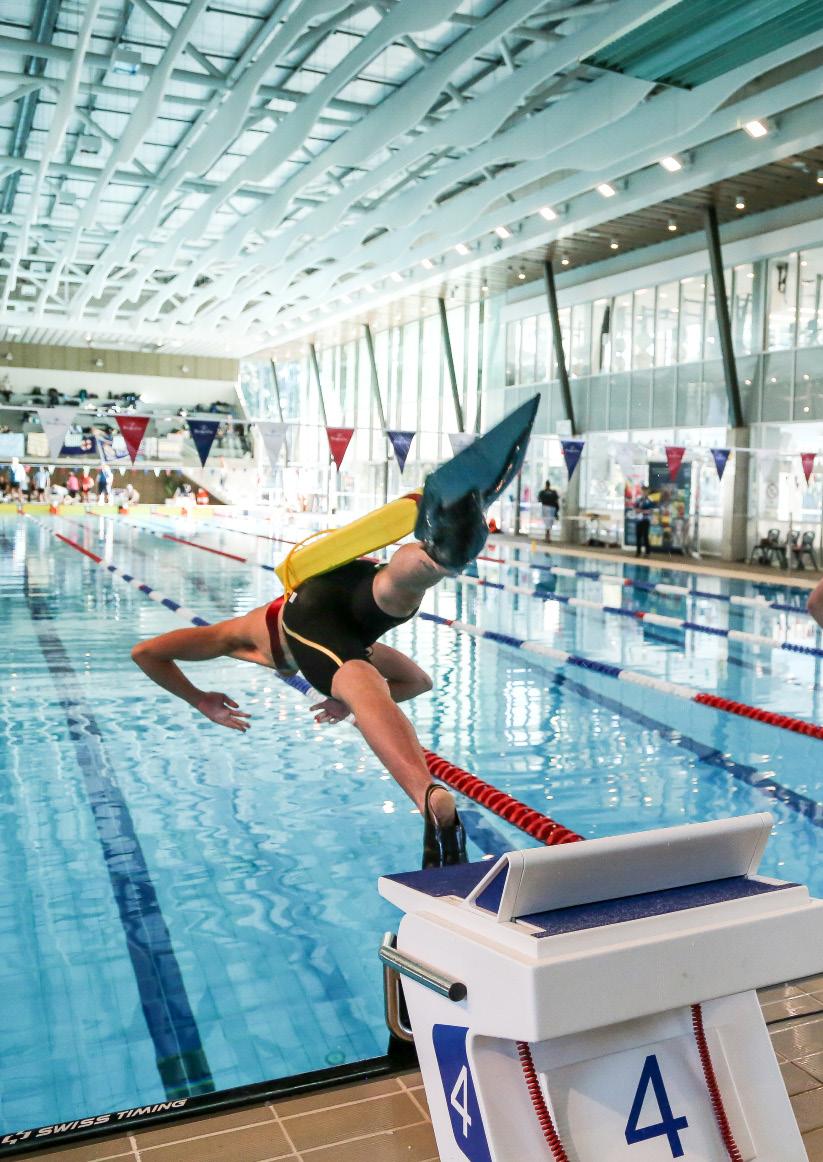


International Victory


The Australian Life Saving Team have become the first nation to win both Open and Youth Overall Pointscores at the same Lifesaving World Championships after comprehensive performances by both teams at the 2022 Lifesaving World Championships in Riccione, Italy.
Since the inception of the competition at the Lifesaving World Championships in 2012, no nation has been able to claim both Open and Youth titles at the same event. The Open team won its second consecutive World Championships by a margin of 150 points over rival New Zealand, following a 37 points victory at Lifesaving World Championships 2018 in Adelaide, the last World Championships prior to COVID-19 disruptions.
A four year wait, and lack of significant international competition, presented plenty of challenges to the Australian Lifesaving Team in the lead up to the World Championships 2022. However the Aussies produced one of the most dominant performances at a World Championship event, winning eight gold medals across Pool Rescue Events and collecting a further 13 gold across ocean and beach events.
The Australian Youth Life Saving Team completed their own dominant campaign in Riccione, finishing with their largest margin of victory at World Championships with a 278-point lead over second place New Zealand.

Accumulating 977 points over six days of competition, the Youth Team won 17 gold medals, led by a dominant group of female athletes who claimed eleven of those golds and a Youth World Record in the pool.
Youth team co-captain Chelsea Jones (Royal Lifesaving NSW), Claudia Bailey, Lily O’Sullivan, and Cyra Bender returned home to Australia with a World Record under their belt after shaving time off the previous best in the 4 x 50m Manikin Relay.
Callum Brennan (Sunshine Coast Grammar Pool Lifesaving Club) won six silver medals in a Pool Rescue events, often just behind a strong Italian contingent who broke four youth world records at the Championships.
The Lifesaving World Championships will next be held in 2024, where more than 40 nations will compete on the Gold Coast, Australia.
While the athletes are the stars of the pool, beach and ocean at the World Champs, competition could not go ahead without the dedicated Officials and volunteers that travelled from across the globe. Pictured are Royal Life Saving Officials Mary Collins and Anne-Maree Gardiner AM poolside in Italy.

57
Safer Aquatic Locations
We are championing safety in all aquatic environments through risk management, industry development and training initiatives. 2021-22 was a very busy year for the aquatic industry and consequently for Royal Life Saving’s Aquatics portfolio. From projects to assist with the re-opening of the aquatic industry, to supporting our State and Territory Member Organisations in coordinating efforts towards safer aquatic locations, there were many key achievements worth celebrating.
KEY ACHIEVEMENTS
Successful advocacy (in some States/Territories) for funded support for swim teacher and pool lifeguard training as part of JobTrainer.
A review of Industry Training Packages, including Provide oxygen resuscitation and therapy in an aquatic environment and Equipment for Lifeguard Training – Discussion Paper which was instrumental in development of new unit of competency in the pool lifeguard skill set.
Development of local water safety planning capability and resources.
Child Safety and Communication Skills industry professional development modules were developed and launched.
The new Communication Skills for the aquatic industry professional development module was launched in October 2021.




Updated online pre-course modules for Provide CPR, Provide basic emergency life support and Provide first aid launched.
New draft Inland Waterways Guidelines were released. The release of new research including the Social Impact of the National Aquatic Industry, Equal Access to Public Aquatic Facilities: Guidance for Local Councils, Facility Managers and the Aquatic Sector, and Australian Policy and Case Law for Public Safety in Inland Waterways: A Review and Recommendations.
58

The past 12 months have remained challenging for the aquatic industry as it begins its recovery from the COVID-19 pandemic. Significant challenges soon emerged which in some parts are still unresolved:
Workforce shortages
Children not returning to lessons
Loss of talent / corporate knowledge
Rising cost of living / inflation providing upwards pressure on salary expectations
Difficulty re-qualifying staff who had missed two years of training
Post-lockdown shortages of qualified lifeguards and swimming teachers slowed down the industry’s efforts to rebuild after the COVID-19 pandemic. Many pools are still struggling to find qualified staff to deliver water safety and swimming skills, as well as lifeguard services. This is a significant issue for an industry which really struggled to survive ongoing and sustained lockdowns.
COVID-19 has also amplified long-held concerns about falling swimming and water safety skills in primary school aged children. After two years of widespread pool closures and more than 10 million missed swimming lessons, Royal Life Saving is urging parents to enrol children in swimming lessons to avoid another summer of drowning.
Royal Life Saving analysis of enrolments of children in swimming lessons in November 2021 showed they decreased by at least 25 per cent nationwide compared to the same time the previous year, with the greatest impact among children aged between seven and 12 years old. Many are unlikely to return to swimming lessons. Previous Royal Life Saving research has reported that 75 per cent of children stop swimming lessons from eight years and around 40 per cent of children leave primary school without being able to achieve key swimming and water safety benchmarks.
Ordinarily, the school system is a critical safety net for children who cannot afford private swimming lessons. New AusPlay data also highlights that swimming lessons in school children (ages 5-14) are down 12 per cent from 2019 levels.
This data supports Royal Life Saving research reporting that many children may have stopped lessons altogether after COVID-19 forced the closure of aquatic centres across the country over the past two years, and highlights how in addition to the aquatic industry, schools need to re-prioritise in-water swimming and water safety activities for students with urgency.
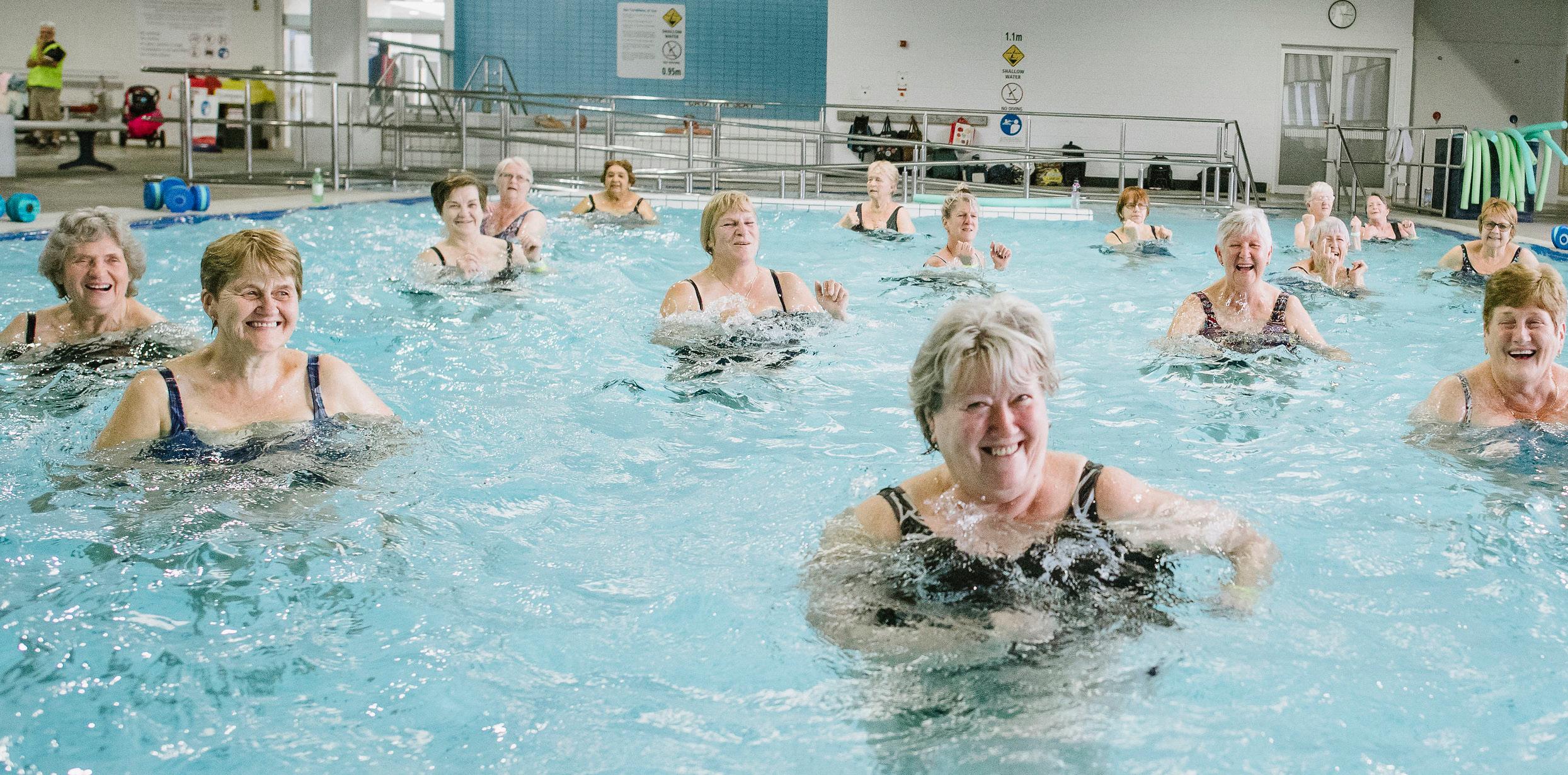
These factors all lead to a system which is strained and unable to ensure all Australian children are able to participate in swimming and water safety lessons, as well as communities unable to participate to their full potential in aquatic physical activity.
These concerning trends are likely to lead to future impacts on the health system, higher rates of drowning in the future and a quality of life which misses its prepandemic levels. Australians love the water, and a vibrant and strong aquatic industry is vital to ensuring full physical activity participation and safety for all into the future.
In light of these challenges, supporting the aquatic industry and its workforce remains a key strategic priority for Royal Life Saving.

AQUATIC INDUSTRY REOPENS
GSPO

MILESTONES
This year marked 30 years and 25 years respectively of Royal Life Saving having implemented and maintained the Guidelines for Safe Pool Operations (the GSPO) and Aquatic Facility Safety Assessments (AFSA).
Intended to be voluntary, the Guidelines were created in 1991 to provide locally-developed, practical guidance for the safe operation of swimming facilities and aquatic locations. Safety Assessments were created in 1996 to assist aquatic facility owners and operators measure their success in managing risk and preventing serious incidents.
Together, the GSPO and the AFSA have:
• helped aquatic facility owners and operators be protected from the imposition of inappropriate standards.

• driven down both drownings and aquatic based injuries in public aquatic facilities.
• provided a standard by which to measure safety performance for the sector.
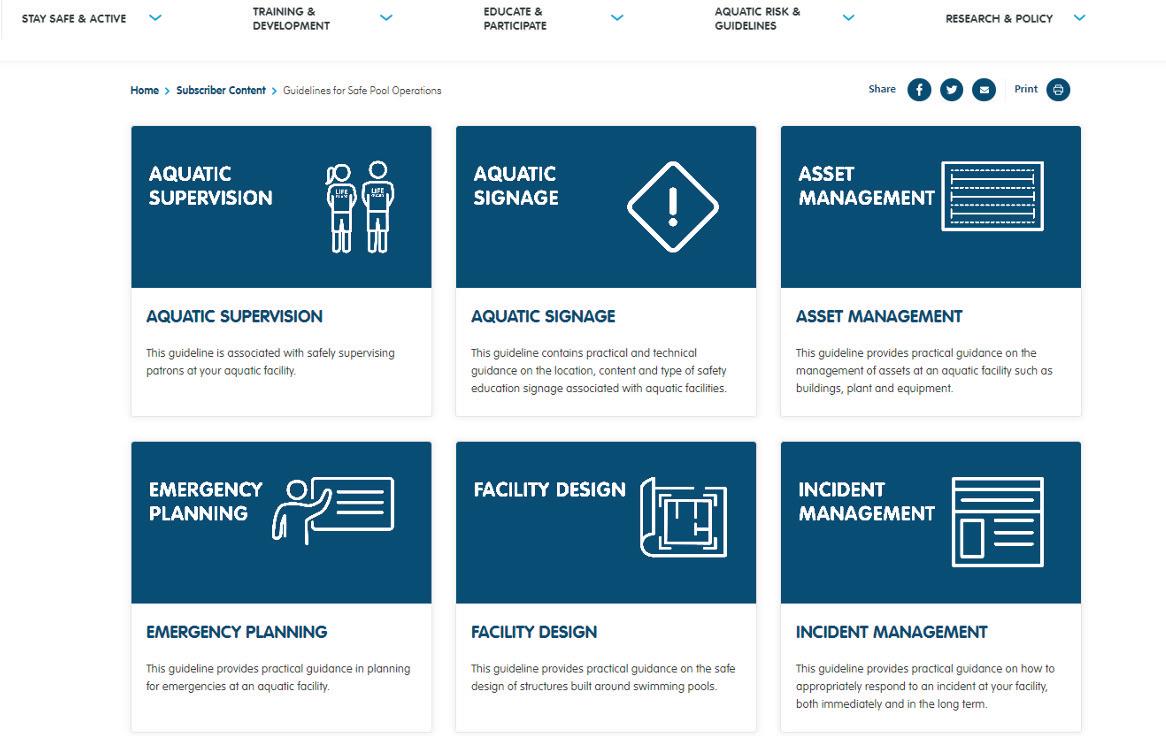
Over the course of the last three decades, the GSPO and AFSA have continued to evolve to incorporate more sophisticated standards, legislation, facilities, programs and community expectations. Now under the oversight and guidance of the National Aquatic Industry Committee, the Guidelines are as relevant as ever considering the impacts of the COVID-19 pandemic and an increasingly complex operating environment.
MORE ABOUT THE GUIDELINES AT: royallifesaving.com.au/GSPO
AQUATIC FACILITIES PITCHING IN TO HELP DURING THE FLOOD CRISIS
Over the course of the year, aquatic facilities have risen to meet the challenge of the flood disaster in Queensland and New South Wales, offering a safe haven for evacuees. While their contribution to health and wellbeing as a sport venue is well-recognised, less well known is the invaluable community role they play during disasters.
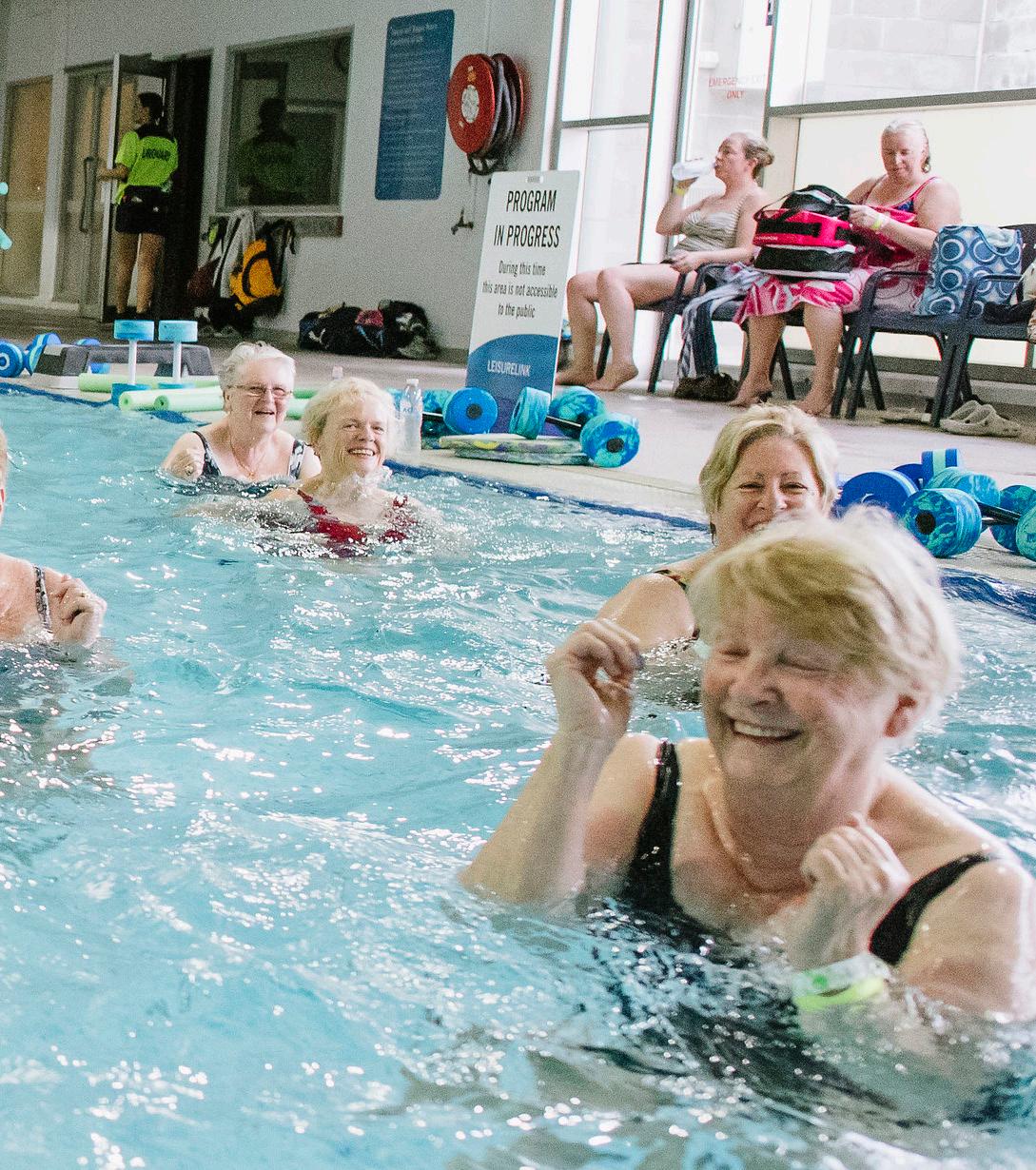
In the hardest hit areas aquatic facilities turned into evacuation centres. They offered more than just a safe place to sleep, with staff and volunteers supporting individuals and families as they come to terms with the traumatic events, including the loss of muchloved community members. This social and human infrastructure is critical to help pull communities through the crisis.
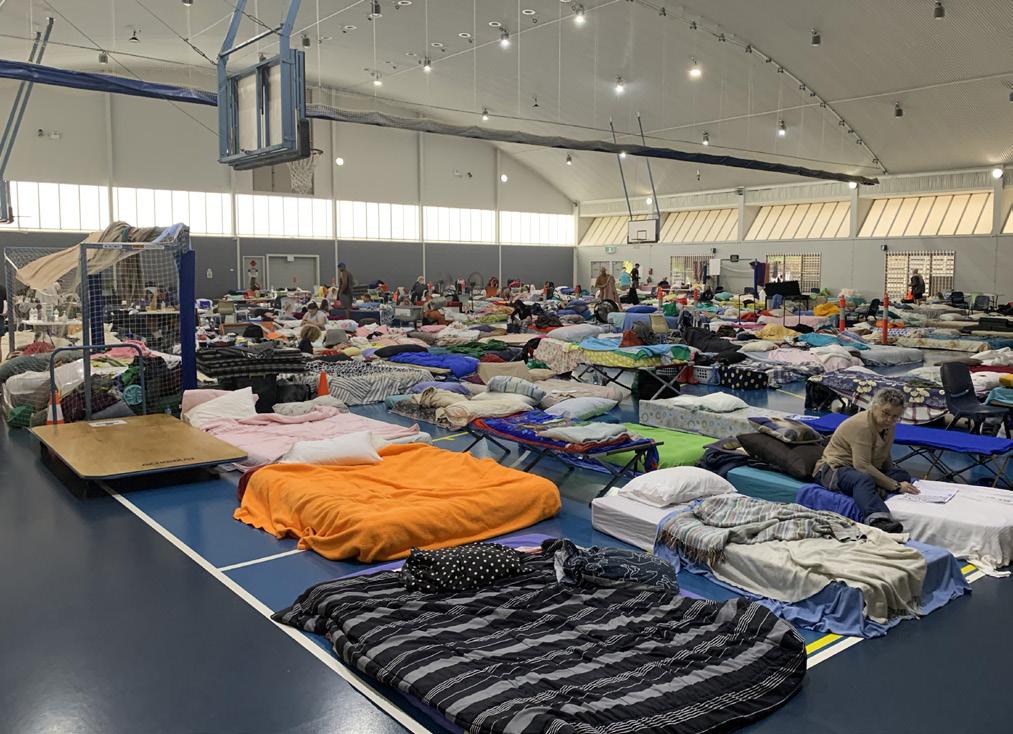
“For communities and an industry already battered by two and half years of smoke, fires, the COVID-19 pandemic, worker shortages and now another 100year flood event a decade after the last, this is another significant strain on the human and fiscal reserves needed to bounce back,” Royal Life Saving CEO Justin Scarr said.
“What is clear is that community infrastructure, like aquatic facilities, can play an important role in disaster risk reduction and community resilience. We acknowledge and thank the aquatic industry workers and volunteers who are supporting communities across the East Coast.”
Below: Goonellabah Sports & Aquatic Centre operating as an evacuation centre during the devastating Lismore floods
61
LEARN
AND AQUATIC FACILITY SAFETY ASSESSMENTS SIGNIFICANT
SOCIAL IMPACT OF THE NATIONAL AQUATIC INDUSTRY REPORT
Increased social cohesion and improved health and wellbeing are two of the main social benefits of the Australian aquatic industry, a report published by Royal Life Saving this year found.
The Social Impact of the National Aquatic Industry report was initiated by the Royal Life Saving Society – Australia and Swinburne University of Technology. The research looked at all levels of the industry, from small swim schools through to major aquatic and leisure facilities.

Royal Life Saving Chief Executive Officer Justin Scarr said the report included the four key elements of social impact infrastructure – people, places, policies and programs.
“Those benefits include health and wellbeing, increasing social connection, providing safe environments for swimming and education, facilitating social cohesion in communities and providing significant employment benefits,” Professor Sherry said.
“We identified that the social impact is created with and for community, as it is the local community that cocreates the social impacts in partnership with the aquatic facilities. The physical buildings themselves are often the least important aspect of the delivery of social impacts.”
Report contributor and Royal Life Saving’s National Manager – Aquatics, RJ Houston said although the report highlights the work aquatic facility designers, owners and operators are already doing, more work is needed to ensure the ongoing sustainability and viability of aquatic facilities in an increasingly competitive and changing social and economic landscape.
Professor Emma Sherry from the Sport Innovation Research Group at Swinburne University oversaw the research design, delivery, implementation, and reporting. Professor Sherry said the results of the research demonstrated that the aquatic industry provides significant social impacts for Australians.
“We know from both this report and our earlier work that while local pools compete for resources, they are worthwhile social investments for governments, communities and business owners. This report provides critical guidance as to how to maximise each pool’s social impact and therefore its relative resourcing attractiveness for policy makers,” Mr Houston said.
62
“Public pools mean more to communities now than just being a place to swim; for
many communities it is a central hub where people come together. The social impacts are much more diverse than has previously been appreciated,” Mr Scarr said.
READ THE REPORT royallifesaving.com.au/ socialimpactofaquaticindustry
The Australian Policy and Case Law for Public Safety in Inland Waterways: A Review and Recommendations found that consistent public safety standards including industry guidelines are needed to support a reduction in drownings inland waterways.
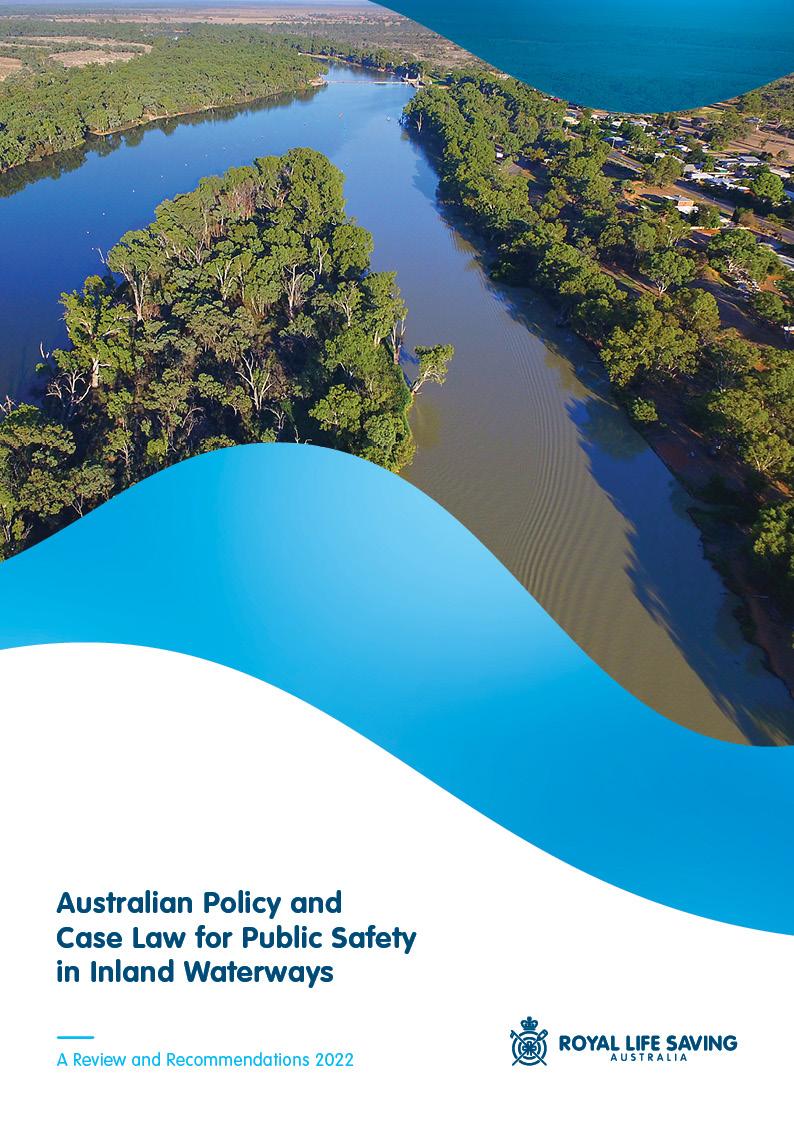
In the 10 years to June 2021, 940 Australians lost their lives to drowning in inland waterways, with 70 per cent of those deaths occurring in regional and remote locations. Almost three-quarters of those who drowned were not visitors to the area. More than half the drowning deaths occurred in rivers with the remainder occurring in creeks, lakes, and dams.
The report reviewed the policy and governance frameworks relating to inland waterways, ocean beaches and aquatic facilities and all Australian coronial and legal liability cases involving inland waterway safety. The analysis found that in the absence of objective standards, courts tended to make detailed recommendations for specific locations which at times were inconsistent. Nationally consistent standards would enhance safety.
While Royal Life Saving has researched inland waterway safety previously, these findings increase our understanding of some issues faced by coroners in determining what measures are reasonable and practicable to introduce in open water environments such as rivers. It highlights where policies and frameworks are needed to promote safety for all communities, especially inland communities adjacent to rivers.
Royal Life Saving is committed to working with communities, governments and waterway owners and operators to ensure any future frameworks are industrypractical and encourage improvements to water safety.
New draft safety guidelines for the ownership, management and use of inland waterways to reduce the likelihood of a drowning or serious aquatic injury have been released for public consultation by Royal Life Saving.
The guidelines have been developed following a decade of research into drowning incidents in Australia’s rivers, lakes, creeks, and other inland waterways, with more than 100 Australians noted to be drowning in inland waterways every year.
The guidelines provide practical guidance for facilitating inter-agency risk management planning and implementation, as well as practical steps for local government to take around swimming and recreation areas.
The guidelines emphasise risk management, the development of local water safety plans and community consultation. They also provide information on minimum water safety qualifications and training for employees as well as guidance on supervision ratios and similar requirements for users recreating and for providers of structured programs.
63
AUSTRALIAN POLICY AND CASE LAW FOR PUBLIC SAFETY IN INLAND WATERWAYS GUIDELINES FOR INLAND WATERWAYS READ THE REPORT royallifesaving.com.au/australian-policy-andcase-law-for-public-safety-in-inland-waterways KEY DATA (2009/10 TO 2018/19) TOP 3 ACTIVITIES 1,009 20% 19% 17% 101 Drowning deaths Swimming and recreating Fall Non-aquatic transport Average deaths per year
One of the key themes identified in the Australian Water Safety Strategy 2030 is for every community to development a Local Water Safety Plan.
A Local Water Safety Plan outlines existing and future community-based drowning prevention actions tailored to individual community contexts. The approach emphasises the role of evidence-based solutions, multisectoral collaboration and the capabilities and needs of varying stakeholders, including community and government organisations and vulnerable groups.


The benefits of developing local water safety plans include:
Preventing future drownings and saving lives.
Taking leadership on an important social, health and economic issue.
Reducing the negative social, health and economic impacts of drowning in your community.
Gaining local data and research into drowning issues and risk factors.
Understanding and profiling drowning issues and risk factors.
Facilitating a common understanding of local drowning and water safety issues specific to the region.
Developing stronger ties to community groups and like-minded agencies.
Spotlighting key research and data relevant to the area to interested parties and those with a responsibility for water safety.
Supporting a commitment to working together on a collective strategy for the region.
Working towards evidence-based solutions/actions that could be collated into a local water safety drowning prevention plan.
Demonstrating positive actions on drowning prevention in line with international and national frameworks.
In 2021-22, Royal Life Saving has been working to develop local water safety plans across the country, including in: Townsville, QLD Loddon Mallee, VIC Shepparton, VIC Bright, VIC Albury, NSW Kimberley, WA Western Sydney, NSW
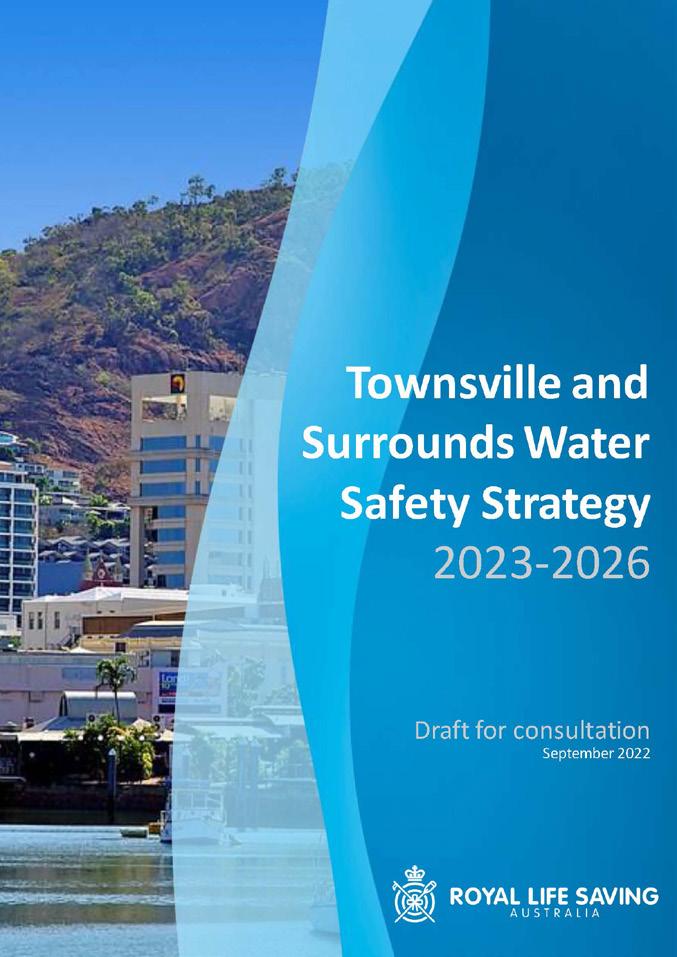
64 LOCAL WATER SAFETY PLANS LEARN MORE ABOUT LOCAL WATER SAFETY PLANS royallifesaving.com.au/localwatersafetyplan
It has been a particularly busy period for the National Aquatic Industry Committee, as the aquatic industry rebuilds.
The focus in the second half of 2021 was advocating the broader health social and economic benefits of the aquatic industry to remind policy makers of the impact the industry has in communities.
The committee also worked to assist facility owners and operators with a transition to safe operating in a post-vaccine ‘living with COVID-19’ Australia ahead of summer. In 2022, the committee reviewed the strategic direction of the committee and the Guidelines for Safe Pool Operations (GSPO) in light of the industry’s continuing recovery from the COVID-19 pandemic.
Royal Life Saving thanks committee members for their advice and counsel as well as the contribution of member organisations to the data and research processes.
Notable work from the year:
Updated COVID-19 safety guidance for re-opening aquatic facilities and vaccinating the workforce.
Updated CPR / Basic Life Support guidance for lifeguards operating in the ‘living with COVID’ stage of the pandemic.
Launch of WeSwim campaign.
Development of Child Safety Guidelines for aquatic industry.
Researching the state of aquatic industry infrastructure.
Researching the state of learn to swim ecosystem.
Changes to industry training packages.
Development of a single guideline for aquatic industry training and qualifications.
Considering drownings in hotel, motel, caravan park and other tourism / communal pools.
Key research activities: Adult Swimming Skills in Australia
Child Supervision Programs across the Aquatic Industry
The Law in Australia relating to Access and Equity for Aquatic Facilities
Drowning Prevention Strategies for Migrant Communities in Australia
A presentation on the Aquatic Industry Workforce Snapshot from 2022 Psychology of Lifeguarding –Lessons from VR Research
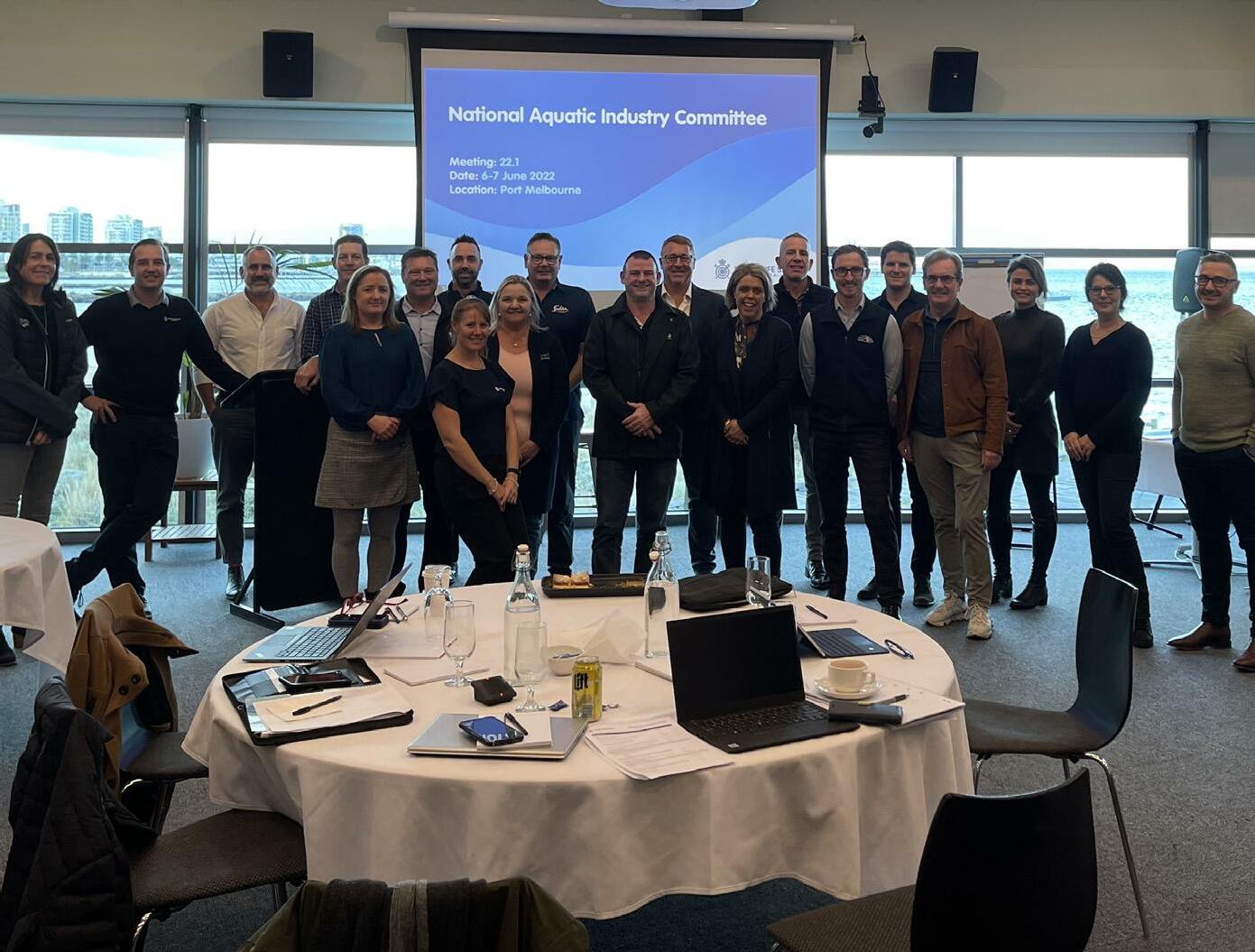
National Aquatic Industry Committee
RJ Houston - Royal Life Saving Society – Australia (Chair)
Kirin Lindop - Swimming Australia
Bradley Low - Australian Council for Swimming and Water Safety Teachers (AUSTSWIM)
Gary Toner - Australian Swim Coaches and Teachers Association (ASCTA)
Wayne Pollock - Australian Swim Schools Association (ASSA)
Kathy Parton - Aquatics and Recreation (ARV)
Stan Wall - Aquatic Recreation Institute (ARI)
Steve Good - Leisure Institute of Western Australia Aquatics (LIWA)
Lindsay McGrath - Swimming Pool and Spa Association Australia (SPASA)
Amanda Locke - City of Greater Geelong, VIC
Jake Boerema - City of Norwood, SA
Brad Page - Moreton Bay Regional Council, QLD
Matt Howes - Sunshine Coast Council, QLD
Liam O’Brien - Aligned Leisure
Joel Perricone – Bluefit
Liz Van Deventer - Belgravia Leisure
Mel Rahtz - YMCA NSW
Alexandra Ash - YMCA VIC
Alek Olszewski - Life Saving Victoria
Les Mole - Royal Life Saving Queensland Nick Au - Royal Life Saving New South Wales
Rebecca Gawne - Royal Life Saving Northern Territory
65
NATIONAL AQUATIC INDUSTRY COMMITTEE
Respect the River is a Royal Life Saving program of activities which operates in every State and Territory in Australia with the support of the Australian Government.
Australia has many beautiful inland waterways including rivers, lakes, dams, lagoons, channels and creeks however they can pose safety risks. It’s important to be aware of the dangers and always take care around water. Remember that water conditions which may have been suitable one day can change hourly with the current.
The focus on regional communities and reaching those most at risk of drowning continued this year, with activities taking place from the Ouse District in Tasmania, to Coober Pedy in South Australia, Tennant Creek in the Northern Territory, Gladstone in Queensland, and Frog Hollows in the Kimberley region of Western Australia.
Across Australia, hundreds of thousands of people engaged with the Respect the River campaign through face-to-face events, specialist training programs and water safety messages.
Queensland Queensland had a bumper year of activities for the Respect the River program, with 15 different projects focused on remote and regional communities, and local and rural schools.
More than 870 primary school students from 20 schools across Gold Coast, Ipswich, Brisbane and Sunshine Coast were taught First Aid and CPR awareness and provided them with the skills to help with an emergency situation. Students from Ipswich, Gladstone and Hayman Island took part in the Royal Rescuers School Program, which is specifically designed for regional and rural Queensland. In total, 1650 students completed the water safety class.
Reaching at-risk groups is a high priority of the program, and in the past year Royal Life Saving has delivered targeted programs for migrants and international students. Participants from all multicultural communities have been welcomed at programs in Ipswich and Kedron.
Northern Territory
Indigenous students from five remote communities participated in a three-day Swim and Survive Intensive Program in Tennant Creek. Following on from the intensive program, 122 students attended a swimming carnival at Tennant Creek Pool. Schools that attended were: Alekarenge, Canteen Creek, Murry Downs, Neutral Junction, Newcastle Waters, Rockhampton Downs, Tennant Creek Primary, Tennant Creek High & Ti Tree.
The classes with Katherine School of the Air students –some of the most isolated kids in the country – had to go online following a COVID-19 lockdown in Katherine. All students dressed up in their swim gear and talked everything water safety. Royal Life Saving also started an employment pathways program at the Alice Springs Aquatic Leisure Centre. Working with the CLONTALF Foundation (Alice Springs), local indigenous students were identified to take part in the program, which provides First Aid and Pool Lifeguard training qualifications, before progressing to employment. The first intake has successfully completed their qualifications, and a new intake is due for selection in September.
Across the wet season, Royal Life Saving also rolled out a new “if it’s flooded forget it” campaign using local talent and local waterways to reach vulnerable people via social media.
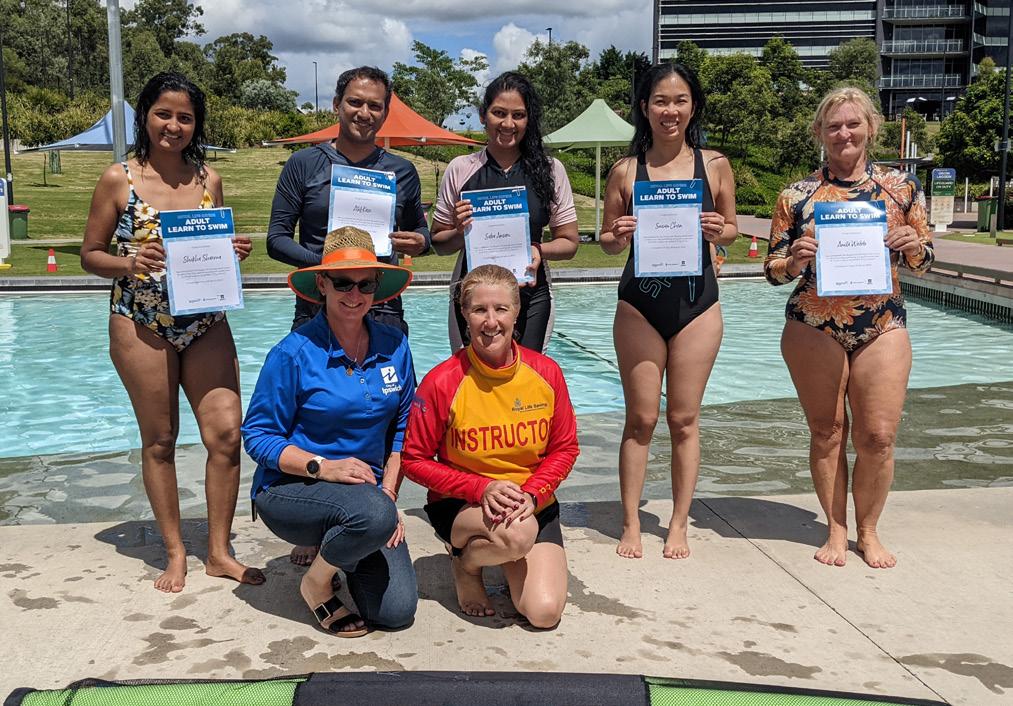

66 Highlights for 2021-2022 RESPECT THE RIVER
ACT
The “Ngadyung” Swim and Survive program continued thanks to the support of the Australian Government. Ngadyung was facilitated in both Northside and Southside locations with 331 enrolments for the year. Three participants graduated the program having met all requirements for the much sought after ‘Ngadyung Lifesaver’ award status. This benchmark matches the requirements within the National Swimming and Water Safety Framework for primary aged students.
South Australia
South Australia worked with communities in Berri, Ceduna and Coober Pedy to facilitate the development of local water safety plans. Royal Life Saving held a variety of workshops with stakeholders from each region, including council staff, emergency operations staff (government) and aquatic industry staff.
In Berri, the focus was the River Murray, which is a drowning blackspot. A Water Safety Day was scheduled in Paringa to raise community awareness.
It became clear that Ceduna and Coober Pedy both had an urgent need for a Swim and Survive program for three to 12-year-olds; in total, 120 Swim and Survive certificates were issued to children in these two areas.
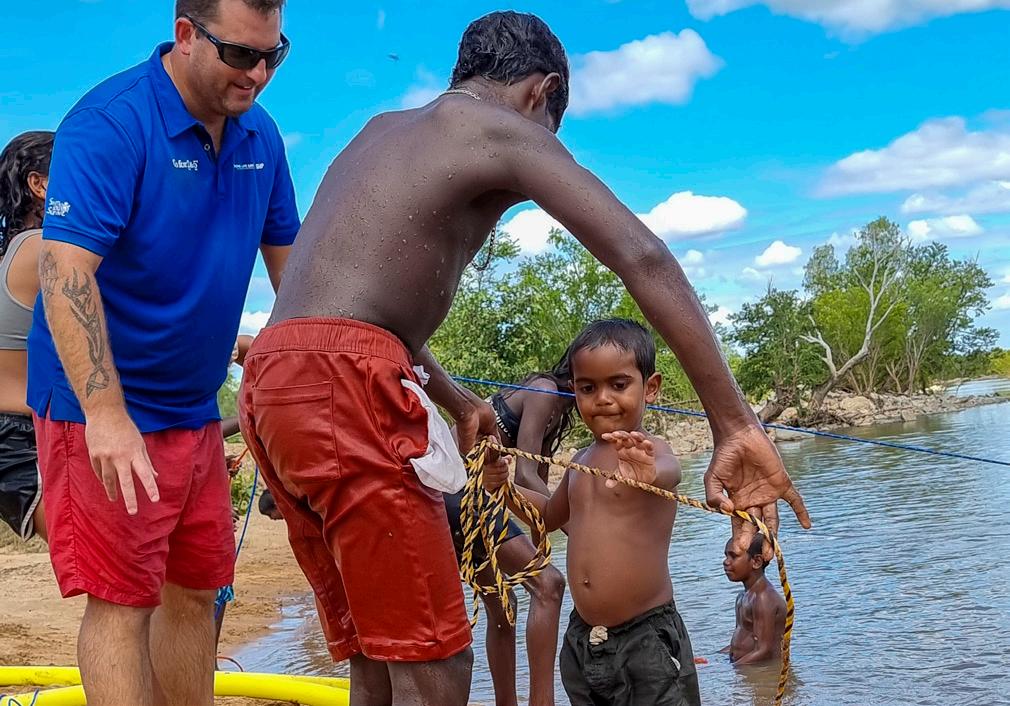
New South Wales
Royal Life Saving conducted a stakeholder mapping exercise and met with community and industry leaders to develop a project plan for the Western Sydney Drowning Area. The team conducted webinars with community leaders and groups.
With the assistance of the national office, NSW undertook research into the Western Sydney Region including social demographic details and a 10-year analysis of drowning in Western Sydney.
Victoria
Our first inland waterway forum held in April 2022 in Echuca Moama aimed to bring together key stakeholders to network, educate about managing waterway risk and showcase program delivery options and opportunities. Topics included inland waterway drowning data, the Victorian water safety strategy, water dangers as a community risk, regional success case studies and community activations. Participants included those managing community risk and emergency management, as well as local authorities and those working within the education and aquatic sport or recreation industries.
Western Australia
Royal Life Saving WA research shows that 50 per cent of children who fatally drowned in Western Australia were Aboriginal. These incidents were most likely to occur at inland waterways such as rivers, while participating in a range of aquatic activities including swimming, fishing and paddling.
The Aboriginal Swim and Survive and Bronze Medallion Inland Waterway Project targeted five regions and 12 local government areas/communities throughout Western Australia to deliver a Swim and Survive and extended Bronze Medallion programs tailored for Aboriginal children and youth. In total, 287 students achieved a variety of Bronze Rescue awards including the skills in the River Ready program. Programs were delivered in Warmun, Bow River, Frog Hollows, Collie, Manjedal Jarrahdale, Mt Magnet, Three Springs and Carnarvon.
Tasmania
Royal Life Saving Tasmania partnered with the Migrant Resource Centre/ Northern Tasmania and Scotch Oakburn College to provide Learn to Swim for 12 recently arrived migrant students, with 32 parents / carers also benefiting from the course. Students and their parents received guidance on where to swim in Launceston and surrounding areas, with a focus on Cataract Gorge where water levels can change without notice. Families learned how to identify and avoid aquatic risk.

67
ACT Western Australia
Organisational Cohesion and Growth

Royal Life Saving is continually building upon our 128-year history, our national network and our collective commitment to the Australian community.

Across Australia, our State and Territory Member Organisations have worked hard to help their communities recover from the disruption of COVID-19.

Whether it is increasing accessibility and inclusion for priority populations, partnering with community organisations or designing new courses to meet emerging challenges, all of our staff and volunteers have redoubled their efforts to prevent drowning in communities from Wilcannia to the Pilbara.
The resilience exhibited by community members and the aquatic industry after two years of significant disruption is evidenced throughout the reports from our State and Territory colleagues.
Whether working with regional and remote communities, people with disabilities, children in out of home care, multicultural and refugee populations or First Nations people our team are proud to have shared water safety messages and encouraged everyone in Australia to enjoy the water safely.

68


WORKING WITH REFUGEES AND ASYLUM SEEKERS
Fleeing conflict and persecution to forge a new life is a challenge most of us will never need to confront. But for refugees and asylum seekers who come to call Australia home, there is an additional challenge –learning how to be safe around our waterways.
Across Australia, Royal Life Saving is working with migrants, refugees and asylum seekers to share water safety knowledge and learn to swim classes.

Many of the participants have never swum in a pool or waterway and have no awareness of the hazards posed by currents, rips, submerged objects such as tree branches, and floodwaters.
Royal Life Saving delivers swimming and water safety programs across the country in partnership with community organisations and members that not only gives people the skills to help themselves and their families to safety enjoy the water, but provides opportunities for health, fitness and making friends in their new home.
For the staff of Royal Life Saving, one of joys of the programs offered across Australia is seeing the enjoyment of children and adults alike when they start learning to swim for the first time.
In Tasmania, a recent Royal Life Saving program involving children aged from six to 12 years old from Bhutan and Afghanistan was warmly received with the children delighting in their new-found skills.
That program was supported by the Migrant Resource Centre and Scotch Oakburn College.
In South Australia, the team work closely with The Multicultural Communities Council of South Australia, a settlement agency who facilitate programs for new and emerging communities.


70
Recently Royal Life Saving presented water safety lessons in a classroom setting to both the Tamil speaking and Ukraine communities.
In Western Australia, the Royal Life Saving team works with groups including the Ukrainian Association of WA and the Salsaal Association Australia providing water safety training. The need for support of Ukrainian refugees has grown significantly and further tailored programs are currently being developed.
In Queensland, the Aqua Safe Program is conducted in partnership with Brisbane City Council and Ethic Communities Council of Queensland. The Water Safety and Survival Skills works with community health workers so the core safety messages can then be shared widely.
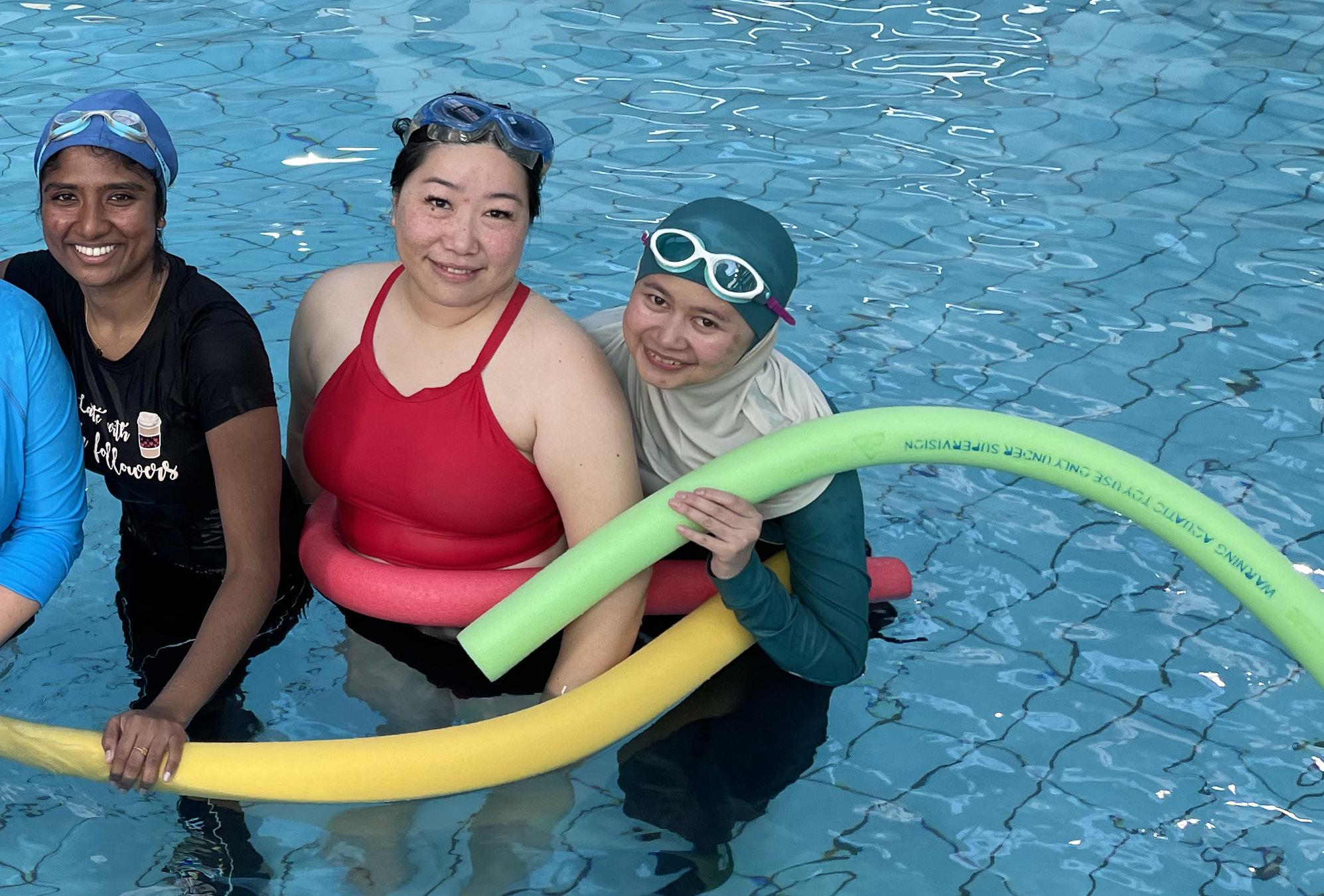
The training covers the dangers and hazards of a variety of Australian waterways, pool safety tips, boating and fishing water safety, CPR awareness and basic first aid. There is also an adult learn-to-swim program offered in partnership with Ipswich City Council.


The participants are taught the basics of safe entries into water, balance and buoyancy, kicking and paddling and floating and signalling for help.
These are just some of the ways Royal Life Saving works with refugee, asylum seeker and migrant communities across Australia.
71
Our goal is to help everyone enjoy the water safely. Royal Life Saving produces water safety information in a variety of languages.
YOU CAN DOWNLOAD FREE RESOURCES HERE:
royallifesaving.com.au/
multicultural
Australian Capital Territory
Swim 4 Life
Royal Life Saving ACT’s Swim 4 Life program was facilitated in January and April of 2022 falling just short of the participation target of 230 children. The program ran at two locations, Southside, and Northside, welcoming 195 total enrolments over the 2021/2022 project calendar year.
This program is attended by participants who are nominated by local community organisations and who are deemed to be ‘at risk of missing out’ on quality water safety education opportunities due to circumstances including financial hardship, cultural diversity, barriers related to trauma/fear, living out of home arrangements, and others. The program consists of eight pool-based lessons that focus on water familiarisation and personal aquatic skills, plus two outdoor lessons hosted at a local inland waterway where participants explore and learn about the risks, dangers, and model behaviours specific to the environment.

Refugee and Migrant Swimming Project
Local advocacy and volunteer group, the Refugee and Migrant Swimming Project, commenced delivery of a community Learn to Swim program in February 2022 involving 20 local adult refugee/ migrant participants. Royal Life Saving ACT assisted the Refugee and Migrant Swimming Project to connect with key stakeholders, obtain funding for delivery, and develop a suitable program with consideration given to participants’ previous experiences and perceptions. As part of the wholistic program, Royal Life Saving ACT facilitated a face-to-face workshop for program participants at local river swimming location – Pine Island in April 2022.
The workshop consisted of a CPR session plus a guided tour of the area. The participants were able to safely familiarise themselves with the river location, and learn about the hazards, risks and risky behaviours common to these environments. This workshop was particularly heartfelt given many of the attendees were friends and family of local Canberran student Najeeb Rafee, who tragically drowned in a river in 2020. The Refugee and Migrant Swimming Project was established in his legacy by his friends.
New South Wales
Community Club Support
Royal Life Saving received $200,000 support from community clubs. In partnership with 21 community clubs, Royal Life Saving NSW was able to provide arrange of swimming, water safety and lifesaving programs for children and communities in need to build greater resilience. More than 10,000 individuals participated in fully subsidised water safety, CPR, leadership and learn to swim programs. Initiatives primarily targeted communities in Western and South-Western Sydney.
Swim Teaching In Wilcannia

Making water safety accessible to people regardless of where they live is a priority. Royal Life Saving NSW Project Coordinator, Renee Amidy, travels frequently to remote areas to increase local communities to facilitate learn to swim programs. This year, she trained school teachers in Wilcannia to become qualified swim teachers.
“The teachers who have completed the Swim Teacher training can now conduct Learn to Swim lessons in their own town, as kids currently have to travel to Broken Hill for lessons which are 2.5 hours away,” Ms Amidy said. The course provided training to several key indigenous members of the Wilcannia Community. “It is our goal to assist in breaking down barriers to create more inclusive lessons that encourage young Indigenous students to participate in swimming and water safety lessons in their local pool,” she said.
Certificate III In Aquatics
After significant consultation with the aquatic sector and concerns related to industry skills shortages, Royal Life Saving NSW has implemented the Certificate III in Aquatics to provide future employees with a career pathway into senior roles. Over the last 12 months the sector has suffered a significant shortfall in skilled employees.
This skills shortage has left many operators without the staff they require to provide highly important services and programs, including learn to swim opportunities. The Certificate III in Aquatics is not only about obtaining a job but establishing a career. During 21-22, Royal Life Saving NSW enrolled 28 individuals into the qualification.
72
STATE AND TERRITORY MEMBER ORGANISATIONS: COMMUNITY ENGAGEMENT
Northern Territory
Royal Life Saving NT provided community benefit and services to 102,248 people across the Northern Territory, achieving our strategic goal of reaching more than 40 per cent of our population.
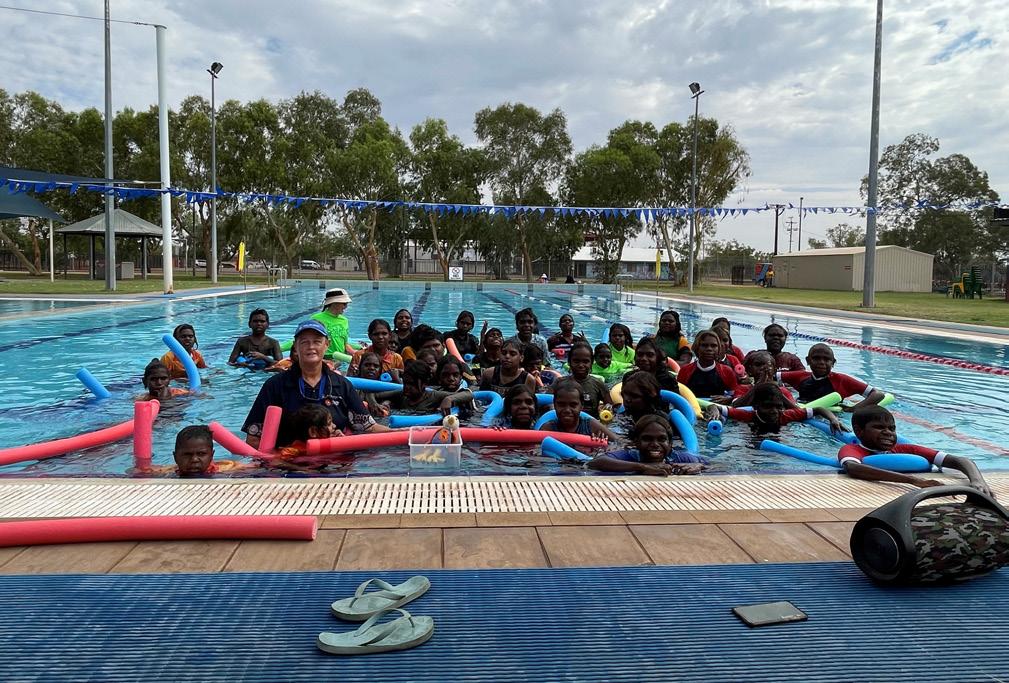
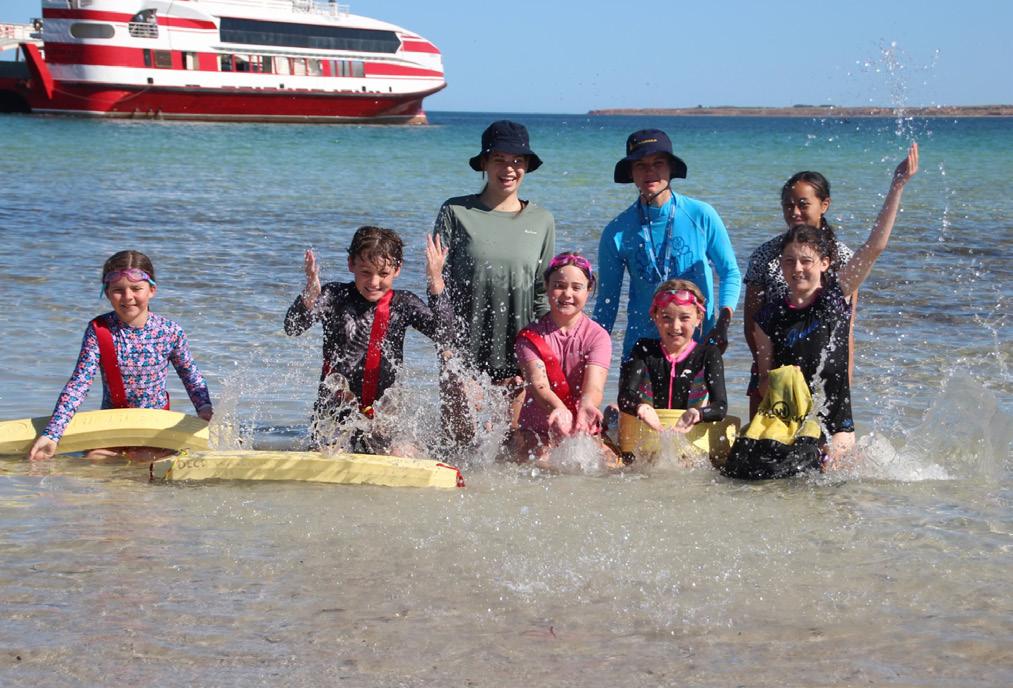
Water Safety Awareness Program
The Northern Territory Government funded Water Safety Awareness Program provides a fantastic opportunity for families to access free water safety lessons for their child. This year 2,009 enrolments were received with 13 providers operating across the Territory. More than 30,000 children have participated in this program since inception. The Government has extended the program with the Learn to Swim Vouchers and this has been positively received by families across the Northern Territory. The 15year evaluation of the program highlights the value of the program to our community and how it is making a real difference to drowning prevention.
To view full Annual Reports from State and Territory Member Organisations visit: RoyalLifeSaving.com.au
South Australia
Holiday Swim
Holiday Swim is a Royal Life Saving Society South Australia initiative bringing affordable and educational swimming and water safety lessons to pools and inland waterway locations across metropolitan and regional South Australia since the 1950s. The aim of the program is to teach children critical life saving skills and basic swimming skills, to equip them with the knowledge to stay safe in, on and around the water. Holiday Swim is the only seasonal water safety education program in South Australia to access the Swim and Survive program and is run across 40 locations throughout the December and January holidays. The program teaches children of all ages and abilities the essential skills for water safety and survival skills. We are proud to continue to reach families and communities that might otherwise miss out on the opportunity to participate in swimming lessons.
Remote Swim, Survive and Strive
Remote Swim, Survive and Strive, our Indigenous Advancement strategy had more than 1600 participants across 22 remote communities in the financial year. This includes 1028 students in remote locations with 194 achieving the national swimming and water safety benchmark of level six or above, a significant increase of 44 per cent. Almost 400 people were trained and qualified, with nine Indigenous people gaining employment as a direct result of the project.
Inclusive Swim
Our other highlight of the year was raising awareness of learn to swim options for children on the autism spectrum. Royal Life Saving SA is supporting Inclusive Swim, offering specialised one-on-one services in a calm environment. Swimming classes are offered to all ages, ranging from babies and children, to adults. All instructors are fully qualified and are understanding that every individual has different needs and requires various levels of support.
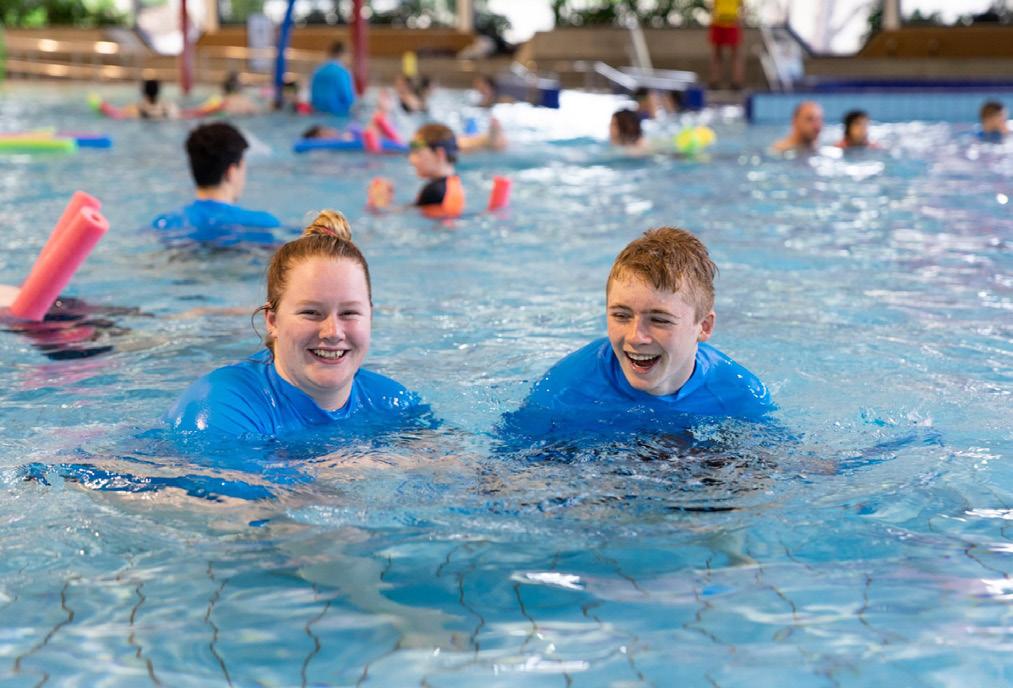
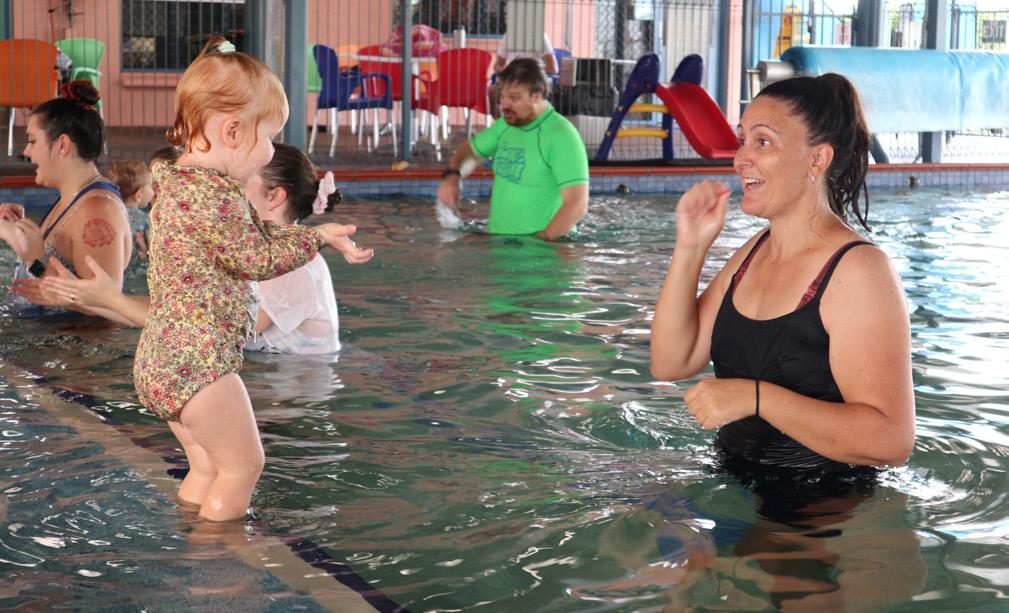
73
Tasmania
Aquatics Survival Program

A program to teach teenagers survival water techniques recorded its largest ever enrolment in Tasmania, with more than 100 year 7 students completing the course. The Aquatics Survival Program, run by Royal Life Saving Society –Tasmania, is offered to students at Parklands High School, Burnie with inland waterways funding from the Federal Government. With a rugged coastline, many of the teens choose to swim in the local rivers, creeks and dams. As tweens become teenagers they are more likely to get in the water without adults present. This program equips them to keep themselves safe, and to help their friends if they get into trouble. Over the 10 classes, they learn to look for currents and submerged objects in inland waterways, safe rescue techniques, managing rafts and putting on life jackets correctly, and survival strokes to conserve energy in an emergency.
Victoria Lifesaving Education

More than 700 scouts participated in lifesaving education programs incorporated into a Scouts Jamboree in January, while partnerships with the Campaspe Shire Council, Gurri Wanyarra Wellbeing Centre, Narrawong District Association, City of Greater Bendigo, Yarra Centre and Yarra Ranges Council, enabled a further 208 children to participate in regional programs. An activation at Lysterfield Lake, coordinated by Victoria Police also saw Life Saving Victoria and YMCA Casey Aquatic and Recreation Centre staff stationed at the lake on weekends and public holidays during the peak summer period to educate visitors about water safety. A partnership was also formed between Life Saving Victoria, YMCA Casey, Parks Victoria and Victoria Police to deliver the open water learning experience program to local schools, alongside their existing swimming programs.
Out of Home Care
Another highlight is the Out of Home Care program which is funded by the Tasmanian Government so children can access critical learn to swim classes. The package of 10 free lessons enables children living away from their parents can gain water safety skills in a safe and nurturing environment. This program has benefited hundreds of Tasmanian children over the years.


Mental Health First Aid
To meet growing community needs, Life Saving Victoria introduced mental health first aid training. With approximately 20 per cent of Australian adults experiencing common mental health problems each year, this course equips candidates with skills to provide initial support to other adults who may be experiencing a mental health problem or crisis.
Swim and Survive
Life Saving Victoria continued to work with our 130 Victorian Swim and Survive partners to ensure they converted to the new program and curriculum, which was implemented last year as part of the national Swim and Survive revitalisation project, led by Life Saving Victoria on behalf of Royal Life Saving Society –Australia. To date we have received positive feedback about the program and resources.
74
Queensland Water STAARS
Royal Life Saving Queensland launched the new Water STAARS (Support To Access Aquatic Recreational Spaces) Program. This program is a youth with a disability program, targeted towards individuals between 5-21 years of age with a disability. In partnership with Steps Pathways College, our 2022 program has been held on the shores of Bulcock Beach, Caloundra, with a focus on water and personal safety.
This initial partnership has aimed to drive disability participation, and allow many individuals who have not previously had the opportunity the chance to access these aquatic spaces in a safe and supportive manner. “It is through partnerships like this and support from the Sunshine Coast Council, Ithaca Life Saving Club and Queensland Fire and Emergency Services that we can continue to develop these disability programs and increase opportunities for youth with a disability to be part of this exciting program” said Beverley Newton, Royal Life Saving QLD Projects Officer.
Western Australia
New Swimwear Guides
Royal Life Saving WA has provided new women’s and men’s swimwear guides that present a variety of swimwear options inclusive of all members of Western Australia’s multicultural community. Many people who are new to swimming are often unfamiliar with the swimwear options that allow them to participate in all the aquatic activities Australia has to offer, whilst still maintaining modesty. These new resources provide swimmers with various options as well as a guide which indicates physical coverage, activities which can safely occur, and which level of swimming lessons each swimwear option would be suitable for.

Swim West
With funding from the Foundation for Rural Regional Development and the Queensland Government Community Drought Support Program Royal Life Saving QLD delivered its Swim West with VacSwim and Survive program in Winton and Boulia during January and March 2022. The program aimed to give more children the opportunity to access swimming lessons to enable them to reach the age-based benchmarks within the National Swimming and Water Safety Framework. We had 60 participants over the course of the program, with 25 lessons being conducted.
Keep Watch
Drowning remains the leading cause of preventable death for children under the age of five. Keep Watch parent ambassador Kylie Parker delivered one of our Keep Watch education sessions to parents at Centacare SNUGGLES parents’ group in her hometown of Geraldton. Kylie tragically lost her three-year-old son Jake to drowning in a back yard pool in 2019. She is bravely sharing her story and educating parents about drowning prevention as a way of honouring Jake’s life.

Pilbara Spirit Swimming and Lifesaving Carnival
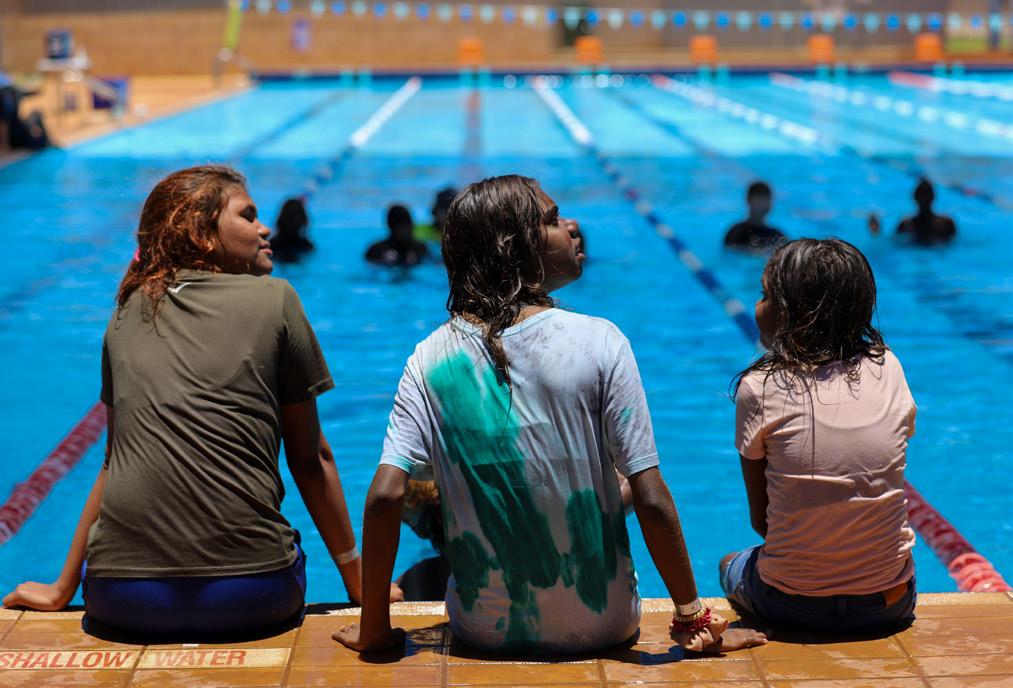
As Royal Life Saving WA works to address the overrepresentation of Aboriginal children in drowning statistics, we held our 7th Annual Pilbara Spirit Swimming and Lifesaving Carnival at the South Hedland Aquatic Centre. The carnival was part of a two-day Pilbara Aquatic Festival, thanks to funding provided by Principal Community Partner BHP, which also saw children and adults take part in a variety of activities including pool lifesaving development sessions for children and swim instructors. The Spirit Carnival is extremely popular with 100 children from nine different schools attending.
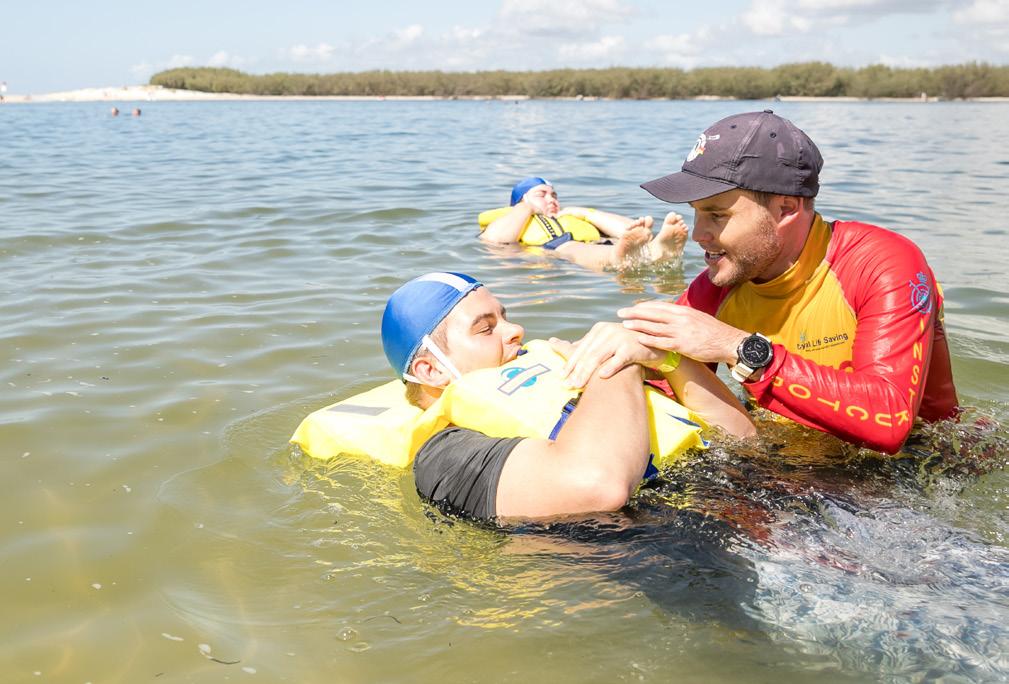
75
People and Culture
Our people are our most essential asset, they bring commitment, energy, skills and reach into communities across the nation. Investing in them, bringing clear purpose, the resources they need, building partnerships and fostering innovation, will all amplify their impact.
Recognising our valued members as part of the Australian and Commonwealth Honours and Awards.



MEMBERS

76
01 NEW LIFE MEMBER 43 LIFE

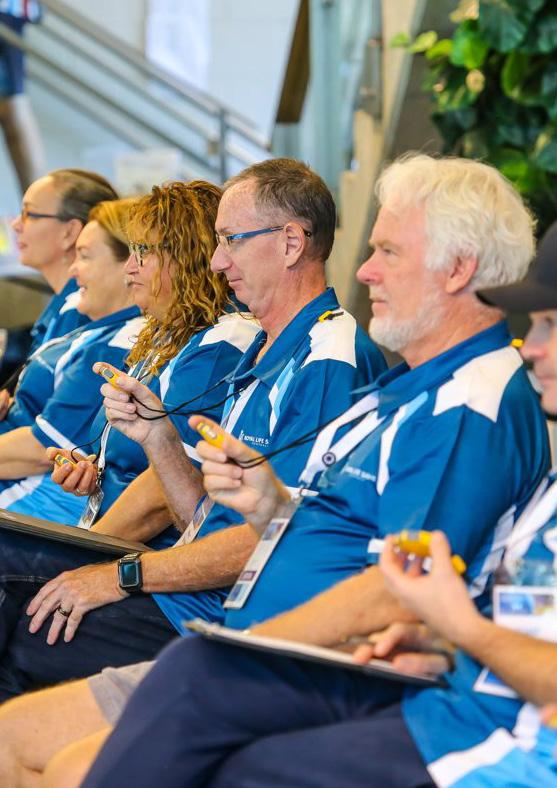
The passing of Her Majesty Queen Elizabeth II brings profound sadness to Royal Life Saving SocietyAustralia, our members and lifesavers across Australia.
We send our condolences to the Royal Family, and all our friends and colleagues across Britain and the Commonwealth, who feel her loss so deeply. We reflect with great admiration and eternal gratitude on her Patronage, and her deep commitment to our lifesaving mission.
From the joy of the Royal Life Saving Junior Respiration Award pinned proudly on her swimsuit at age 12, to her most recent presentation of honours to colleagues, and everything in between, her support has been deeply felt, much cherished and of great inspiration.
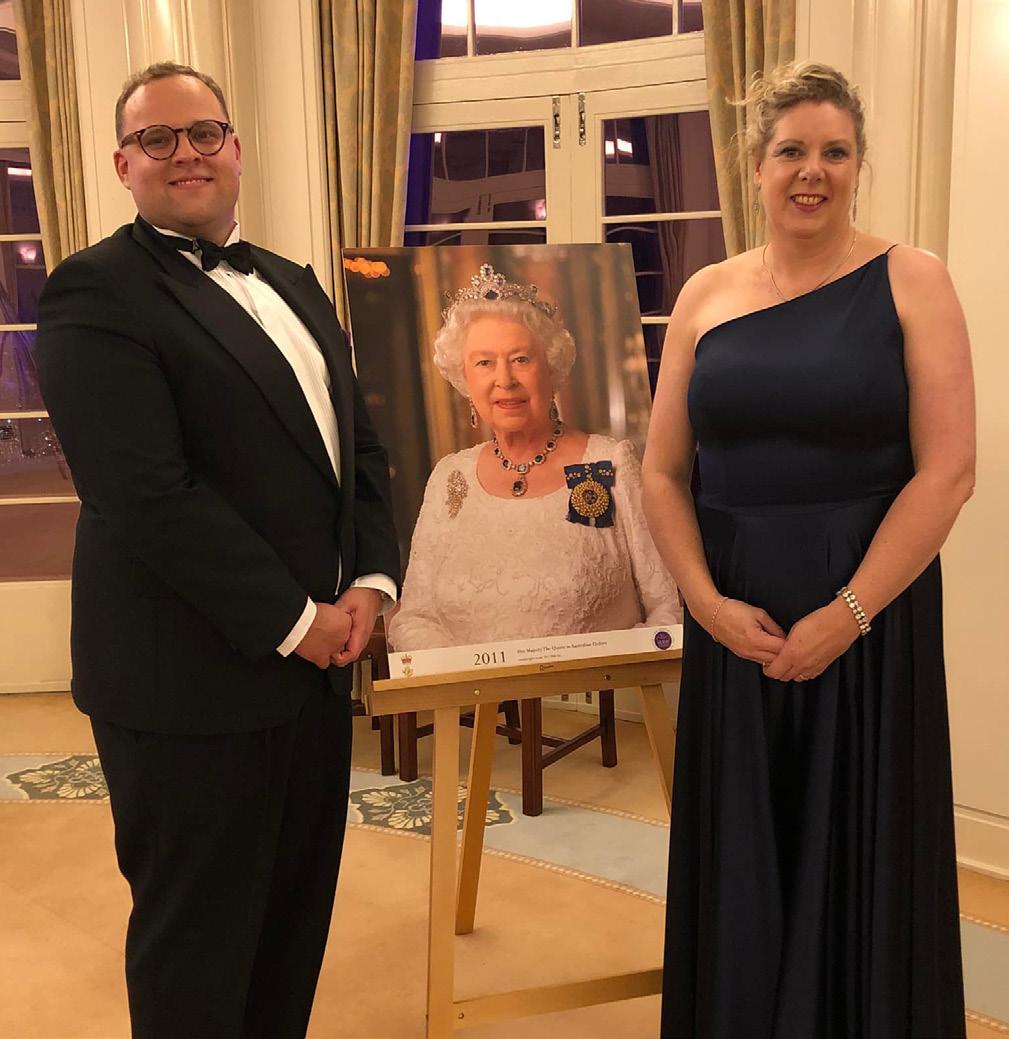
Rest In Peace.
PLATINUM JUBILEE
Dr Mitch Hartman, President of Royal Life Saving Society – Australia and Pene Snashall Commonwealth Trustee, Royal Life Saving Society joined Royal Life Saving Australia Patron His Excellency General the Honourable David Hurley AC DSC (Retd), GovernorGeneral of the Commonwealth of Australia and Her Excellency Mrs Linda Hurley at the Government House Platinum Jubilee Ball in celebration of Her Majesty The Queen’s Platinum Jubilee.
The event was an excellent networking opportunity – heaps of fun, great food and more than 140 Australians who have worked for the betterment of their communities across multiple industries and organisations. Yes, it was cold – Canberra in June and we were outside in a marquee - but the conversation and friendship was warming!
Current Royal Life Saving Australia President Dr Mitch Hartman said “Her Majesty Queen Elizabeth’s leadership is an inspiration to lifesavers all over Australia, and across the Commonwealth. Her deep and personal commitment to swimming and lifesaving, and her interest in the Society’s work encouraged so many towards community service”.
Ms Pene Snashall, Royal Life Saving Australia President (2015-2018) and RLS Commonwealth Trustee, who traveled to Buckingham Palace and met Her Majesty for the Society’s 125-year anniversary in 2015, reflected on her conversation with Her Majesty about the importance of developing lifesaving skills among regional communities.
“In our short conversation I recall that Queen Elizabeth II speaking about the vast space that is Australia, and her understanding that being away from the coast didn’t eliminate the dangers of drowning or the importance of swimming and lifesaving skills. She was quietly spoken and incredibly welcoming,” said Ms Snashall.
Professor John Pearn AO, Royal Life Saving Medical Adviser and long-standing child drowning advocate, was awarded the King Edward VII Cup in 2015, the Society’s highest honour. Professor Pearn reflected on Her Majesty’s integrity and the example of her leadership and service.
“Queen Elizabeth has been a tremendous role model for so many, and in so many walks of life. Her sense of service to others – is a core principle that underlies all our work. My wife Vena recalls speaking with the Queen like two grandmothers, sharing stories about her deep love for family. We send our condolences to her children, grandchildren and great grandchildren,” said Professor Pearn.

78 PASSING OF HER MAJESTY QUEEN ELIZABETH II
James McClelland BM OAM
Decades of dedication to his community and lifesaving by Royal Life Saving Society – Queensland member James ‘Jim’ McClelland BM has been recognised with a Medal of the Order of Australia in the Australia Day 2022 Honours List.
Since his initial involvement in 1971 as a member of the Ithaca-Caloundra City Life Saving Club, Mr McClelland has volunteered thousands of hours to the organisation as a lifesaver, historian and committee member.
Across his 60 years of service, his lifesaving skills have saved thousands of lives, with Mr McClelland volunteering more than 300 hours to patrols in the 2020-21 season alone.
Long-standing Royal Life Saving Queensland Board Member and President Mr Les Mole said Mr McClelland’s work has excelled across club, State and National levels.
“As well as being an active patrolling member on the Sunshine Coast, Jim is on the State Board of Directors, and the Honours and Finance Committees for the National Association,” Mr Mole said.
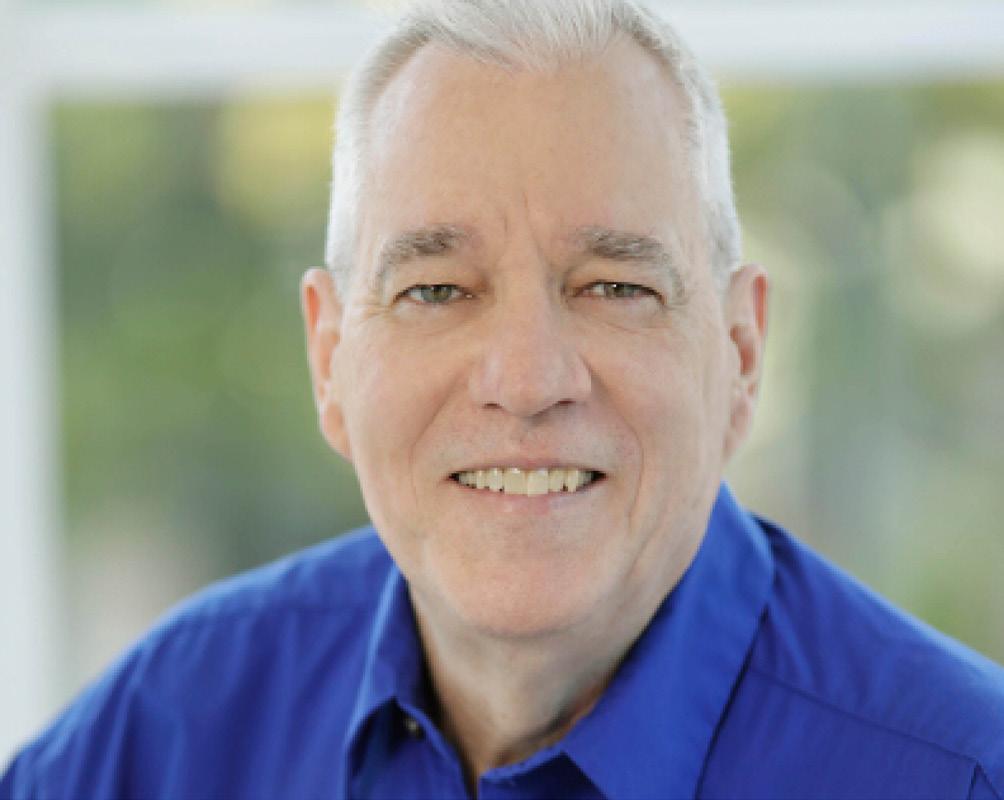
To celebrate the 125th anniversary of Royal Life Saving in Australia, Mr McClelland wrote and published two history books. He provided these books free of charge to libraries and has made the books freely downloadable online. At Commonwealth Level (RLSSCommonwealth), Mr McClelland has been a member of the Commonwealth Heritage Working Group since the group’s formation in 2017.
Royal Life Saving Society - Australia Chief Executive Officer, Justin Scarr said Mr McClelland exemplified the spirit of life saving.
“This honour is fitting recognition for the countless of hours of service he has given to his community. We are delighted to see his hard work and dedication recognised formally,” Mr Scarr said.
Floss Roberts AM
The Executive Director of Royal Life Saving SocietyNorthern Territory Annette ‘Floss’ Roberts has been appointed a Member of the Order of Australia for her dedication to lifesaving and water safety.
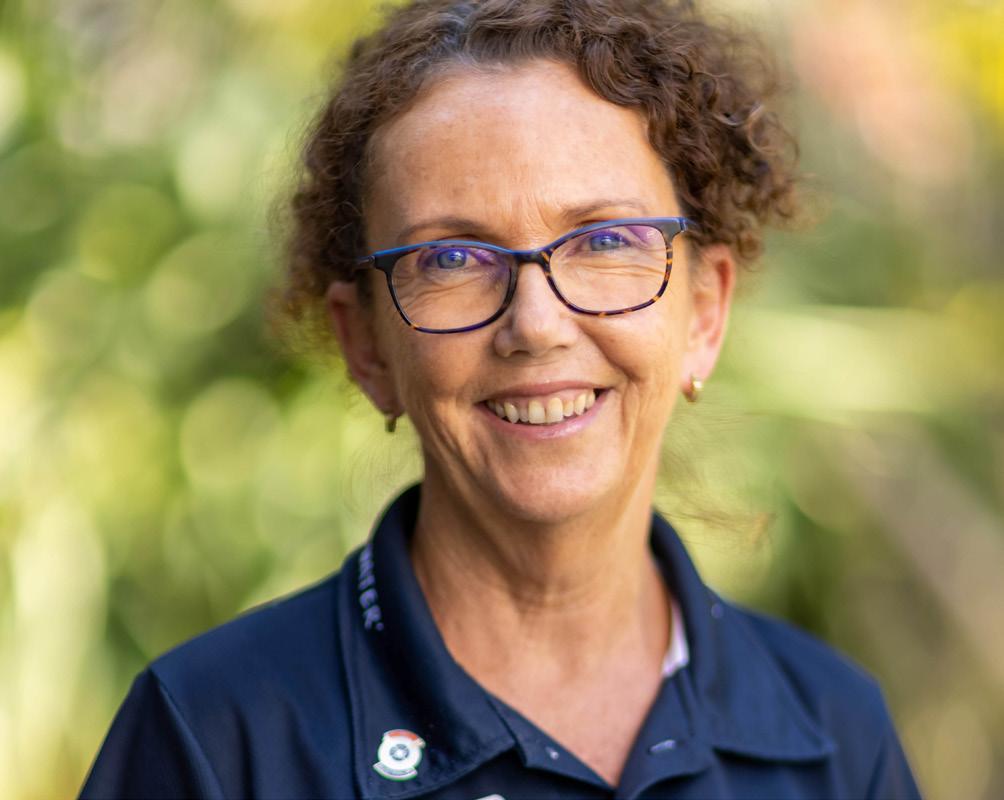
The award recognises Ms Roberts’s service to Royal Life Saving, the Northern Territory Water Safety Advisory Council and AUSTSWIM. Long-standing Northern Territory volunteer Daphne Read AO said under Ms Roberts’s administration Royal Life Saving NT has grown immensely, and NT communities far and wide have experienced Ms Robert’s deep commitment to helping them enjoy the water safely.
“I love what we do, how we do it and most importantly making people’s lives better by helping them become confident and capable around the water. Our Remote Swim, Survive and Strive program in 26 remote communities is so rewarding to be part of. There is still a lot of work to do in this space to help keep our 22 remote pools open,” Ms Roberts said.
Royal Life Saving Society – Australia Chief Executive Officer Justin Scarr said Floss was deeply committed to ensuring all Territorians have access to water safety education, skills and training.
“Her contribution to the development and provision of lifesaving, drowning prevention and water safety across the NT community has been substantial, impressive and in many respects peerless,” Mr Scarr said.
“Floss has worked successfully with communities, Government and many other stakeholders. In fact, Ms Roberts may have travelled further, on dusty roads, than anyone else in the name of lifesaving.
“Floss’s advocacy efforts have contributed to and sustained leading child drowning prevention programs, secured resources for remote indigenous swimming pools, and grown the teaching of swimming and water safety.”
AUSTRALIA DAY HONOURS 79
Paul Reynolds Honoured For Services To The ACT
Royal Life Saving Society – Australia board member

Detective Sergeant Paul Reynolds has been honoured for services to the ACT community, including his contribution to child water safety reform, with a 2022 ACT Community Protection Medal.
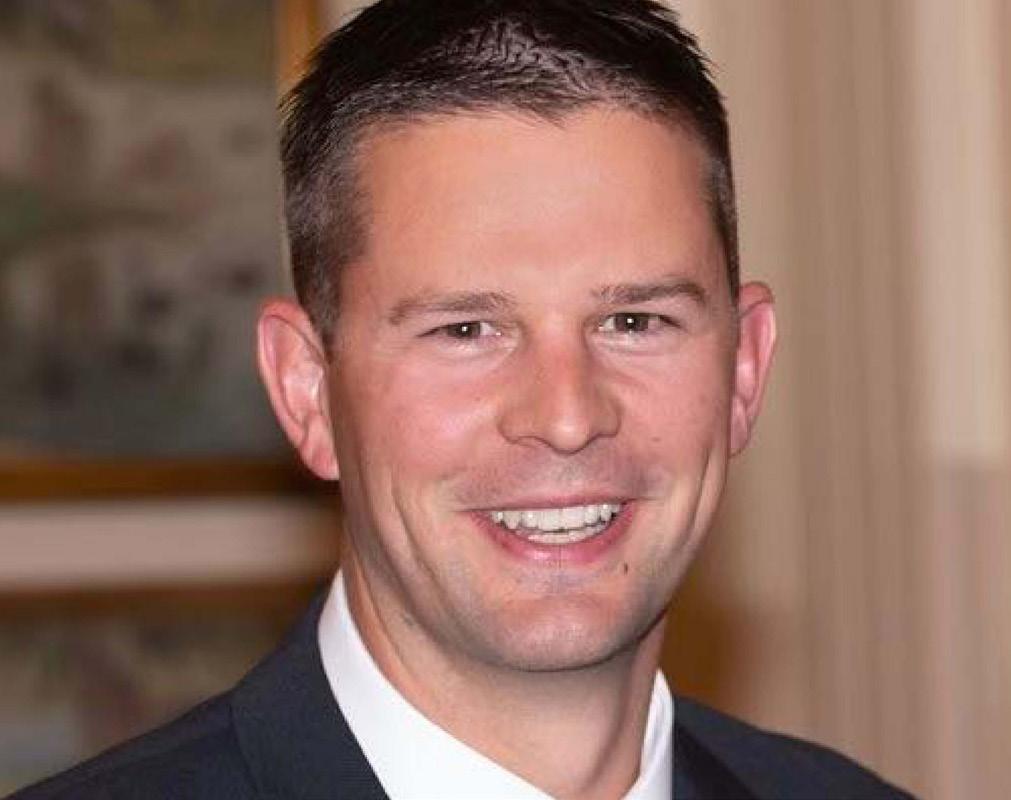
The medal, which was presented on Friday 18 March, recognises the Detective Sergeant’s efforts to reform backyard pool legislation after he was called to the drowning death of an infant in a backyard swimming pool in 2015.
Norman Farmer AM ESM
2022 King Edward VII Cup Recipient
Congratulations to Mr Norman Farmer AM ESM, who was named the 2022 recipient of the King Edward VII Cup for his contribution to drowning prevention in Australia and internationally.
In a career spanning more than 55 years, Mr Farmer started out volunteering at his local lifesaving clubs on Port Phillip Bay, which led to many years working in lifesaving development throughout Victoria for both Royal Life Saving and Surf Life Saving in the areas of governance, planning, technical and lifesaving sport, and he eventually went on to manage the Royal Life Saving National Lifesaving Team.
More recently, through his work as vice-president at the International Life Saving Federation, ILS AsiaPacific regional President and Executive Director of Royal Life Saving Society Commonwealth, Mr Farmer has been instrumental in developing a regional plans, lifesaving capacity building activities and in supporting the development of lifesaving organisations in low and middle-income countries.
Kevin Burrowes OAM
Appointed Life Member
Kevin Burrowes OAM has volunteered for Royal Life Saving in South Australia for the past 56 years. He served as a Member of South Australian State Branch Council and Board of Directors from 1966 to 2013. Most recently he was President of the South Australian Branch and a Board Member from 2018 to 2022.
In 2006 he was honoured with an Order of Australia Medal for long and excellent service to the Australian Community through Life Saving. In 2008, he was awarded a South Australia Special Citation for outstanding efforts in the promotion of the objectives of the Royal Life Saving Society. We congratulate Kevin on becoming a Life Member of the Royal Life Saving Society – Australia.
Norm has held several roles in lifesaving over many years, including with International Life Saving Federation (ILS), Royal Life Saving Society - Australia, Surf Life Saving Australia, Life Saving Victoria and at his local lifesaving clubs, Mordialloc Life Saving Club and Frankston Life Saving Club Inc. Norm’s service to Royal Life Saving and impact on lifesaving, water safety and drowning prevention over many years has been immense and he is a worthy recipient of the King Edward VII Cup.
80 HONOURS AND AWARDS
“When someone drowns, it devastates not just the immediate family of that one person. It’s like a stone into a pond, there is a ripple effect that echoes throughout the community.”
Royal Life Saving Society –Australia
Life Governors
2015 John McClelland AM (QLD)
2015 Alan B.Swinton OAM QPM (TAS)
2018 Daphne Read AO (NT)
Life Members
1995 Neville Bayfield OAM (NSW)
1995 Gerald Brameld OAM (QLD)
1998 Victor John Dennis (WA)
1998 Ian Mackie AM (NAT)
1998 Gwendolyn Welford BEM(C) (QLD)
1999 Alan B. Swinton OAM QPM (TAS)
2000 V.J Forde AM (SA)
2000 John McClelland AM (QLD)
2002 Heather MacGowan OAM (WA)
2004 Theresa Leopold (SA)
2004 Faye Trevor (SA)
2005 Lesley Bartlett (SA)
2005 Professor John Pearn AO RFD (QLD)
2005 Patricia Quick (SA)
2006 Jan Burton (SA)
2006 C Dedman (SA)
2006 David Dewar (SA)
2006 Raymond M Martin OAM (SA)
2006 Vincent McStraw (SA)
2006 Mark Needham (SA)
2006 Ann Price (SA)
2007 John Kew (SA)
2007 Hayden Lamshed (SA)
2007 Faye Milham (SA)
2008 Dorothy E Brown OAM (NSW)
2009 Rod Welford (QLD)
2010 The Hon.Terence Higgins AO QC (ACT)
2010 Dianne Montalto ESM (VIC)
2010 Barbara Morgan OAM (VIC)
2010 Karen Freak (SA)
2011 Robyn Pryce-Jones (TAS)
2013 Anne-Maree Gardiner AM (VIC)
2013 Gary W Kearney (TAS)
2013 Sandra Vander Pal (VIC)
2014 Les Mole JP (QLD)
2014 Daphne Read AO (NT)
2016 Ernita McGrath (NSW)
2016 Glenda Bowen Pain AM (SA)
2017 Dr Shayne Baker OAM (QLD)
2018 Tom Ballantyne (WA)
2019 Randall Cook (NT)
2020 Pam Neenan (NSW)
2021 Kevin Burrowes OAM (SA)
Past Presidents
1934-1951 Sir Thomas W White
1951-1977 Justice Percy Joske
1977-1979 Sir Percy Joske
1979-1987 Sir Basil Osborne CBE 1987-1994 Neville Bayfield OAM 1994-1997 Heather MacGowan OAM 1997-2003 Chief Justice Terence Higgins AO QC
2003-2009 Dr Shayne Baker OAM
2009-2011 Chief Justice Terence Higgins AO QC
2011-2012 Les Mole JP
2012 -2015 Dianne Montalto ESM
2015-2018 Penelope Snashall 2018-2021 Cameron Eglington
Royal Life Saving Society –Commonwealth
Honorary Life Governors
1977 Baden Pattinson (SA)
1981 W Blakeney (NSW)
1981 George Turnbull (NSW)
1984 Francis Henry (NSW)
1999 Kevin Burrowes OAM (SA)
1999 Barry Stanton (SA)
2004 John Kew (SA)
2004 Raymond M Martin OAM (SA)
2004 Ann Price (SA)
2011 Lesley Bartlett (SA)
2011 Theresa Leopold (SA)
2011 Patricia Quick (SA)
2011 Faye Trevor (SA)
2012 Alan B.Swinton OAM QPM (TAS)
Honorary Life Members
1977 Francis Henry (NSW)
1977 George Turnbull (NSW)
1983 P Margaret Stevens (VIC)
1988 Stanley Blanks (VIC)
1988 Cam Fitzgerald (VIC)
1990 Jack Farmer (VIC)
1993 James Burrowes (VIC)
1994 Norman Farmer AM ESM (Nat)
1995 Kevin Burrowes OAM (SA)
1995 Phillip Rice (VIC)
1995 Ken Southgate (QLD)
1995 Barry Stanton (SA)
1999 Dr Mervyn Allen (SA)
1999 John Coles (SA)
1999 V J Forde (SA)
1999 Raymond M Martin OAM (SA)
2000 John Kew (SA)
2000 G H Krueger (SA)
2000 Margaret Krueger (SA)
2001 Ann Price (SA)
2003 Gerald Brameld OAM (QLD)
2003 John McClelland AM (QLD)
2004 Bruce Campbell (QLD)
2004 Anita Eifler (WA)
2004 Ross Williams (QLD)
2005 Alan B.Swinton OAM QPM (TAS)
2006 Theresa Leopold (SA)
2006 Faye Trevor (SA)
2007 Lesley Bartlett (SA)
2007 Theresa Leopold (SA)
2007 Patricia Quick (SA)
2007 Faye Trevor (SA)
2008 David Dewar (SA)
2009 Barbara Morgan OAM (VIC)
2011 Faye Milham (SA)
2018 Anne-Maree Gardiner AM (Nat)
2018 Gary Kearney (TAS)
2020 Roz Grey OAM (NSW)
81
The National Board is the governing body of Royal Life Saving Society - Australia. Each State and Territory Member Organisation elects a Director to represent them. In addition, the Board has three Independent Directors. The National President and Deputy President are elected from the National Board membership to serve a one-year term of office. The National Board is responsible for the transparent, accountable governance of Royal Life Saving and for policy making and setting strategic direction.
Patron
His Excellency General the Honourable David Hurley AC DSC (Retd), Governor-General of the Commonwealth of Australia
National Board of Directors
DR. MITCHELL HARTMAN B Sc; MBBS; GAICD President
Mitch was appointed as an Independent Director to the Board in February 2018 and was elected as National President in October 2021.
PENELOPE SNASHALL B.Bus
Penelope was appointed as a Director in November 2013 by Royal Life Saving Society- Tasmania Branch. Pene concluded term as Deputy President in October 2021 and has remained as Director.
PAUL REYNOLDS
Paul was appointed as a Director in November 2019 by Royal Life Saving Society-Australia, Australian Capital Territory.
JIM WHITESIDE
Jim was appointed to the Board in October 2016 by Royal Life Saving Society of Australia, New South Wales.
ROD WELFORD
Rod was appointed as a Director in December 2019 by Royal Life Saving Society Queensland.
MARK SCOTT ESM
Mark was appointed as a Director in November 2019 by Royal Life Saving Society Australia, Victoria.
DAVID DEWAR PHF FACEL
David was appointed to the Board in November 2019 by Royal Life Saving Society Australia, South Australia.
JAMES SHERIDAN B.Bus, MTcchMgt (RiskMgt)
James was appointed as a Director in October 2021 by Royal Life Saving Society Australia, Northern Territory.
DR. ERICA DAVISON DEd, MSc, Post Grad Dip Hlth Promo, BEd, GAICD, FCHSM, CHE
Erica was appointed as a Director in March 2022 by Royal Life Saving Society, Western Australia.
PROF. RICHARD FRANKLIN PhD, FACTM, FPHAA, FAR Richard was appointed as an Independent Director to the Board in March 2022 by Royal Life Saving Society Australia National Board.
ALEXANDRA ASH MBA, GAICD Alexandra was appointed as an Independent Director to the Board in March 2022 by Royal Life Saving Society Australia National Board.
FRANCINE KINKADE BAcc; LLB (Hons)
Francine was appointed as an Independent Director to the Board in February 2018 and resigned in October 2021.
CAMERON EGLINGTON M Ed; B.P.E, Dip. Teach, PE. Cameron was appointed in June 2013 by Royal Life Saving Society, Western Australia. Concluded his term as President in October 2021, was elected to Deputy President in October 2021 and resigned in November 2021.
PENNY HART
Penny was appointed to the Board in March 2021, by Royal life Saving Society (Australia) Northern Territory Branch and resigned in October 2021.
Company Secretary
JUSTIN SCARR MBA B.Ed
Justin has been a senior executive for the past 23 years, and was appointed as Chief Executive Officer, and Company Secretary in January 2013.
82
GOVERNANCE
Royal Life Saving relies on the support of various committees and advisers. The committees span our areas of interest and enable us to capture the energy and enthusiasm of our network.
National Advisers
Dr Shayne Baker OAM - Education and Training
Geoff Grey - Sport Professor John Pearn AO RFD - Medical
National Finance and Audit Committee
Anthony Bandle (Chair)
Jim Whiteside
James McClelland BM OAM
Honours Committee
Roz Grey OAM (Chair) - NSW
Daphne Read AO - NT
James McClelland BM OAM - QLD Brione Rundle - SA
Dianne Montalto ESM - VIC Rhonda Groneman – National
CEO Working Group
Justin Scarr (Chair) - National Michael Ilinsky - NSW Floss Roberts AM - NT
Paul Barry - QLD
Jayne Minear - SA
Catherine Greaves - VIC Peter Leaversuch - WA
Sport Committee
Geoff Grey (Chair) - National Sport Adviser
Ben Fishburn - NSW
Joanne Teagle - VIC
Ben Jimmieson - QLD Kelly Maidment - SA
Andrew Ridley - WA Laura Withers - NT
Jake Smith - Athlete Representative
Jeannie Baxter-Reid - Coach Representative
Roz Grey OAM - Official Representative
Anni Gardiner - ILS/Commonwealth Delegate
Shayne Baker OAM - ALT Delegate
Training and Workforce Development Committee
Shaun Jackson (Chair) - National
Ben Cottee - NSW/TAS/ACT Floss Roberts and Rebecca Gawne - NT
Paul Barry and Nikki Thornhill - QLD
Jake Culkin and Michelle Williams - SA
Andy Dennis and Kevin Brabazon - VIC Ian Brown and Jacqui Byala - WA National Adviser - Dr Shayne Baker OAM
Education Committee
Penny Larsen (Chair) - National Thea Harrild - National (until Sept 22)
Louise Smalley - NSW, ACT, TAS
Renee Amidy - NSW, ACT, TAS (from July 22)
Stephen Gazzola - NT (until April 22)
Laura Withers - NT (from May 22)
Ben Jimmieson - QLD Michelle Williams - SA Michelle Ling - VIC (until March 22)
Jacqui Taylor - VIC Bree Forbes - VIC (from June 22) Trent Hotchkin - WA Amy Vearing - WA
Marketing and Communications Committee
Monique Sharp (Chair) - National Belinda Lawton - National Craig Roberts - NSW Louise Magee - NSW Floss Roberts - NT
Holly Jones - QLD Jessica Wozniak - VIC Paige Voss - VIC Laura Shack - WA Becca Osborn - WA Blanche Marchant - WA
83
ADVISERS AND COMMITTEES
International Life Saving Organisations Committee Membership
Justin Scarr
Drowning Prevention Commission Chair, ILS Asia-Pacific Secretary General
Professor John Pearn AO RFD Medical Committee
Dr Amy Peden and Stacey Pidgeon Drowning Prevention Commission
Dr Shayne Baker OAM Rescue Commission
Anne-Maree Gardiner AM and Jonnine Rowe Sport Commission
Caitlin Turner Sport Education and Sport For All Committees
Commonwealth Royal Life Saving Society Committee Membership Pene Snashall Board of Trustees
Anne-Maree Gardiner AM Portfolio Director Development through Sport
Caitlin Turner Roz Grey OAM Mary Veal Sport Development Committee
Dr Shayne Baker OAM Portfolio Director Capacity Building
Australian Lifesaving Team Penny Hodgers Collaborative Panel
Dr Shayne Baker OAM Chair of Selectors
Andrew Bowden Pool Coach
Rachel King Assistant Pool Coach
Chief Executive Officer Justin Scarr
Marketing and Events National Manager Marketing and Events Monique Sharp
Strategic Communications and Partnerships Belinda Lawton
Social Media and Digital Communications Officer Alex McGregor (to April 22)
Operations
National Manager – Aquatics RJ Houston
National Manager Training and Workforce Development Shaun Jackson
National Manager Education and Training Penny Larsen
Senior Project Officer – Aquatic Industry and Education Thea Harrild (to Sept 22)
Project Officer - IT Chris Groneman
Senior Project Officer –Lifesaving Sport and Development Caitlin Turner
Research and pPolicy National Manager Research and Policy Stacey Pidgeon
Principal Research and Policy Officer Alison Mahony
Senior Policy Officer – Aboriginal & Torres Strait Islander and Multicultural Communities Sahba Clara Delshad (to May 22)
Senior Project Officer – Research and Policy Dr Katrien Pickles
Senior Research Fellow Professor Richard Franklin Dr Amy Peden Dr John Lippman OAM
Finance and Administration National Manager Finance Linda Luu
Administration and Accounts Officer Sunny Fung
National Manager Finance (until September 2021) Management Support (from October 2021) Rhonda Groneman
84
INTERNATIONAL COMMITTEES NATIONAL OFFICE
FINANCIAL
The National Board of Directors for Royal Life Saving Society – Australia continues to maintain a sound and secure financial position.
STATEMENT OF COMPREHENSIVE INCOME for the year ended 30 June 2022
2022 2021
Revenue 4,901,501 3,869,614
Fundraising 35,000 124,570
Other Income 9,294 350,065
Total Income $4,945,795 $4,344,249
Expenses
Management and Administration expenses 642,855 609,087
Fundraising 35,000 77,254
Media Meeting and Promotional Expenses 780,882 528,326
Programs and Program Support 3,366,378 3,011,434
Amortisation and Depreciation 42,000 71,743
Total Expenses $4,867,115 $4,297,844
Total Comprehensive income attributable to the Members of RLSSA $78,680 $46,405
STATEMENT OF FINANCIAL POSITION as at 30 June 2022 2022 2021
CURRENT ASSETS
Cash 3,004,479 3,655,821 Receivables 97,850 224,944 Inventories 54,856 44,185 Other 43,779 32,235
TOTAL CURRENT ASSETS $3,200,964 $3,957,185
NON-CURRENT ASSETS
Property, plant and equipment 1,630,558 1,672,558
TOTAL NON-CURRENT ASSETS $1,630,558 $1,672,558
TOTAL ASSETS $4,831,522 $5,629,743
CURRENT LIABILITIES
Creditors and borrowings 2,161,843 2,672,739 Provisions 497,549 863,552
TOTAL CURRENT
NON CURRENT
Creditors and borrowings
TOTAL NON CURRENT
$2,659,392 $3,536,291
0
$0
TOTAL LIABILITIES $2,659,392 $3,536,291
NET
RETAINED FUNDS
$2,172,130 $2,093,452
Retained surplus 1,636,356 1,557,676 Asset revaluation reserve 535,776 535,776
TOTAL RETAINED FUNDS $2,172,132 $2,093,452
of the audited financial statements for Royal Life Saving Society – Australia are available upon request.
85
LIABILITIES
LIABILITIES
0
LIABILITIES $0
ASSETS
A copy
SUMMARY
Royal Life Saving Society – Australia would like to thank the following organisations for their continued support.

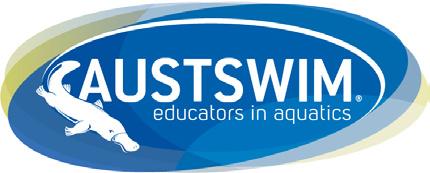


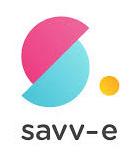

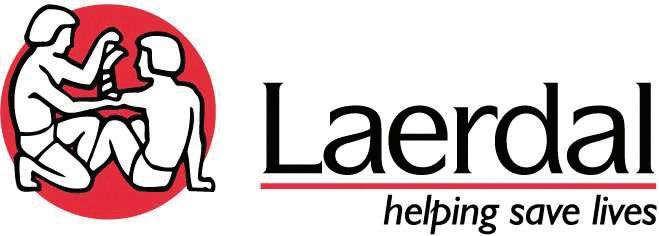

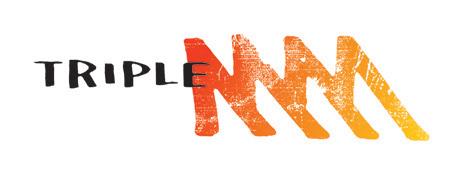


86 Australian Government Corporate Sponsors Industry Partners Other Supporters Media Partners
OUR PARTNERS


FOR MORE INFORMATION Call 02 8217 3111 Email info@rlssa.org.au CONNECT WITH US RoyalLifeSaving RoyalLifeSaving RoyalLifeSaving RoyalLifeSavingAust RoyalLifeSaving.com.au















































































































































































































































